Text
The Finger that Points to the Moon...
I haven’t posted anything on here for over a year.
Why?
Well, I guess I lost some motivation. There have been ups and downs. The ups are hard to write about because they feel like they are beyond language, beyond reason even. I have lost faith in my ability to convey them. Zen would say, ‘The finger that points to the moon is not the moon.’ Words are pointers, and the gap feels wider than it was before.
Poetry, haikus, koans, riddles… maybe these are more effective ways of expressing something of the experience. Or music. Or maybe there is a style of narrative prose that can convey it without directly aiming at it. I think that’s possible, but I haven’t found it yet.
The downs are what they always were, though I am more aware of them now. I think I can sum up everything I have learnt about my inner life in four points:
1. I am aware that I suffer. There are days when I am inexplicably tense, irritable, frustrated, sad, lacking kindness and generosity. That is suffering.
2. I have come to realise that the cause is not outside myself. I cannot blame my suffering on other people, on a place, on my material situation. Even if I could adjust those aspects in any way I wished, I would still suffer, I would just do so in more luxurious surroundings, and in the company of saints and supermodels (could Mr. Venn find an AnB here?).
But although the suffering is internal, that does not necessarily mean that it is my fault. This is perhaps the most surprising thing I have learnt. It could be an inherited ancestral burden, or the manifestation of collective trauma from the past (which affects both victims and perpetrators). Or even, further back, because of the Fall – no literal geographical garden of Eden, but a slow divergence from our original divine nature.
3. I realise that the primary (though unconscious) purpose of many of the things I used to do was to distract myself from that suffering. I am thinking of entertainment in all its many forms, exercise, being busy, socialising, buying or owning things, drinking, taking risks, taking drugs. Even helping others can serve that purpose.
4. Based on the cracks of light around the door of my own experience, I am confident that there is a way out, and it is codified in the practices and methodologies of the world’s tried and tested religions and spiritual traditions. You don’t have to pick one. If you are open to it, which will happen when you are really fed up of suffering, then one of them will pick you. It’s a bit like the sorting hat in Harry Potter.
This doesn’t mean that you will never suffer again, but you can change your relationship to suffering, and thereby cease to create it or contribute to it.
Those, I guess, are my four Noble Truths. In the meantime, I have been doing more painting than writing. This one is from the island of Paros in the Cyclades:
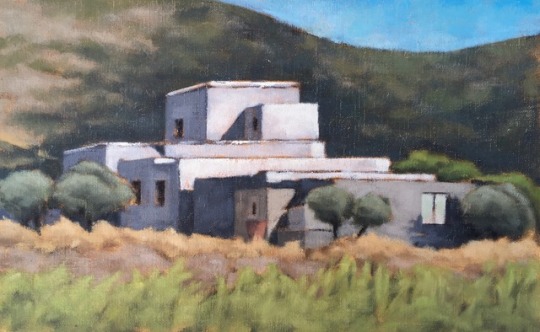
0 notes
Text
‘Be careful what you wish for...
…because it may come true.’ This saying has always perplexed me. Surely we want our wishes to come true? (So long as we wish wisely, that is). Who would willingly choose to be in an indefinite state of wanting? But I think I understand it a bit better now.
In my last post, I mentioned how I had felt restless upon returning to Athens last autumn. I visited Mount Athos for the first time in October, and that was an oasis of calm, but it also gave me plenty to think about. Maybe the peacefulness of the monasteries made me see things more clearly: back in Athens once again, my restlessness was all the more evident. And not just a restlessness, but an underlying malaise, an impatience, a sense that things were not quite right.
I was also able to recognise that this restlessness is something I have felt all my adult life. In the past, I have deployed a toolkit of strategies to avoid confronting it. Strategies such as intense exercise, or alcohol and socialising, or pursuing girls, or drugs, or (more long term), changing jobs, or moving from one country to another.
In the past, I have always blamed my restlessness on something outside myself. But now I live in a city I love, surrounded by people whose values resonate with my own, in a beautiful country, and my main occupation is one I have chosen freely, and that I often find deeply rewarding. And so I have to face the fact that the malaise stems from within.
So now I understand the saying, ‘Be careful what you wish for because it may come true.’ If it does come true, and you are still not happy, or at peace, then a very unflattering mirror is held up to you; you are forced to confront your own dysfunction.
One aspect of getting older is that patterns in your life become more obvious. When you are in your 20s and a situation occurs for the second or third time, it is still easy to blame the outside world. But when you are in your 40s, and you recognise that certain situations keep repeating themselves, you are forced to confront the fact that you may be creating them, or at the very least contributing to them. The disadvantage of this is that you lose the pleasing illusion of your own blamelessness; the advantage is that you now have the opportunity to change things.
Reading back over what I have written, it all sounds so clear and logical. But that’s not how it was at the time. Initially, I attempted to deploy the toolkit described above. But my lower back was still hurting, so I couldn’t escape from the malaise through sport and exercise. I went out at night, but the hangovers have become too painful. One night I stopped by the addicts in the park and bought some more of the local version of crystal meth. I felt great for 24 hours, and then predictably and deservedly terrible for a week. A girl I liked disappeared without a trace, and a subsequent perfunctory encounter left me feeling very empty. And only then did I fully understand: I need to address this, or I will never feel peace, and it will end up killing me, one way or another.
Last summer I had met a friend’s brother-in-law at a wedding. He claimed to work with plant spirits, and to channel their energies – from his home in Portugal - in order to perform healings; all he needs is a photo in which he can see your eyes. A few days before New Year he got in touch, casually, to say hello and ask how I was. I told him that I was at a low ebb, so he offered to perform a plant spirit healing. I felt I had nothing to lose, and that is why, on the morning of the 31st December, I was lying on the floor of my darkened apartment in Athens, listening to his Spotify playlist on my headphones, while sage leaves smoldered in the ashtray and my new friend in Portugal harnessed the spirits of his helper plants and sent them my way.
Did the plant spirit healing help? It is hard to say. Now, half a year later, I feel like a different person, with a new lease of life. But of course this is not a control experiment, and that might have happened anyway.
On the morning of the healing, back in December, I spent a couple of hours in a written whatsapp conversation with the plant spirit healer, for him to get to know me a bit better. It was a sort of diagnostic interview, with some very direct questions on his part. But he made some insightful comments and I found it genuinely therapeutic.
I admitted to the healer that I felt a lot of guilt about my own unhappiness. I am sympathetic to the suffering of all those who have been dealt a rough hand by life, but in my own case, is it not just the privileged self-indulgence of those who have nothing better to do? I have been blessed with loving parents, a good education, material means, and some mental capacity. With all of these advantages, how can I justify feeling miserable? Should I not be using them in some productive way, to create a better world?
The truth, of course, is that I have been trying in a modest way to do that for 20 years, and yet the malaise has always been there.
The healer’s response was a reframe that had the satori-inducing effect of the most striking koan: the crime is not to feel miserable despite worldly advantages. The crime would be if you failed to use those advantages to address and resolve your misery. It is possible that my soul was incarnated in this body, at this time and in this place, specifically because it provides me with the opportunity, the means, the capacity, and the precise challenges that I need for my own spiritual evolution. This is my fate, and I can embrace it and thereby progress on the only path that matters, or I can continue to try to fight it.
Another reason not to compound my malaise with guilt, the healer pointed out, is because our blockages are not entirely of our own making. This is the meaning of ‘inherited trauma’. Trauma does not need to be acute or dramatic or PTSD-inducing; it can refer to any form of malaise, unhappiness, discontent, frustration, mental suffering. It can run in families as well as in genders and races. My father’s depression and alcoholism will have affected me, as will the fact that my mother never had a relationship with her own father, and never introduced us to him while he was still alive. She never talks about it, but there must be a lot of sadness bound up with that relationship, and that sadness gets passed on. It gets passed on because your parents are the templates you inevitably copy, and also because it creates the emotional energy field in which you grow up. But it is important to remember that most parents do their best, and that their blockages and traumas have come from their own parents, and so on back up the generations. But if we don’t want to keep passing them on to following generations, then we have to commit to confronting them and dissolving them in our own lives.
The healer went on to mention a related but more mysterious concept: the shamanic 7 generational principle of ancestral healing. What we do in this life can, apparently, affect 7 generations of ancestors. When there is a lot of dysfunction in a family, it may fall to us to address that. The healer referred to it as ‘taking a hit for the team’. It sounded farfetched, even by my standards, but thinking back over the history of my family, it struck me that the lucrative forging of weapons over generations is unlikely to be karma-neutral (irrespective of attempts to offset it with workers’ welfare programs). I wrote a novel motivated by my desire to explore (and ultimately reject) the notion of inherited guilt, so this does not sit particularly well with me. And I certainly don’t think of myself as some sort of chosen one. However, I have long since ceased to dismiss things out of hand just because I don’t fully understand them.
To return to my darkened apartment on the 31st December: I listened to the playlist, trying to be receptive to the energy of beneficent plant spirits, and felt… not a lot. Although, I must say that over the next few days I felt more positive than I had done for a long time. But that may have been due to being less hungover than most in the early days of January.
They were cold, wet days in Athens, and I spent them ensconced in a few cafés, reading an author whose words resonated with the clarity of the finest Zen singing bowl. He is an author I had first heard of about a decade ago, but at the time I had dismissed him without reading him. I was wary of his popularity and hype; he seemed liked the worst kind of self-help guru. Back then I was a doctoral student in psychology, and I had no time for someone I assumed was a purveyor of ersatz spirituality. His name is Eckhart Tolle, and how wrong I was. And how arrogant. In January I read ‘A New Earth’, carefully, twice. It was a epiphany: he expresses so much that feels intuitively true, but which I have not yet experienced deeply enough for me to be able to live my life through the lens of that understanding.
His description of the collective dysfunction of the ego struck a particular chord. I remembered the pony-tailed South African shaman in Peru who, having fed me a glass of the noxious San Pedro cactus hallucinogen, told me to let go of my ego. It is not that I am particularly full of myself, or selfish, or ego-centric. Rather, like the rest of our Western culture, I have fallen into the trap of identifying completely with my thoughts and feelings, my likes and dislikes. I seek my sense of self through the things I possess and the way I appear to others, and I have lost my sense of who I am beyond that, which is what we all are: undifferentiated awareness, the universe becoming conscious of itself, and an expression of the divine. But read Tolle, or the Upanishads, or even (without blinkers) the Bible; they contain the same message, in different terminology.
If you look to the ego for your sense of identity, you are on a very unsteady footing. Talents, possessions, achievements, reputation; these are all fleeting. But if your sense of identity, of core self, is dependent upon them, it means that every time you lose something, or something doesn’t go your way, or you feel slighted, or that you have failed in some sense, then your identity is threatened. And that, from the ego’s perspective, is the very worst thing that can happen. It is enough to make daily life a constant nightmare, and that is what so many adults’ faces express.
Perhaps, if you read this blog, you might look at my life and think that I have lived it on my own terms. You might wonder why I write so much about ego, when the choices I have made seem motivated by an authentic search (at least I hope they do), rather than by the desire to acquire possessions or power or fame. And, on the surface, that is indeed the case. When I am by myself, in the places I love, I feel the authenticity of those choices, and a calmness can grow out of it. However, when exposed to places and situations where those values are not evident – hectic materialistic cities, ambitious and worldly people – then my confidence gets rattled and, on a deep and mostly unconscious level, self-doubt will spread its probing tentacles.
The area in which this happens most frequently, and most painfully, is in my relationship with my parents. On the surface, they have been faultless in always encouraging me to follow my heart, and never trying to force me to follow a path that would not have felt true. But that is on the surface. On a deeper level, I think I have sensed their unexpressed desire for me to be ‘someone’ in the eyes of the world, so that they can be someone through me. And they have these desires because they have not yet done the work – and probably never will – that would lead them to the knowledge that the eyes of the world are meaningless. I have picked up these subliminal messages from the way that they talk about successful people, or about the worldly success of the children of their friends. It is painful for me because it makes me feel like a failure, although my parents are themselves not sufficiently conscious to be aware of how I might feel.
I now believe that this phenomenon is what drives many people, and makes them miserable. Unless our parents are highly aware, they are still stuck in seeking happiness through achievements. When their own achievements fail to satisfy them (and achievements, being ego-based, can never satisfy us for long), then they look to their children for vicarious satisfaction. This places a burden on the children, and one which can never be fully resolved, since there is no limit to achievement: I have a friend who felt like he had failed because he won a silver rather than a gold medal at the Beijing Olympics! Children want nothing more than to feel loved by their parents, but if they think that parental love is contingent upon their own worldly achievements, then they are condemned to Sisyphean misery.
These realisations crystallized in the days following the plant spirit healing. Then, towards the end of January, I received a Facebook message from my cousin (on my mother’s side) in Australia. We do not know each other well; we are in touch once a year at most. He had been sorting through boxes of our grandmother’s stuff and had found a few photos that my mother had sent her over the years. He photographed a few of the images and sent them to me. They were photos I had seen before, but as soon as they came into focus on my screen, I was overcome with emotion. One photo in particular had me choking up: I am in school uniform, and my mother is visiting me during my first or second year at boarding school. There is such happiness, and such love, in her expression. And yet I was only 14 years old - I had not yet achieved anything in my life. I was struck by the realization that, on the deepest level, my mother’s love for me is not contingent on achievements, or success of any kind. It is a given, even if our respective blockages and egoic concerns can sometimes cloud the water. But the cloudiness is a distraction, and sediment will settle. To quote the ska artist Lord Tanamo, ‘A mother’s love is from creation, it is truly the greatest association!’
I spent a long time looking at those images. The fact that my cousin had sent them to me out of the blue seemed to be a confirmation of Tolle’s belief that, when you are aligned with the intelligence of the Unmanifested (as he calls it, but you could insert the One/ consciousness/ Being/ God), then the universe will give you what you need.
Over the next few days, I felt a lot lighter than I had for a long time. But I also experienced the recurrence of extreme sensitivity around my navel, so sensitive that it verged on being painful. I looked online, but it didn’t sound like an ulcer or a hernia, more like an energy blockage. I decided to return to Iannis, the Greek energy healer who practised an ancient Asclepian method, similar to Reiki, and whom I had visited once before, a year ago, for back pain (an encounter I wrote about in a previous post).
Dr. Iannis was just as I remembered him – small, curious, twinkly. He stood behind me and diagnosed low energy and a ‘reduced aura’. He did not pick up on the discomfort around my navel. When I mentioned it, he said that it had to do with psychology and the emotions – something very deeply buried, a trauma of some sort, possibly a birth trauma? He could not be more specific, but it was enough to make me pretty sure that the discomfort was connected to the photo that had moved me so much a few days before.
Iannis was confident that he could help. As on the previous occasion, I lay on the couch with my eyes closed while he moved his hands above my body. I felt a cool breeze on the backs of my hands and the tops of my feet – this, according to Iannis, was energy and not air, and indeed his hands moved so slowly that it seemed impossible they could create the breeze I was feeling. And as he had predicted, the umbilical sensitivity disappeared within a couple of days.
At the end of the session, I told Iannis about my plan to return to Mt. Athos, the Greek monastic peninsula, for a longer visit. I was quite proud of having arranged this, since I had written my first formal letter in Greek to request permission, and then sent it to the Abbot of the monastery. I am not Orthodox, and I wanted to stay for a whole week, so I had to present a convincing case, and I was happy to receive a positive response. I thought that, being a spiritual place, and far from the drugs and alcohol which had contributed to my low energy (or ‘reduced aura’), Iannis would be encouraging. But in fact, he was dismissive.
‘Mt. Athos is not such a good place,’ he said.
Many urban Greeks are dismissive of their religion. In the cities, the Orthodox church can seem materialistic, manipulative, and only concerned with lavish ceremonial regalia and pomp and show. But Mt. Athos could hardly be further removed from all that, surely Iannis knew that?
‘The problem with the monasteries,’ he continued, ‘is that there are no women.’
Ah, I thought, the usual accusations of homosexuality, pederasty, abuse… It seems a secular shibboleth to me, certainly I have never seen any hint of it in the monasteries I have visited. But my assumption was mistaken. Iannis continued: ‘Men and women are both composed of varying degrees of male and female energy. A man has some female energy, and a woman has some male energy. To be physically and psychologically healthy, you must learn how to balance these two energies within you. Retreating to an entirely male environment does not help you do that. In fact, it can do the opposite.’
Well, it is an interesting theory. I have by now met a small number of inspiring monks on Mt. Athos who seemed pretty centred and balanced – certainly happy - but as far as my own energetic make-up goes, Iannis may have a point.
In any case, I returned to Athos in February, to spend a week at Iviron. At that time of year there are not many visitors. I had a small cell with a writing desk, and I spent most of the week reading and writing. One reason for returning to that particular monastery was that I had a circuitous introduction to a Greek-American monk there (via the wife of the brother-in-law of the monk’s brother, who – somewhat incongruously, or perhaps not - is a US marine). But I managed to track Brother Eugenios down and he is a delightful, inspiring man. He is in his mid-30s, highly intelligent and thoughtful, with a doctorate in theology and an astonishing memory. I met him for daily chats in the monastery library, where he also gave me some books about the Orthodox faith.
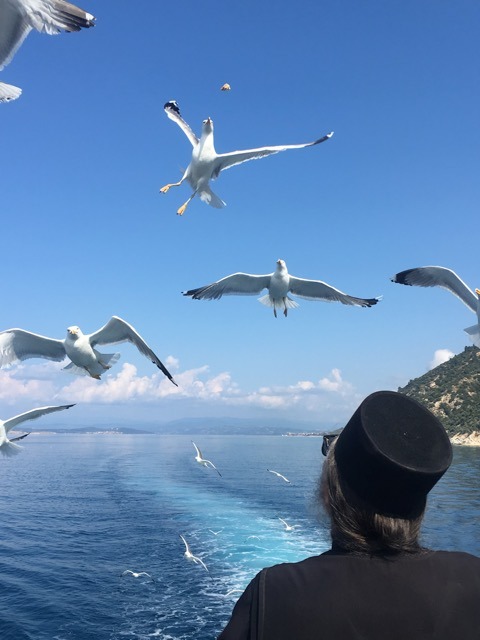
Returning to Mt. Athos
I got into the habit of attending Matins at 3.30am. I would usually stay for an hour or two and then return to bed, but the monks would push on through until dawn, some four hours later. Though I can’t understand the liturgies in Koine (Alexandrian) Greek, there is nevertheless something powerfully affecting about the bearded monks chanting by candlelight, incense heavy in the air while wind and rain batter the outside of the chapel. With very few exceptions, that same scene has been repeated in that place every night for the last 1000 years.
There is much that is very attractive to me about the Greek Orthodox faith. But there are stumbling blocks too. When I asked Brother Eugenios what the Orthodox Church would say about a healer who died some years ago on Cyprus, but whose healings are well documented (he is the subject of a book called ‘The Magus of Strovolos’, by the sociologist Kyriacos Markides), Brother Eugenios replied that the church would be very circumspect indeed. A religious elder would have to determine whether the healings occurred through the intercession of God, of whether it was the work of the devil.
‘But when the healings are effective? When sick people get well? Even then?’ I asked.
‘Yes, even then,’ confirmed Brother Eugenios. ‘The devil uses precisely such stratagems to trick people. That is why he is so dangerous.’
The Devil and his works... they have not played much role in the anodyne versions of Christianity I have encountered thus far in my life. But they are significant in the Orthodox faith, as are certain other darker aspects. There is a fresco on the far wall of the smaller Portaïtissa chapel at Iviron that depicts a river of flame siphoning the damned off into the jaws of a giant sea monster. Around the edges are stock medieval images of hell and purgatory. They do not make for pleasant viewing.
On my last night in the monastery it snowed, and the following morning I had to leave early to hike back up to Karyes, breaking tracks through the ankle deep snow. Mt. Athos shimmered in the distance, the forest around me slowly came to life, and thoughts of the Devil and his infernal sea monsters were soon far from my mind.
There was chaos at Karyes since the road was frozen over and the normal bus to the port of Dafni could not run. Replacement minivans were shuttling monks and pilgrims down the steep mountain road. Everyone had made arrangements, and was on busy schedules, and it was all rather confusing. But equally, none of it really seemed to matter very much, and I experienced a calmness and an inner amusement that I had not felt for a long time. And this time it has stayed with me, for the most part. I would like to think that it has been built on solid foundations.
0 notes
Text
The Holy Mountain
I spent a few weeks last summer in the Engadine valley in Switzerland. It is a place that has been dear to me since early childhood. In the Spinas valley, which forks off from the main Engadine valley, there is a footpath called the ‘Märchenweg’ – the fairytale path. Every kilometer or so, in a small clearing, stands a wooden chair carved from the trunk of a tree. The chair is surrounded by smaller tree segments that serve as stools. Inside the chair is a wooden file that contains the text of a fairytale from the area. Each story is printed in 5 languages – German, French, Italian, English and Romantsch, the local tongue that is a remnant of the Latin spoken by Roman legionaries stationed here.
These six little clearings, with their storyteller’s chairs, are paid for by the village council and have always epitomized for me everything that is best about Switzerland. I have written about them before in a previous blog, but the charm does not fade. They bring to mind the lovely German expression eine heile Welt – an unbroken world. For me, it is a counterweight to global politics, economic crises, climate change, refugees, pain in all its many forms. Back in August, I did a drawing of one of these circles of chairs. It felt very peaceful.
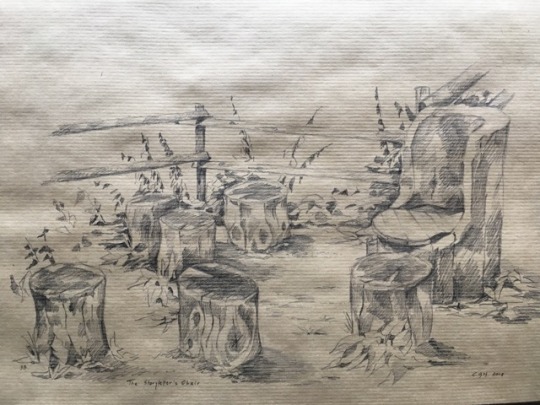
That same evening, I watched a short documentary segment in the Swiss news about Najah al-Bukai, a Syrian artist with a photographic memory who was held and tortured in one of the regime’s detention centres. He finally managed to escape from Syria, and now lives in Paris where he creates, from memory, haunting images from his time in the detention centre. Talking about his work, he says, ‘It is a personal therapy that allows me to evacuate.’ In an emotional sense, one assumes.
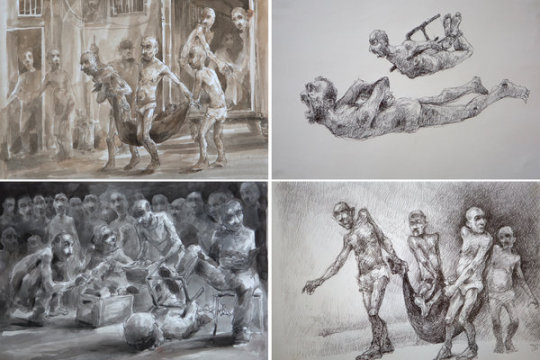
Drawings by Najah Al Bukai
After watching this report, I felt that my own work was embarrassingly frivolous by comparison. The feeling persisted for some days, until it dawned on me that although the outcomes could scarcely be more different, our motivations are similar: drawing, and art in general, as a form of therapy, and a way to find tranquility. With that in mind, I completed a few more small pieces.
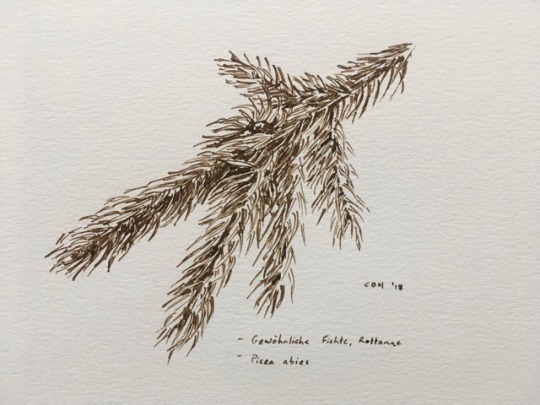
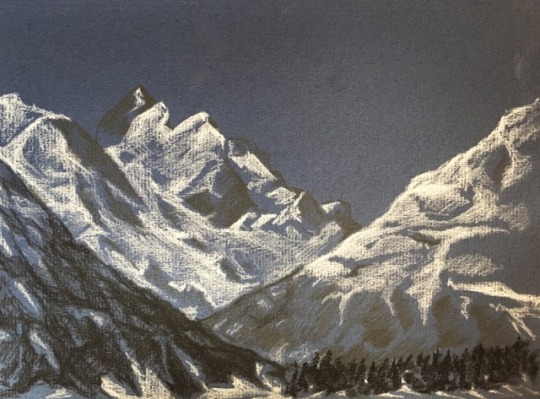
*
Once back in Athens, I lost some of that Swiss tranquility. The summer is long, and the pleasure-seeking attitude that goes with it leaves a psychological hangover. This was the first anniversary of my life in Greece. The first 8 months had been busy, finding a place to live, and a place to work, doing them both up, taking my first steps in learning the language, and accumulating the thousand and one small objects that are required for a comfortable settled existence in a Western metropolis. The next 4 months had been summer, with friends visiting, and time spent out of doors. And now I had run out of excuses, and pocket money; I needed to knuckle down and get to work, and that made me feel… restless and unbalanced. Not that I wanted to be elsewhere, just that I was not accustomed to long periods of focused activity. That, and the underlying anxiety that my output would fail to live up to my aspirations.
Ironically, the one thing that my restless mind was able to settle on was the thought of restlessness itself; I kept coming back to this. We must surely live in the most restless of times. Scrolling through social media, multitasking, channel-hopping, budget travel… these are all expressions of our restlessness. It is not as acute in Greece as elsewhere, which is partly why I like living here, but it still exists. Very few people are unaffected - that is perhaps a lifetime’s work.
I sometimes think back to an older English lady I knew in Beirut. She was married to a Lebanese man. For some years they had lived in Dubai. She once narrated to me a particularly cherished memory: she remembered waking up one morning in their house in Dubai, the sun filtering through the curtains, her husband back from a business trip and fixing breakfast in the kitchen, and the sound of her two children playing in the garden. And at that moment, she told me, she felt at perfect peace. Everything she wanted or cared about was right there, within reach. She was, for once, free from desire.
It is a beautiful image, and an enviable one… ‘So far the poet.’ But what the narrative does not reveal is the transience. Her husband will go away on business again. Her children will grow up. Dissatisfaction will return. How does one address the root?
*
This is the background against which two significant things happened to me recently. The first is a book, and the second a short trip.
Over the summer, a close friend recommended Empire of the Summer Moon, an outstanding book by S. C. Gwynne, about the rise and fall of the Comanche tribe on the American Great Plains, towards the end of the 1800s. It has made me reconsider some of my most deeply held convictions.
Like most boys of my generation and background, I grew up admiring the cowboys of the old Wild West. They were brave, independent, steely men. They were fighting against savages whose custom it was to scalp people. And, I suppose, the cowboys were white and basically European.
Then, when I was old enough to question the cartoons and comics and movies that had shaped this worldview, I had to confront some nasty truths. The whites took the land from the Indian tribes, who had never believed in ownership in our modern sense anyway. The Indians had lived off the land, and roamed freely over it. The whites made treaties and broke them. They were driven by greed. Before the cowboys, there were Spanish missionaries who had attempted to impose their God – the same God in whose name much of South America had been enslaved – on an indigenous culture that lived in harmony with the natural world, and whose spirituality was a living breathing thing, not relegated to a clapboard Church once a week.
That is how I started to think. And corroboration was not hard to find. I read about C. G. Jung’s visit to Taos Pueblo in New Mexico in 1925. Jung met and befriended Ochway Biano (‘Mountain Lake’), the medicine man of the tribe. In Modern Man in Search of a Soul (1933), Jung quoted Ochway Biano:
‘See,’ Ochway Biano said, ‘how cruel the whites look. Their lips are thin, their noses sharp, their faces furrowed and distorted by folds. Their eyes have a staring expression; they are always seeking something. What are they seeking? The whites always want something; they are uneasy and restless. We do not know what they want. We do not understand them. We think they are mad.’
Yes, I thought. We are always uneasy and restless. And perhaps mad too.
Then I read Cormac McCarthy’s magnificent Blood Meridian, and it seemed that white moral supremacy was a myth too: the whites were also scalping the Indians on punitive missions. It was a bloodbath all round.
I read The Gospel of the Redman by Ernest Thompson Seton, a writer and wildlife artist who later became the founder of the Boy Scouts of America. In it, he records the dedication that a Tekahionwake Indian was expected to speak over the body of a deer he had just killed, and I was moved by it, much more so than the bland Christian ‘Grace’ intoned at school mealtimes.
To The Dead Deer
I am sorry I had to kill thee, Little Brother.
But I had need of thy meat.
My children were hungry and crying for food.
Forgive me, Little Brother.
I will do honour to thy courage, thy strength and thy beauty.
See, I will hang thine horns on this tree.
I will decorate them with red streamers.
Each time I pass, I will remember thee and do honour to thy spirit.
I am sorry I had to kill thee.
Forgive me, Little Brother.
I went on to study psychology, and focused on the psychology of shamanism, and traveled to the Amazon to explore an indigenous worldview that created a matrix of meaning in which myth, history, culture, medicine, ritual, cosmology, and the natural world all hung together in a coherent and purposive whole… and this is what the early missionaries had demonized as ‘devil-worship’! My own experience, naïvely romanticizing as it may sound, was that people are happier, calmer, and less neurotic the less exposure they have had to Western values. And the indigenous perspective often seemed much more beautiful too.
(for more on this, see http://www.clausvonbohlen.com/post/20467603477/what-can-we-learn-from-shamanism)
So, I have been pretty down on the ‘achievements’ of the West for most of my adult life (though nevertheless grateful for advances in medicine and dentistry, and appreciative of certain artistic achievements).
But Empire of the Summer Moon has given me a lot to think about. The book charts the rise and fall of the Comanche tribe, with a particular emphasis on the story of Cynthia Ann Parker. Cynthia Ann was the daughter of settlers whose small fort was attacked and overrun by a Comanche raiding party in 1836, when Cynthia Ann was 9 years old. She was taken captive, along with her younger brother, her 17 year old aunt and her aunt’s infant son, and another young woman called Elizabeth Kellogg.
Before being captured, Cynthia Ann saw her father scalped and her grandmother raped. Then the prisoners were tied to their Comanche captors on horseback. The Comanche rode hard to distance themselves from possible pursuit. When they camped for the night, the two ‘adult’ women - Rachel (17) and Elizabeth Kellogg - were gang raped in front of the children. Rachel Parker’s baby was eventually dismembered by being dragged around behind a horse. 9 year old Cynthia Ann went on to be adopted by a Comanche family, and eventually married a Comanche chief. Their son, Qanah, was the last chief of the Comanches, and the book also tells the story of his life.
But so what? A one-off story of brutality from an unusually vindictive Native American tribe, right? Well, that is what I would previously have thought. But, if the author is to be believed – and the book is an impressive and well-referenced work of scholarship – then this was not a one-off incident at all. Raiding and counter-raiding had been the norm for Indian tribes long before the first whites arrived. And raiding was always conducted with astonishing brutality: men who were not killed were invariably tortured, women were gang raped, and babies were generally skewered.
The picture that emerges from this book is one of a culture without anything that we would recognise as morality. There were certainly taboos, and spirits to be placated, but it is a far cry from the notion that I have long cherished, of peace-loving peoples living in harmony with each other and with the natural world. The author writes:
It is impossible to read Rachel Plummer’s memoir without making moral judgments about the Comanches. The torture-killing of a defenseless seven-week old infant, by committee decision no less, is an act of almost demonic immorality by any modern standard. The systematic gang-rape of women captives seems to border on criminal perversion, if not some very advanced form of evil. The vast majority of Anglo-European settlers in the American West would have agreed with those assessments. To them, Comanches were thugs and killers, devoid of ordinary decency, sympathy, or mercy. Not only did they inflict horrific suffering, but from all evidence they enjoyed it. This was perhaps the worst part, and certainly the most frightening. Making people scream in pain was interesting and rewarding for them, just as it is interesting and rewarding for young boys in modern-day America to torture frogs or pull the legs off grasshoppers. Boys presumably grow out of that; for Indians, it was an important part of their adult culture and one they accepted without challenge.
The first shock, for me, was the realization of the wanton cruelty of native Americans towards each other. The second shock was that they saw nothing wrong with this, as the following passage makes clear:
Enemies, meanwhile, were enemies, and the rules for dealing with them had come down through a thousand years. A Comanche brave who captured a live Ute would torture him to death without question. It was what everyone had always done, what the Sioux did to the Assiniboine, what the Crow did to the Blackfeet. A Comanche captured by a Ute would expect to receive exactly the same treatment (thus making him weirdly consistent with the idea of the Golden Rule), which was why Indians always fought to the last breath on battlefields, to the astonishment of Europeans and Americans. There were no exceptions. Of course, the same Indians also believed, quite as deeply, in blood vengeance. The life of the warrior tortured to death would be paid for with another torture-killing if possible, preferably even more hideous than the first. This, too, was seen as fair play by all Indians in the Americas.
I have recently been reading the Odyssey, and I have been struck by a similar absence of moral sentiment in it. At no point does anyone question whether there are any values beyond strength and skill. Even heroic Odysseus boasts about putting all the men of a city to the sword, and carrying off the women, just because he could. But we ought not to be surprised by this; it wasn’t until the time of Socrates and Aristotle, some 300 years later, that people first started to question whether might is always right (at least as far as written records reveal).
The parallel between Homeric times and Native Americans should not be surprising either: the Maecenean period that is the basis of Homer’s narrative was a late bronze age culture, whilst the Native Americans were – in terms of their technology - a stone age people. The two have a lot more in common with each other than with the highly organised, industrialized West that the white settlers represented.
S. C. Gwynne argues that morality as we understand it today is closely linked to complex social organization. But this kind of organization only develops when large numbers of people can live together in one place, and when they have the leisure to develop capacities which are not directly related to meeting the most basic human needs. Agriculture made this possible, but agriculture is something which the Native American tribes did not begin to practise until the arrival of Anglo-Europeans. Plains Indians such as the Comanche remained nomadic hunter-gatherers until the bitter end. If this theory is correct, it means that there is a direct causal connection between higher moral values on the one hand, and complex civilization on the other. Morality has developed in conjunction with the increasing complexity of human society. This was a big realization for me. For all of my adult life, I have thought that the opposite is true.
*
The second significant event was a trip, at the end of October, to visit Mt. Athos, the ‘Holy Mountain’ in the north of Greece. It towers over the tip of a peninsula that sticks out into the Aegean. The whole peninsula is an autonomous monastic region; women and domestic female animals are not permitted. The area is sacred to the ‘Panayia’ - the Virgin Mary - and it is also known as ‘the Garden of the Mother of God’. There are about 20 functioning monasteries on the peninsula, connected to each other by footpaths and dirt roads. Some of them were founded a thousand years ago.
Permits are not easy to come by for non-Orthodox visitors. I have wanted to visit Mt. Athos for some time, but in the end I could only go when they happened to have a permit to spare, though happily still before the winter. I was planning to walk from monastery to monastery in traditional fashion. Board and lodging in the monasteries is included in the cost of the permit, but you do have to book ahead. I set about doing this from Athens, but again, it was not easy – the monasteries only answer the phone at very specific times, for a couple of hours, and often in heavily accented Greek. In addition, it is hard to know exactly how long it will take to walk from one monastery to another, and you do not want to arrive too late since the gates are locked at sunset and remain closed until the following morning.
I approached this trip as if it were a short trek. I was looking forward to seeing a new area of Greece, and to spending some days walking through virgin forests. The absence of technology and commerce was appealing too. I had my rucksack, my half-read copy of Empire of the Summer Moon, a sleeping bag, and a loaf of bread – the latter two in case I did miscalculate and ended up being locked out.
I left Athens at midday and arrived in Thessaloniki around sunset. It was a Saturday evening and Thessaloniki had a lively, friendly feel to it. I bought some gourmet trail mix on the promenade, then pushed on to Ouranoupolis, the jumping off point for Mt. Athos. The last two hours of the drive were along winding, misty roads through a forest, in the dark. I was listening to ‘Up and Vanished’, a podcast about a real life murder investigation in a provincial American backwater. All together, it made for a spooky drive, particularly when a large truck tailgated me for some distance.
I spent the night in a small hotel in Ouranoupolis. At 7.30 the following morning, I made my way to the Pilgrims’ Office to pick up my permit. The office only opened at 8, but I thought I would get there early to avoid any last minute mishaps (there was only one ferry to Mt. Athos and it left at 9.30). I was surprised that the office was already open when I arrived, and even more surprised to see a queue of at least fifty people waiting to receive their permits. They were wearing a lot of black leather. Many of them looked more like football hooligans than pilgrims. Almost all of them spoke Russian, though I was later to discover that they came from a number of Orthodox countries – Romania, Bulgaria, Serbia, Ukraine and Georgia as well as Russia. Being Orthodox, it is easier for them to get permits.
The queue moved faster than I had anticipated and I soon had my permit. I proceeded to the ticket office for the small ferry, and had to queue again, with the same crowd. After a tasteless breakfast by the quay, most of it spent swatting flies, I boarded the ferry. There were no longer any women to be seen, and a holiday atmosphere prevailed. As the ferry nosed towards Athos, some of the Russians pulled cans of beer from their pockets and cracked them open. Others threw pieces of bread into the air for the trailing seagulls to catch. My particularly thuggish looking neighbors kept turning in their seats and inadvertently (I think) elbowing me. I put my headphones on and returned to the murder investigation podcast. This was not quite as I had imagined.
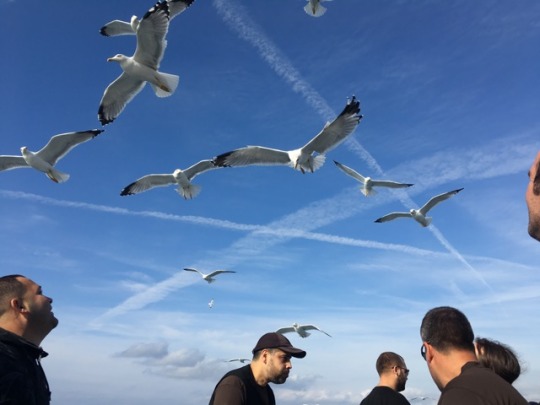
The ferry stopped at each of the monasteries along the way to the tiny port of Dafni. I had planned to walk from Dafni, across the peninsula, to the monastery of Iviron on the east side. But when we docked, I saw that two buses were waiting to take people to Karyes, the administrative centre of Mt. Athos, and half way to Iviron. If I took the bus, I would be sure of arriving at Iviron before sunset. I climbed on board, and encountered one of the more characteristic aspects of life on Athos: male body odor. It would appear that, in the absence of women, men wash less, or smell more, or both. Boys’ schools are the same, as, I imagine, are armies.
The bus to Karyes took half an hour, on a dirt road, and from there I walked to Iviron monastery. The morning’s clouds cleared and I was granted some beautiful views of Mt. Athos itself, to the south. For over two hours, I only saw one other walker; the other pilgrims had vanished. This continued to be the case for the whole three days – once or twice I encountered an Athonite monk, but no other pilgrims. And this solitude contributed to a deep sense of peacefulness.
As I walked, I studied the piece of paper I had picked up in the permit office, detailing guidelines for visitors. These were quite strict – no shorts, no bathing etc. (not unrelated to the body odor, perhaps). The paper began by welcoming me to the ‘Garden of the Mother of God’… what a beautiful phrase! Garden, Mother, God… what’s not to like? But what does it really mean? How can God, the life-force that animates the universe, have a mother in any meaningful sense? Is it not the narrowest anthropocentrism? So beautiful, and yet, once again, I felt on the outside… the foreigner, the observer, wishing I could believe in something so lovely, but unable to deceive myself.
These ruminations were cut short by the appearance of Iviron itself, a medieval fortified keep beside the sea. I located the guestmaster, was shown to my room, and then attended the afternoon service. There was incense, and chanting, and monks in black habits with long beards. I admired the ritual, and the solemnity, and found it wholly unintelligible. There were other pilgrims too, all Orthodox, who appeared to know exactly what to do, and went in for an orgy of icon-kissing and crossing of their chests – so often, in fact, that it began to look like a nervous tick, rather than a sign of devotion. After the service, we were led across the courtyard to the refectory. Here there were two long tables with plates of roast fish in front of every place. We ate while listening to a reading from the Bible, in Alexandrian Greek.
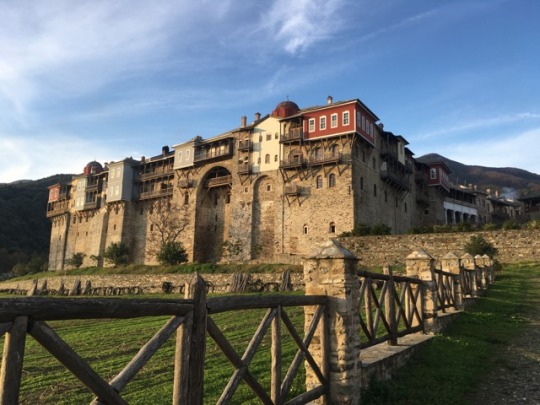
Iviron
After dinner, we filed out into the courtyard, where it was still light. The half hour after meals was one of the few times when monks appeared to talk to each other. I wandered by myself between groups of Russian speaking pilgrims and pairs of Greek speaking monks. I went outside for a few minutes before the gates were closed for the night; there were Russians smoking outside. Then, as I crossed the courtyard again, I was astonished to hear two English accents, emanating from two bearded old monks. I approached them and introduced myself.
Both were indeed English, and both had converted to the Orthodox faith a long time ago. One had initially lived in a Coptic monastery in the Sinai desert, the other had been a doctor, then a psychiatrist, then a priest, then an Anglican monk, and now, finally, a monk on Athos. And they also wanted to know why I was there. I told them, as best I could.
Brother David saw through my meandering narrative. ‘If you are genuine in your search, then God will reveal himself to you,’ he said.
‘But there is so much that doesn’t make sense,’ I said. ‘Like the Garden of the Mother of God… it’s a beautiful idea, but how can God have a mother?’
‘Well,’ said Brother David, ’We believe that Christ was human, so he had a mother, but he was God too.’
Of course! How foolish of me not to think of that! I felt myself blush.
‘You may find that mysterious, and it is. But if you follow this path, then over the years, many mysteries will become clear to you.’
‘But I am not sure I can just believe something because someone, or some book, says so. That is what I like about Buddhism – it’s experiential, empirical, scientific. You practise a technique, and then you see whether it works, whether your experience matches that of others.’
Brother Irodio, the ex-Copt, had been less talkative so far, but now he said, ‘That is what the Orthodox religion is like. We train ourselves too, over a lifetime. And then, over time, God reveals himself to us.’
For a long time now, I have thought of myself as a pluralist. Most religions consider themselves to have a monopoly on the truth, and that has always struck me as highly dubious. From within the perspective of any given religion, the claims and the texts and the norms are perfectly coherent… everything hangs together and makes sense. But the same applies across the board, to all religions. So why are Christian arguments that rely for their evidence on the Bible any more compelling than Moslem arguments that rely on the Koran?
Brother Irodio and Brother David made no effort whatsoever to convert me. But Brother David in particular emanated a peacefulness, and a warmth, that made a deep impression on me. And this quality of peacefulness, this sense of Eine Heile Welt, grew deeper with every day that I spent on the Holy Mountain.
Of course, you might say that it is hardly surprising that these monks seem peaceful – there are no women to distract them, and they have no money to worry about, and nothing to buy or own. That is true. But I think that many people would find that very challenging. Many people actually like the drama, the games, the getting and having and then again spending or losing…. But I am not sure that I do, any more. And sometimes, maybe all that noise is a way of distracting oneself from what is going on inside.
The following morning I left early, while the monastery was still shrouded in mist. I continued south along the coast for about an hour, then struck inland to cross the peninsula from east to west. The dirt road snaked its way upwards to the central ridge. A couple of pick up trucks drove past me, and both times the monks stopped to ask if I was lost. One of the monks was American, and when I told him that I was heading to Osoriou Gregoriou, he told me the name of an English monk there.
The leaves were falling and I was reminded of a previous pilgrimage some years ago, to Santiago de Compostela, much of which was also during autumn. The temperature dropped as I got closer to the ridge. On a couple of occasions I passed monks chopping down trees. They used chainsaws, but enormous shire horses were waiting to drag the trunks out of the woods. When the horses snorted, conical clouds of condensation jetted from their nostrils.
I crossed the central ridge, with the peak of Athos to my left, then descended steeply down the other side towards the more sheltered west coast of the peninsula. I arrived at the monastery of Osoriou Gregoriou in the middle of the afternoon. While waiting for the guestmaster, I chatted to a rotund monk from Kalamata who had formerly been a pizza delivery boy. He was keen to reminisce about English football, and I fear I was rather a disappointment to him.
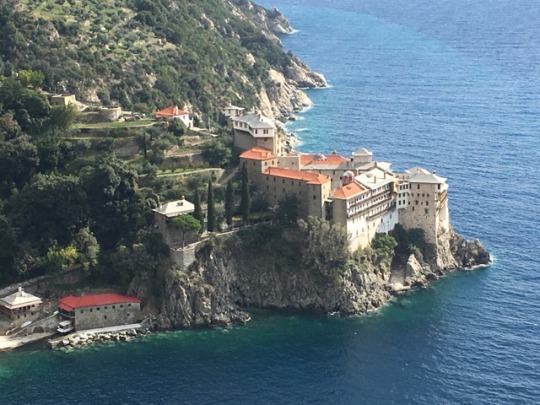
Osoriou Gregoriou
Osoriou Gregoriou is perched above the water. Mondays are days of fasting, and the evening meal was a bowl of lentils, but the meager fare was made up for by the sight and sound of the sea directly below us. After dinner I enquired after brother Damien, the English monk. I was led down a number of staircases to a bookbindery where Brother Damien was putting the finishing touches on a newly bound spine. He had a curly grey beard and a humorous manner. He was originally from Stockwell in South London, just down the road from where I used to live in Brixton.
We chatted that evening, and again after breakfast the following morning (which was in stark contrast to the evening meal – it was accompanied by wine, and finished off with a Ferrero Rocher chocolate). To say that Brother Damien was a conspiracy theorist would be an understatement, and I don’t particularly want to go into all that again, nor relive the sense of vertigo the conversation gave me (admittedly, we were also perched on a small wooden balcony above the sea). But I am grateful to Brother Damien for introducing me to the concept of ‘Theosis’. This is perhaps the central tenet of the Orthodox religion. It holds that the true purpose of human life is nothing less than for man to become one with God, to become a god himself.
When I said goodbye, Brother Damien gave me a slim volume written by Archmandrite Georgios, the former Abbot of the monastery. It was entitled ‘Vergöttlichung: Das Ziel eines Menschenlebens’. He only had this German copy, but I later found an English version. The English title is, ‘Theosis: The True Purpose of Human Life.’
I left Osoriou Gregoriou and headed north, back towards Dafni. After about an hour I passed through the beautiful gardens of Simonas Petras. The monastery itself towered above me, its walls inconceivably high, like CGI battlements from a Lord of the Rings movie. I passed back through Dafni and then climbed the final hour up to Xiropotamou monastery. Here the friendly young Romanian guestmaster (not a monk) plied me with tsipouro (Greek Schnapps) and Turkish Delight. Perhaps he felt he was atoning for the monastery, since it was rather an austere place: being non-Orthodox, I was not allowed to attend services or even eat at the same time as the monks.
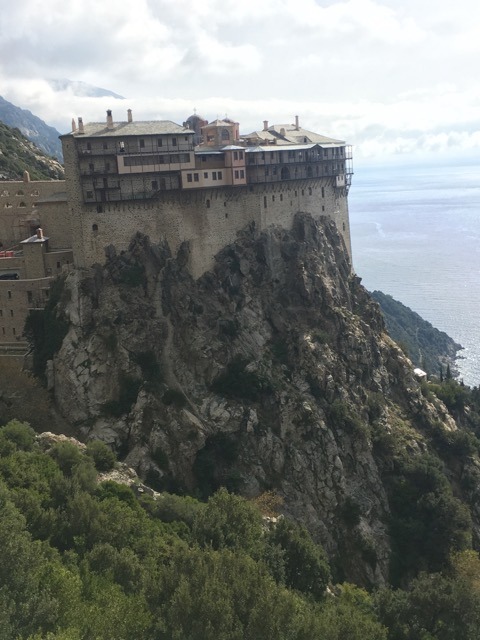
Simonas Petras
That evening I read Archmandrite Georgios’ book on Theosis. He wrote:
Since man is “called to be a god” (i.e. was created to become a god), as long as he does not find himself on the path of Theosis he feels an emptiness within himself… he feels that something is not going right, so he is not joyful even when he is trying to cover the emptiness with other activities. He may numb himself, create a glamorous world, or cage and imprison himself within this world, yet at the same time he remains poor, small, limited. He may organise his life in such a way that he is almost never at peace, never alone with himself. Surrounded by noise, tension, television, radio, continuous information about this and that, he may seek to forget with drugs; not to think, not to worry, not to remember that he is on the wrong path and has strayed from his purpose.
In the end, wretched contemporary man finds no rest until he finds that “something else,” the highest thing; the thing which actually exists in his life which is truly beautiful and creative.
That gave me plenty to think about.
The following morning I again left before the sun had risen. There are terraces behind the monastery where many gnarled olive trees grow. I saw a monk with a great white beard and a staff; he was walking between the trees and inspecting the leaves. He seemed so entirely at peace with himself and the world, his world. A wave of emotion swept over me in that moment – there is such a thing as eine Heile Welt. And there are great mysteries too.
As I returned to Dafni to catch the ferry, I wondered about that wave of emotion: was it a tiny experience of what the faithful call ‘Grace’, something like a gift from God? And that bearded monk in the cool of the morning… for years I have assumed that men have anthropomorphized God, that we have created him in our image. But maybe I’m wrong? Maybe we really are created in the image of God? Not that God is male and bearded, nothing as simplistic as that, but maybe we do share some of God’s qualities? Maybe the divine is less abstract than I have always assumed? Maybe a personal relationship is not only possible, but necessary?
Since I was 11 years old, when I dropped out of confirmation class, I have not considered myself a Christian. A few years later, at boarding school, I encountered a couple of Reverends who could scarcely have been less inspiring: one a sad weasely figure, the other an ignorant bully and former army Padre who tried to show off about how many Argentinians he had killed during the Falklands War. Chapel was a daily bore, although the music and choir were good. Then, in my 20s, a couple of visits to Charismatic Christian churches, and a couple of sessions of the Alpha Course, but it was all so cheesy! So paper thin! Whereas on Mt. Athos, I felt there was something ancient, mystical, solemn, and deeply inspiring… qualities that I have rarely encountered in the West.
On days when I feel inexplicably tense, or somehow ill at ease, there is a phrase that comes to my mind from those dull chapel services of my adolescence: ‘The peace of God, which passeth all understanding…’ Could those be more than just pretty words? It is certainly worth investigating. I think I was wrong about the Native Americans, and that was a longstanding conviction too.
0 notes
Text
Asclepius the God
It is a long time since I last posted here. I have to find some flow again, so please forgive me if the following is a bit disjointed. It also starts with a physical ailment, which is uninspiring (and elderly), but it is merely a way in…
I have, for some time now, been suffering from lower back pain. It’s nothing dramatic, just a constant dull ache. But it is enough to kill my enthusiasm, in a very general way. Taking the dog for a walk, watering a plant… they become an effort rather than a pleasure.

There are different theories about the etiology of lower back pain. Some people say it is stress related (and, in my case, it came on at a time when I felt very tense). A friend of mine who is a practitioner of Traditional Chinese Medicine was more precise: it is specifically related to money trouble. The spine specialist in London was true to his scientific roots and diagnosed, with the help of an MRI, ‘mild joint effusions at L 4 – 5’. I asked him about the effects of stress. He said that stress and tension could make a problem worse, but that they could not be the cause of it.
I saw a chiropractor and an acupuncturist, neither of whom were able to effect any lasting improvement. In the end, the spine specialist prescribed painkillers, anti-inflammatories, and a course of physiotherapy. I followed this conscientiously over a period of months, also to no avail. Eventually, I went for an expensive cortisone and anaesthetic injection into the spine. The symptoms went away for a month, but as soon as those chemicals were no longer present in my back, the pain returned. I began to feel that I would just have to live with it; manageable, but joyless.
Here in Athens, a friend told me about about an ‘energy healer’ who had helped her a lot, and who was in any case an interesting individual. I thought to myself that I had nothing to lose, and I asked her for the healer’s contact details.
A week later, on a cold and drizzly February morning, I rang Iannis’ doorbell on a street in Pangrati - a comparatively quiet area of central Athens. Iannis came to let me in. He was a diminutive, smiling man in his late sixties or early seventies, with a lively, engaging manner.
We went into his apartment which was small, modern, and perfectly ordinary. On the walls were a few of those tricksy landscape paintings that are sold by street artists. I was about to launch into a description and history of my complaint, which so far I had not told him anything about, when he stopped me by holding up his hand. ‘Let me diagnose you,’ he said.
I then stood in silence, fully clothed, in front of Iannis, while he put his hands lightly on my shoulders for a few minutes. Eventually he said, ‘You have lower back pain, a problem around vertebra 04, and you have had trouble with your right knee in the past.’
I was blown away by this. He was right about the knee too, it was a rugby injury that had plagued me for about 2 years. While driving, the pain used to force me to stop the car every half hour to stretch my leg. But that was more than ten years ago, and since then I have not had any knee trouble.
‘Do you also sometimes feel that your heart beats irregularly?’ he asked. ‘No,’ I replied truthfully, and my belief in his omniscience diminished a little, though it is possible that he is right and I am not aware of it. He then said that my lungs were not breathing properly, owing to a problem some time ago. This is also true, I got pneumonia a few years back. He seemed to think that this was the more serious problem, since it affected the amount of oxygen in my brain and therefore also my general mood. But he thought that he would be able to treat all of these problems. When I asked how many sessions would be necessary, he blithely replied, ‘Just one.’
Iannis told me that he used a form of energy manipulation. ‘Like Reiki?’ I asked. ‘A bit like Reiki,’ he said, ‘but this is an ancient Greek technique, in the tradition of Asclepius, the God of medicine and healing. It is not written down anywhere. It has been passed down through generations of practitioners, but there are not many of us these days.’
Iannis told me to lie down on my back on his sofa with my eyes closed while he performed the energy manipulation above me. He told me to report anything I saw or felt, particularly any colours I saw. It lasted for about half an hour. Frankly, I did not see or feel a lot. Perhaps some warmth in my hands, and a slight vibration in my solar plexus. I saw a few greens and reds, but I could never be quite sure that I wasn’t imagining them, or willing them into being. But each time I reported a colour or a sensation, Iannis would respond with an encouraging, ‘Yes, very good.’
The treatment ended with the painful massaging of three pressure points, two on my left foot, and one near my heart. Then he asked me to stand up and walk around the apartment. I did feel a lot better, though the pain from my back had not gone completely.
I asked Iannis how he had performed the initial diagnosis. He said that it was by knowing himself very well, and then by sensing the energy of another person through various sense modalities, including sound and smell. He said that it was not so much a gift as the result of single-minded dedication over a lifetime. He reiterated that what is absolutely fundamental is self-knowledge; only on that basis can one come to know others. That is rather what I think about psychotherapy.
I paid 70 Euros and left his apartment. It was still raining outside, so I decided to wait it out and treat myself to a coffee. As I sat in the café, the ache in my lower back returned, as persistent as it had ever been.
*
Some months later, I felt I needed to escape the summer heat of Athens. I got on my motorbike for a weekend trip to visit some of the Mycenaean sites in the Peloponnese. The Mycenaean culture was dominant from about 1600 - 1100 BC; it consisted of a number of small independent kingdoms – Mycenae, Sparta, Argos, Pylos, Tiryns, Midea, Thebes, Athens and a few others. This was the period subsequently made famous by Homer in the Iliad and the Odyssey. It is the factual basis for the myths and legends that he committed to paper between 500 and 1000 years later, and also the period that saw the birth of the first attested form of written Greek (called ‘Linear B’), which predated the Greek alphabet by several centuries.
I crossed the Corinth canal and then followed the small country roads down to ancient Epidauros. This was once a sanctuary of Asclepius - a site of pilgimage and the most famous healing centre in the ancient world. It comprised the temple of Asclepius, a hospital, a 160 room guesthouse, a bathing complex, a 14,000 seat theatre with near-perfect acoustics, and a sports stadium used for quadrennial games.
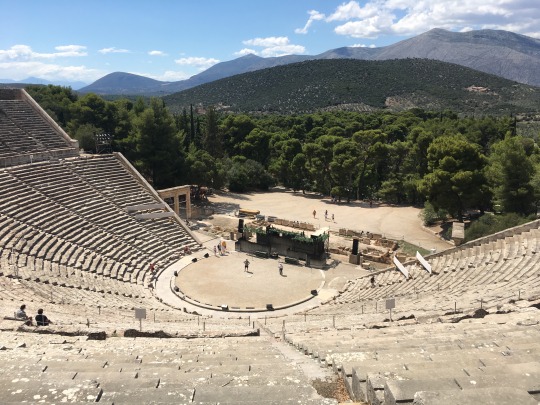
The 14,000 seat theatre at Epidauros.
There were few other visitors that afternoon and it felt like a magical place. The pine trees appeared to pulsate with health. Beside the Temple of Asclepius are the remains of the rectangular Abaton; patients used to sleep in this building in expectation of a visitation, in their dreams, from Asclepius the healing God, commonly believed to take the form of a serpent. The God would advise them what they had to do to regain their health.
Beside the Abaton was the circular Tholos, the foundation walls of which formed a labyrinth that was used as a snake pit, full of harmless snakes. The pit may have served as a primitive form of shock therapy for the mentally ill. The afflicted would have crawled in darkness through the maze-like structure, guided by a crack of light towards the middle, where they would find themselves surrounded by writhing reptiles. One would need a very strong constitution not to find that shocking.
In the museum there was a sculpture of Asclepius holding a staff with a snake wrapped around it. This is the famous ‘Rod of Asclepius’ – the symbol of medicine and healing arts that is still used around the world today (it should not be confused with the caduceus, the staff of Hermes, which has two entwining snakes and is more properly associated with commerce). Asclepius is also often depicted with a dog by his side, and some healing temples used sacred dogs to lick the wounds of sick petitioners.
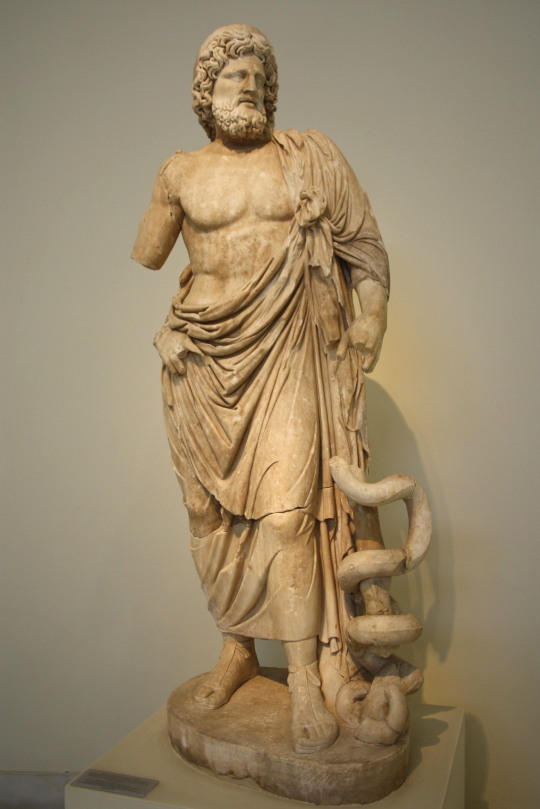
Asclepius and his snake-entwined rod.
Wandering around this peaceful temple complex, I wondered about the role of snakes in healing. It is a major theme in Amazonian shamanism. Snakes are probably the most common motif in Ayahuasca visions, and they play a significant role in the cosmologies and mythologies of many indigenous cultures. And indeed in our Western mythology too, going back to the serpent in the garden of Eden. Why are snakes so significant, and why are they associated with medicine and healing across cultures? I would like to know (there is an interesting theory in Jeremy Narby’s Cosmic Serpent, to do with the double helix of DNA, though it would seem to apply more accurately to two entwined snakes, rather than just one).
There was an area of shade at the back of the rectangular Abaton. Hanging on the wall was a photo of a relief sculpture from another Asclepian sanctuary (at Piraeus), depicting the kind of healing that may have gone on in this building. A patient was lying on a couch, and a healer, or perhaps Asclepius himself, seemed to be performing some kind of energy manipulation above him. It could have been me on Iannis’ couch.
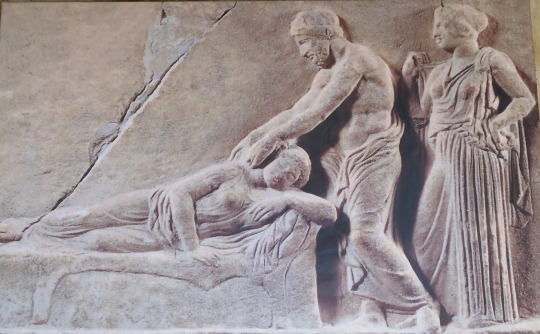
Relief sculpture from the sanctuary of Asclepius at Piraeus
*
From Epidauros I drove to Nafplio. For 13 years, this small seaside town was the first capital of modern Greece, from the start of the Greek War of Independence in 1821 until 1834. At that time, as photos attest, Athens consisted of little more than ruins surrounded by a few farmhouses.
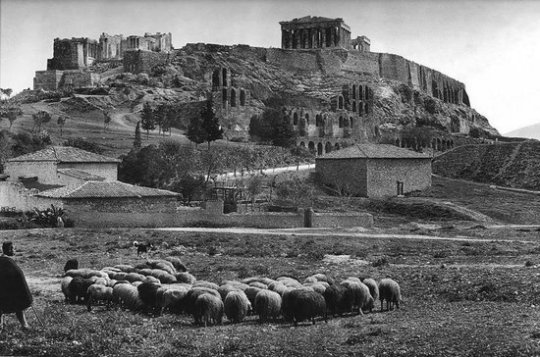
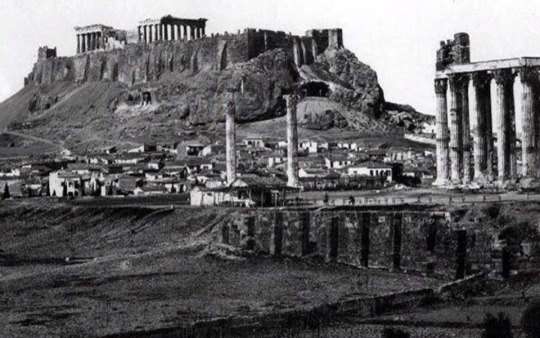
I spent the night in Nafplio, then visited the site of ancient Argos the following morning. It is on the outskirts of town, rather hard to find. Entry is free and the theatre is impressive, but less so than Epidauros. Then I pushed on to Sparta, down to Kalamata, and finally up into the foothills of Arcadia.
In the early evening I passed through modern Megalopolis; it is a nowhere sort of place – an empty main street, a series of traffic lights, and strong winds - but in ancient times there was a huge city here. From the road a few miles outside the modern town, I saw three Ionic columns standing unremarked in the tall grass of a tawny field, and behind them a flock of sheep and their shepherd. Who placed them there, and why? What were they once a part of? Which God was worshipped there?

I spent that night in the hillside village of Karitena. The night was blissfully cool after the sultry nights in Athens. The following morning I had to wait for the mist to clear, then I followed small, winding roads into the forested hills of Arcadia. I crossed the river Alpheus on an small stone bridge – Alpheus was probably the basis of Alph, the ‘sacred river’ that Coleridge glimpsed in his opium-inspired reverie, and whose ready-formed verses he subsequently committed to paper as the poem Kubla Khan.
I thought of the resonance of Arcadia, the traditional precinct of the nature god Pan. For later Roman poets, Arcadia was linked to the Golden Age - a time of innocence and primordial bliss, before the rot set in. Virgil claims Arcadia as his own in the climax to his Eclogues.
Arcadia came to be known as ‘Arkady’ in English, though Evelyn Waugh reverted to ‘Arcadia’ for the title of Book One of Brideshead Revisited: ‘Et in Arcadia Ego’. This is a memento mori in which Death is warning us that he will find us even in Paradise – the skull is forever grinning in at the banquet. But, one has to wonder, is that not what gives the meal its relish?
My GPS ceased to function on these tiny roads, and I was soon lost and had to retrace my route. But it was a beautiful drive and I felt profoundly grateful to live in Greece.
0 notes
Text
24 Deligianni Street, Athens.
24 Deligianni street is where I live. It is a πολυκατοικία – an apartment block. Literally, this means: ‘many (πολύ) – relating to (κατά) - the home (οίκος) , a ‘many-home-dwelling’. Oίκος is the archaic root that resurfaces in English words such as ‘economy’ (the management of the home), and ecology (the study of the home, in this case planet earth). It is a good example of how, in Greece and in Greek, the ancient and the modern, the old and the new, are interconnected.
My building is located in Exarcheia, beside the archaeological museum and midway between Exarcheia square, to the south, and Pedio Areos park, to the north. This was once a very desirable neighborhood, but in the 1960s and 70s many of the more affluent inhabitants moved out of the centre and into the suburbs. Immigrant communities were drawn to Exarcheia because of low rents and good transport links, and now it is very diverse, with many Pakistanis, Bangladeshis, Nigerians, and, more recently, Afghans and Syrians.
The archaeological museum is next to the National Technical University of Athens, the Πολυτεχνείο, famous for the student uprising against the military junta in 1973, in which 23 students died. Exarcheia has been an area of politicised resistance ever since; the mantle has now been taken up by a broad group that define themselves as anarchists, though this appears – at least from the outside - to include anyone with any kind of grievance.
My building dates from 1930. It has an old cage lift built by Schindler lifts, a company founded in Lucerne, Switzerland, in 1874. This lift is not much newer, and some of its important looking cables are patched up with yellow insulating tape. To step into it is, firstly, to feel a little bit nervous, and, secondly, to step back in time.
My apartment is on the fifth floor. It has a terrace on which I have recently started to grow bougainvillea, jasmine, wisteria, solanum and fragrant rhyncospermum. My mornings now begin with a round of watering, and then the sweeping of leaves and petals that the night breeze has shaken to the ground. It is a fine way to begin a new day, and reminds me of life in a Zen monastery.
The terrace overlooks the the archaeological museum, which houses the gold mask that Schliemann unearthed at Mycenae in 1876. Caution was not Schliemann’s guiding principle; upon finding the mask, he telegraphed King George of Greece to say, ‘I have gazed upon the face of Agamemnon.’ Subseqent archaeological research has concluded that the mask predates the period of the legendary Trojan war by about 300 years. Nevertheless, when I sit on my sweet-scented terrace and feel the life-affirming tingle of inspiration, then I sometimes wonder whether I might be picking up the energetic emanations of an ancient warrior-poet, relayed to me across the ages through his gold death mask, just a stone’s throw away.
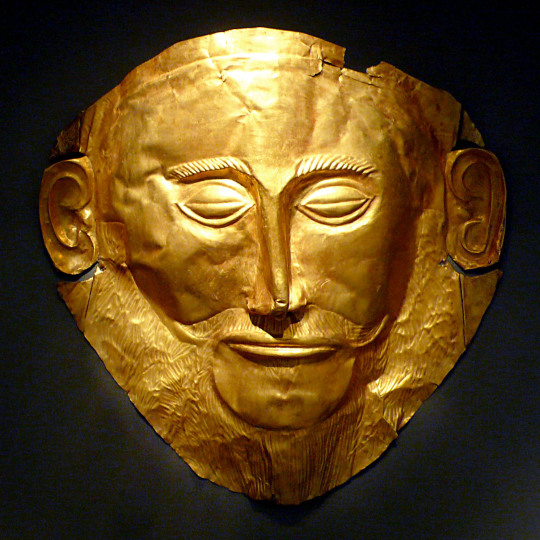
On other nights, the terrace is an excellent place to watch the clashes between anarchists, who throw Molotov cocktails, and the riot police, who mostly stand around smoking and looking bored. The clashes happen once or twice a month, and they have now acquired an oddly scripted quality, as if everyone involved is playing a role in which they no longer believe. The only exception are the journalists who pullulate behind the police. They are immediately obvious because of the luminous rectangles of their film cameras, and because they wear elephantine gas masks. Sometimes I feel as if I have box seats in an absurdist theatre.
My mother is coming to visit me next month. She will like the fact that I live beside the archaeological museum. When I was a teenager, she once told me that as a young girl she dreamt of becoming an archaeologist. But she never went to university, since from a young age she was a pawn in her parents’ acrimonious divorce, both of whom refused to pay for her education. She ended their ugly game by becoming a stewardess, thereby gaining her total independence at a comparatively young age. But it was a significant moment for me when she told me that she had wanted to become an archaeologist, because it was the first time that I had thought of her as a full person, with a life before I was born, and with dreams and ambitions of her own. I remember feeling a rush of tenderness for her then, as I do whenever I think back to that moment.
My landlady, Κυρία Φητίλης, lives on the floor below me. She is eighty years old and lives with what I initially thought was her mother, but I have since found out is the family’s former servant. This lady, whose name I do not know, is 99 years old. I don’t think I have ever met a 99 year old before. She is not surprisingly rather shrunken, with tremendous hairs sprouting from her upper lip and chin. She is very hard of hearing, and forgetful, so I have to shout to re-introduce myself every time I enter their apartment to pay my rent. However, she has a bat-like sensitivity for the sound of doorbells, and should her sonar pick up on the ringing of a bell, her tremulous cry of πιος είναι ? – who is it? – reverberates around the entire πολυκατοικία. But what I find most astonishing is the thought that she was already a young woman when the Nazis came goose-stepping through the centre of Athens.
Shortly after I moved in, I shared the lift with another tenant, this one in her sixties. Having confirmed that I was the new tenant on the 5ht floor, she then asked me if I was married.
‘No,’ I replied.
‘Ah, you must meet my daughter. She works in the university museum in Plaka.’
Then she noted down my phone number. A couple of days later I received a bashful message from her daughter, offering me a tour of her museum. I took her up on the offer and she gave me a very thorough tour of a rather uninspiring museum.
*
24 Deligianni is pressed up against its neighbours. The buildings must share some of the inner stairwells, since from my own kitchen I can clearly hear the family who live in the next door building, when they are in their kitchen. Most often I hear the mother, whose accent is deep and African, and whose vocal range is impressive. She likes to chat on the phone while cooking; at least, that is what I infer from her long monologues, punctuated by laughter, and accompanied by bubbling and splashing noises.
In my mind’s eye I can’t help picturing her with a tea towel around her head and a big white apron, like Mammy in ‘Gone With the Wind’. That does, I fear, make me a racist, albeit an unconscious one. In my defence, I did grow up with a much-loved cuddly toy golliwog, and I remember collecting the rather natty little ‘Golly’ badges that came with jars of Robinson’s jam. It is not just Κυρία Φητίλης’ centenarian servant who has seen changes in their lifetime.
My direct neighbours are a young graphic designer couple who live on the same floor as me. Their apartment is similar in size and shape, but while I have tried to preserve the style and spirit of old Athens, theirs is contemporary and cool and decorated with bright pieces of pop-art furniture. It seems we are all attracted to the unfamiliar, though that means different things for different people.
I was reminded of this when I met Zoe, a Greek girl who has set up a small artists’ cooperative in an old villa, not far from my apartment. She took me for coffee near the cooperative, in an elegant and minimalist new cafe that serves artesanal coffee. ‘Some Swiss contemporary artists came to visit recently,’ she confessed to me, ‘and I brought them here. They were horrified. So inauthentic! they kept saying. So gentrified! Well, I pretended to agree with them, but the truth is that all my life I have been longing for Athens to get a little bit gentrified, and now that it has – even if it’s just one small cafe – I’m delighted!’
For some people, Athens is a city with longed for pockets of gentrification. For others, it is ‘the new Berlin’. For me it is a time-warp to a slower, more peaceful, analogue past. Once again I am brought to the realisation that we all seek out what pleases us, and ignore the rest, and thereby create the reality which we experience, and which we mistakenly assume to be the same for everyone.
*
If I walk directly north from 24 Deligianni street, I soon come to the Pedio Areos park. Many homeless people live here. During the day they mostly sleep in the park, screened from view by bushes and trees. At night they congregate in front of what is now a boarded up building, but was once a tea salon. When I walk past this area in the early morning, on my way to swim in the Panelinios Atheltic Club pool, it is a depressing sight. Some addicts lie passed out on the steps of the building, while others scour the pavement for lost drugs. Small fires smolder, kept alive by pieces of broken furniture. Food remains litter the area and are fought over by dogs and pigeons. But by the time I return from swimming, the street cleaners have swept everything away.
A few weeks ago I stumbled back this way late at night, rather drunk. I loitered for a few moments and was soon approached by an Afghan dealer, from whom I bought a small quantity of refined opium. I was reminded of organic farm-to-table restaurants in San Francisco, though happily my Afghan dealer spared me a lecture on the precise location of the poppy field where the opium poppies had been harvested. A bearded hipster waiter in San Francisco would not have been so reticent.
I also bought what I thought was crack, but turned out to be crystal meth. Service was excellent and the meth dealer even threw in a new glass pipe, for free. Then I went home and smoked my purchases. The alcoholic fug exploded instantly and I felt great. I was way too wired to sleep, but not in a jittery way, since the opium made for a dreamy wakefulness. I stayed up all night and read a book from cover to cover.
I was still feeling pretty good the following day, but when the crash finally came, it was worse than I have ever experienced. I know that you only ever borrow energy - the loan will always be called back in eventually. But I was not anticipating that eviscerating intensity of inner emptiness. It lasted for four days, during which I scanned every new room for places that could support a noose. Having come through safely on the other side, I can confidently state that this experience marks the end of my intermittent 20 year relationship with recreational narcotics.
The memory of that wintery narco-weekend has faded. We are now in άνοιξη – spring, literally ‘the opening’. The fine days are here again. And so, on an afternoon with a sky so blue that it hurt, I strolled up Pnyx, the hill where the ancient Athenians held their assemblies. In front of me two dogs were playing, pointed ears bouncing up and down above the meadow flowers. Their owners were two Greek girls whose limpid laughter reverberated in the clear air. Behind me was the βέμα, the speaker’s platform carved out of the rock, from which every Athenian citizen had the right to speak on matters concerning the polity. And beyond the girls and the meadow, hovering in the distance like a vision, was the Parthenon itself, sanctuary of the Goddess, icon of Athens, and symbol of Western civilization.
As I walked back home, I remembered the line attributed to the Emperor Marcus Aurelius in Ridley Scott’s ‘Gladiator’: ‘There was once a dream that was Rome.’ Perhaps the Emperor overslept; five hundred years earlier, there was a dream that was Athens. It excluded many, but it was a dream nonetheless.
I opened the heavy front door of 24 Deligianni street and took the cage lift up to my apartment. I went out to the terrace. A pale moon hung low above the archaeological museum. For a few moments, my own life here seemed unreal to me. But perhaps that shouldn’t come as a surprise; it is, in a sense, a dream within a dream.
0 notes
Text
Where I am; a manifesto, memoir, and auto-analysis.
I haven’t posted on here for a long time. This was intended to be a brief update, but has turned into something much longer, a sort of summary of the last 10 years. Perhaps that’s fitting, given that I turned 40 a few months ago. It will, however, require more commitment from you, my cherished reader.
But first, a disclaimer of sorts. This is about the ups, but also – and perhaps primarily – about the downs. And yet I know I am lucky. Indeed, I won a sort of birth lottery: I am white, male, educated, and have never suffered from lack of anything. If you don’t think that I should have downs, or if you think that if I have them I should not write about them, then you should stop reading here. This has been my experience, I promise to relate it to you with as much honesty as I am capable of. If that is not enough for you, then we cannot be friends.
This is also, in a sense, the story of my continuing search for happiness. When I say ‘happiness’, I mean it in the deepest sense – a life that is fulfilling, and meaningful, and conducive to continued growth and flourishing. There is nothing unique about that; it’s a journey we are all on, in one way or another. And I also feel a certain duty; if I, with all my advantages, can’t be happy in that deep sense, then what hope is there for those less fortunate? And if no one can be happy, then what, really, is the point of human existence on earth? Is that too grandiose an extrapolation? I don’t think so.
In fact, I do now feel that I am on the right path, but I lost it for a while, and I could lose it again. That’s what I now intend to write about.
I am not the first to have been at a loss, and particularly not at this stage. Seven centuries ago, Dante Alighieri wrote:
‘Nell’ mezzo del camin di nostra vita
mi ritrovai per una selva oscura
ché la diritta via era smarrita.’
When I had journeyed half of our life's way, I found myself within a shadowed forest, for I had lost the path that does not stray.
In my case, I began to find the path harder to follow about ten years ago. At that time I was living in London, writing, going out, occasionally hooking up with girls, going to rugby training during the week and playing matches on weekends. For years, rugby had been a big part of my life. I was only ever competent, but since my work life was solitary, I loved the team side of it, and the physicality too. But then, to my surprise, I found myself enjoying it less and less. The training was predictable, the games often disappointing; only the friendships kept me going.
My life in London also felt predictable and uninspiring. I had finished one novel and had not yet started on a second. I was serving part time as a Special Constable – a volunteer Police Officer- in the borough of Wandsworth. It was generally dull work, though I had signed up for it in the hope of excitement, and to get me out of my apartment, which was also my place of work. Then the opportunity arose for me to change tack and work for a German film director in Los Angeles, as his assistant. I took it. From one week to the next, I handed in my police badge, hung up my rugby boots, and moved to America.
I have recently been listening to some podcasts by the psychologist Richard Alpert, later known as Ram Dass. My experience of ceasing to enjoy playing rugby – a very small thing, in itself – gave me my first inkling of the much deeper changes that he describes more dramatically as ‘the dark night of the soul’. This is from a talk he gave:
‘And you will go through a period, some of you have already done it, where you are horrified by your dying, the dying of rushes you were previously getting from life, that you tried to hold on to something that was giving you a rush before, because you couldn’t ever conceive that it wouldn’t always give you a rush, but it doesn’t, and the lag between when you stopped having the rush and when you are willing to cop to it, see, that’s how bad you want to get done. A lot of us are clinging to rushes we are already done having, partly because we don’t know what to do next, or partly because we are afraid of what happens next, because “lest ye die ye cannot be born again”… and that is the “dark night of the soul” in St. John of the Cross, where you have lost the fun of the world and you haven’t fully tasted the divinity.’
There is a lot more in that talk, much of it still mysterious to me. But I would have to say, other ‘rushes’ then started to fall away too. Drinking. The Cresta Run. One night stands. Not to say that they couldn’t be enjoyable on occasion, but there was certainly no reliability in it. Not as there once had been, and not as other people seemed to experience.
Recently I had a very clear perception of the diminishing returns from ‘rushes’. I was walking home here in Athens, having smoked a joint. The whole way, I was focussed on the next sensory pleasure that I could give myself. I got home and drank a glass of wine. Then I ate some chocolate. Then I surfed the web. The dissatisfactory quality of each gratification was almost immediately evident; the pleasure lasted just moments, and as soon as it was over, I was casting around for the next one. The balance between enjoyment and dissatisfaction has shifted over the years, or maybe I now see it with greater clarity. In any case, I couldn’t help wondering, how long will I continue with this pattern? How long until the dissatisfaction outweighs the enjoyment? And what then?
A Western psychologist reading this might think, aha, sounds like you were/ are depressed. But I don’t think Richard Alpert would have said that. Or, if he had, he would have attributed very little significance to the term. It might be an accurate description – in terms of box-checking - of a certain pattern of feeling and behaving, but it says very little about the meaning and deeper purpose of that pattern. And I am sure that there is both meaning and purpose.
But to resume the narrative – the narrative of my life! – I moved to Los Angeles and very quickly realised that I was completely disenchanted with both the industry I was working in, and the city I had moved to. I met many talented, attractive, successful people, but they all seemed so unhappy, so anxious, so neurotic. In fact, the film industry and the city – hard for me to differentiate the two – seemed to suffer from a collective neurosis. I wanted to understand it.
At the same time, I had started to realise that the traditional goals were not going to provide me with the ‘rushes’ I had lost. I came across a quote by Helen Keller that resonated with me:
‘True happiness is not attained through self-gratification but through fidelity to a worthy purpose.’
And with that in mind, I decided to become a psychotherapist. I applied to graduate school in San Francisco, quit my job in Los Angeles, and embarked on a doctoral degree in Clinical Psychology six months later.
At first, it was exciting to embark upon a new field of study, in a new city, with a sense of purpose. However, little by little, the disenchantment set in. Not so much with the absence of rushes, but rather with a sense that the material I was being taught, and the perspective I was being taught it from, were misguided. The information was accurate as far as it went, but it was based on a contracted view of what human life could be. I have written about this disenchantment in other places (e.g. my blog at that time, www.icanseealcatraz.blogspot.com). Eventually I found a happier home at Saybrook University, formerly the Humanistic Psychology Institute of California State University. Here I was able to take courses in the Psychology of Shamanism, Eastern Psychology and Existential Psychology, amongst others. I was encouraged to look at human life from a broader perspective.
I graduated with an MA in Existential, Humanistic and Transpersonal Psychology, then I went to work for the Gaza Community Mental Health Programme, a Palestinian NGO in the Gaza Strip. But with only rudimentary Arabic, I soon reached the limit of my usefulness. Following the kidnapping and murder of one of the very few other non-UN foreigners there, I moved to Beirut, to study Arabic.
My short time in Gaza made a big impression on me. Despite the poverty, the nightly sound of drones overhead, the sonic booms of Israeli fighter jets on daytime fly-bys, and the fact that ordinary Gazans cannot leave their tiny strip of land (no airport or port, closed borders), the people struck me as happier, on the whole, than the average American (yes, yes) in San Francisco. That impression deserves an essay in itself, and it is something I rarely talk about, since it is easily misinterpreted. It also has to do with the bonding effect of shared suffering and a common enemy (similar to the Blitz in that respect), as well as more tightly knit families, and minimal materialism. But in short, and as idealistic as this may sound, it made me realise that human relationships make people happier than constant material consumption ever can.
When I first arrived in Beirut, I taught English to Palestinian students from camps in Lebanon, through an NGO called Unite Lebanon Youth Project (ULYP). Then I heard about a vacancy for a full time teacher of English Literature, and also Philosophy, at Brummana High School, in the mountains above Beirut. I applied, went for an interview, and was offered the job.
I worked at Brummana for two years. Some of those experiences are detailed elsewhere in this blog. But in short, I was teaching subjects that I found interesting, to students that I liked. I had a lot of freedom and was even allowed to design and teach a Creative Writing elective that turned out to be more like group therapy, with some poems and short stories on the side. I was living in a beautiful place, with sweeping views over Beirut and the Mediterranean. I was doing the kind of work that is generally thought to be worthwhile, to accord with Keller’s ‘worthy purpose’, and to be fulfilling. And yet, having settled into the daily and weekly routine, it was not long before I once again started to feel restless.
I left Brummana, and Lebanon at the same time. I was not sure what I wanted to do next, but I thought that a cure for my perpetual restlessness might be a long walk, so I walked with Finny – my Lebanese foundling dog – from Salzburg to Santiago de Compostela, along the old medieval pilgrims’ route. The walk took us six months, and I wrote about it here – www.onehundredwordsaweek.blogspot.com
The walk gave me plenty of time to think. I limited my access to email and internet to once a week. One email I received along the way was from an old school friend, organizing a dinner for a group of us who had left school exactly twenty years before. It made me think back to that period of my life, and these lines from the Frank O’Hara’s poem ‘Animals’ came to mind:
Have you forgotten what we were like then
when we were still first rate,
and the day came fat with an apple in its mouth?
I was reminded of certain mornings as a teenager, perhaps during the summer holidays, when my body hummed with energy, and when the future filled me with a sense of tremendous excitement.
And I thought of Housman’s lines from section XV of ‘A Shropshire Lad’, lines that more accurately reflected my own experience of recent years:
Into my heart an air that kills
From yon far country blows;
What are those blue remembered hills,
What spires, what farms are those?
That is the land of lost content,
I see it shining plain,
The happy highways where I went,
And cannot come again.
I had hoped that the pilgrimage would allow me to work out what I wanted to do with my life. It didn’t. Or at least, not in any long-term way. However, it did make me think that after almost a decade away from the UK, I should return there to spend some time with my parents, and also to put some energy into maintaining and renovating parts of our family home in Sussex. It is an old house with a lovely garden and I have memories of a very happy childhood there. But it had started to look a little neglected, perhaps more obvious to me since I would just see it once or twice a year. The place has given me a lot, and I felt a responsibility to it.
So I found myself back in a place that I loved, channeling my energy into a project that felt worthwhile, and spending some time with parents who will not be around for ever. Ideas of nostalgia were still in my head, but not in the way they had been during the walk. Now I became aware of the second meaning of the term – not homesickness so much as a more literal ‘nostos’ and ‘algos’, the pain of returning home (an insight that I owe to Rory Dunlop and his very enjoyable novel ‘What We Didn’t Say’). Because I did now feel pain; home was not the same, my parents were not the same, and nor was I.
At first I minimized all this. People close to me endorsed my renovation project, and my decision to spend time with my parents. I knew I was lucky to have grown up in such a beautiful place. But the problem was that I was struggling to see the beauty, or feel the luck. Wherever I looked I just saw problems, endless menial maintenance tasks with no end in sight, like one of those bridges – The Golden Gate, the Severn - where as soon as the painters finish painting one end they need to start at the beginning again.
What’s more, I was drinking a couple of cocktails every evening, then passing out as soon as I lay down. But I would wake up feeling exhausted and achy, and my tiredness would only increase throughout the day. I also felt a tightness in my throat, and a general lack of enthusiasm. I thought I might have contracted a virus, so I went to see my GP. He did some blood tests but couldn’t find anything wrong.
Throughout my life, books and literature have always provided a refuge. But no longer: I was struggling to concentrate, and I wasn’t enjoying any of the books that I picked up, despite the fact that they often came highly recommended.
In a last ditch attempt to lift myself out of this slough of literary despond, I made a larger order of carefully chosen titles, from Amazon. The first book to arrive, clearly addressed to me, was ‘What Matters Most’, by Dr. James Hollis. Bizarrely, I had never heard of it. There was no receipt, and when I viewed my account online, I found no record of having ordered it.
That night, most unusually, I woke up at 2am and couldn’t get back to sleep. I picked up the book and started reading. I read for 3 hours straight; it felt as if the book had been written specifically for me. Dr. Hollis’ thesis, based on his Jungian training, is that there is something beyond the Freudian id-ego-superego structure, and that is the soul. The soul needs to grow, needs to feel that it is expanding and developing, and if that does not happen, then sooner or later we will experience symptoms – lack of energy, frustration, anxiety, indecision, and physical ailments too.
Despite the somewhat pop-y title, Hollis is a serious Jungian analyst. From his perspective, the book’s mysterious arrival would not be an accident, but an instance of synchronicity. The following morning, when I woke, I saw a whatsapp message on my phone from an old friend with whom I communicate about once a month. He told me he had just woken from a dream in which I had recommended a book to him. I told him of my experience of the night, and recommended Hollis’ book to him.
‘What Matters Most’ made me realise that my malaise had a meaning, that my body was the means through which the soul and the unconscious were trying to communicate with me, and that those deepest parts of me were frustrated because they did not feel they were growing. Most people my age are married and have families; many have their own businesses. These are all creative acts. I, on the other hand, was trying to patch up my childhood, to preserve my parents’ vision, and – essentially - to hold onto the past. The book also drew my attention to the way that it can often be fear – fear of change, fear of failure, fear of what other people will think – that holds us back from being all that we can be.
In the summer, I attended an Ayahuasca retreat in Scotland, something I was quite apprehensive about, since I have long questioned the value of de-contextualised shamanism. But the retreat was guided by an inspiring individual who was himself deeply rooted in a specific tradition, and it rekindled my own interest in plant medicine and Amazonian shamanism. I felt that the time had come to delve deeper into that world, so I interviewed the shaman about where it might still be possible to find uncontaminated shamanic practices in the Amazon (without risking one’s life), and based on his information, I planned a trip for the end of the year.
I went to Peru with my mind open; I wanted to see whether it would be possible for me to communicate with the plants in the way that curanderos and vegetalistas describe. I took Ayahuasca twice a week over a period of two months, as described in previous posts on this blog, but the plants did not communicate with me. Or, at least, that is what I thought at the time. They certainly did not teach me their healing and medicinal purposes, nor the songs through which this information is said to be relayed. But, in restrospect, I think they may have had a message for me, namely that it was not the right time for me to explore that world. I needed to ground myself in this world more firmly first, to feel that I had a home of my own, an Archimedean point.
My Ayahuasca trips are rarely very visual, but one mental image that kept coming back to me was of an empty white room, with a view of the blue sky and the blue sea. At the time, I thought this was probably a reaction to my life in Sussex where, in addition to feeling lethargic and unwell, I had felt oppressed by ‘stuff’ – the accumulated clutter of my lifetime, and my parents’ lifetime, and the clutter of previous generations. So many things, and they weighed on me, as a sense of family history also weighed on me. The empty white room was the opposite of that: a space in which to let go, to de-clutter, and to create.
I was able to experience a pared down, de-cluttered life in a Zen monastery in Japan some months later, and I found it very rewarding. But it was brutal too – the monastery was freezing, I was not allowed to wear socks or a hat, and the obligatory 4.30am morning meditation was followed by hours of floor cleaning, with a cold wet rag. But I soon felt calmer than I had done for years, though I also realised that I was not ready to make a longterm commitment to that kind of a life, though at some future point, who knows.
Back in Europe some months later, I joined a few friends on a short hiking holiday in Crete, inspired by the Patrick Leigh-Fermor and Stanley Moss’ kidnapping of the German General Kreipe in 1942, and their subsequent march across the mountainous centre of the island. General Kreipe had been dragging his feet, expecting to be rescued at any moment. On the first morning of his abduction he observed the sunrise on Mt. Ida and quoted the first verse of Horace’s ‘Ode to Thaliarcus’, describing a similar sunrise on Mt. Soractus in the Apennines. When he had finished, Patrick Leigh-Fermor – a classicist blessed with an excellent memory - quoted the remaining verses. The General was impressed and stopped dragging his feet from that point on. In his memoir, Patrick Leigh Fermor wrote, “…for a long moment, the war had ceased to exist. We had both drunk at the same fountains long before.”
I was blown away by the area of Crete that we were hiking through. The walk across Europe had re-sensitized me to the beauty of landscape, but these Cretan mountains were, I felt, the landscapes that I wished to get to know deeply, and one day to paint.
I won’t pretend that I found the actual empty white room of my Ayahuasca visions, but this place definitely had the right feel. It was here that I could imagine building that white room for myself, with its view of the sea and the sky.
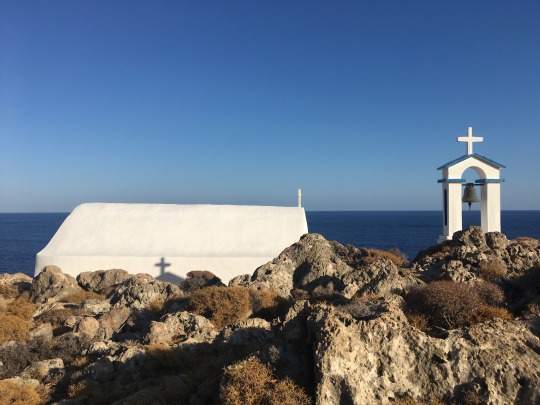
I returned to the UK with a sense of excitement about the future that I had not felt for some time. I was finally finding some direction, even a sense of purpose.
Some readers may be thinking, fine, but what about teaching? What about psychotherapy? What about helping people? Maybe you should be less selfish, maybe if you had committed to those things, you would have found that sense of purpose?
I hear you, friend reader! But I felt I did commit, to the extent that I was capable at those times, and yet I was restless. Not despairing, but not exactly happy either. Does that matter? Should it not be enough just to feel that you are doing something worthwhile? I think it does matter. Happiness creates ripples, and if you are happy in yourself, then that will have a positive effect on all the interactions you have, and on all the people you meet. The uplifting interaction with a stranger in a supermarket may have more impact than the worthiest acts that are performed by someone who is profoundly miserable. We are not the originators of love or positivity; rather, we are conduits for those qualities, and we channel them most effectively when we are happy in ourselves.
Happiness, in this deep sense, is not a purely selfish thing. It benefits others too, and in some mysterious way it may even shape the world we live in. So do what makes you happy, but make sure you understand the distinction between sensory gratification and real happiness.
But isn’t the pursuit of happiness always self-defeating? We are happy until we ask ourselves whether we are happy, and then we realise we could be happier, and that makes us unhappy… Happiness is, in the words of Oliver Burkeman, a ‘delicate two-step’: aim at it too directly, and you will lose it.
There is truth in that. But at the same time, I think that there are certain constituents of happiness that will never let us down. Two of the most important, as Freud stated, are work and love. Work, at its best, should provide a sense of purpose, and also allow us to experience a state of flow, that sense of being fully absorbed in a task. Seen in this light, work can be very similar to concentration meditation; it allows the restless mind to settle.
To be in that state of flow and get paid for it is perhaps the holy grail. But even if we don’t get paid for it, we still need it. We might then describe it as a ‘hobby’, or perhaps it is simply unpaid work (like my mother ‘working’ in the garden), but the important thing is that we are having that experience.
We also need to feel love, or else we become brittle and emotionally atrophied. But that need not necessarily be romantic love. We can love our friends, or music, or a pet, or nature, or God; the important thing is to remove the blockages from that channel.
To return to my own story, I have known for some time that I need to rediscover the state of flow. My walk across Europe had reminded me of the power of landscape to move me. Crete’s rugged beauty impressed me deeply. When I was younger, I used to paint a lot. But in my 20s and early 30s, I did not find it dynamic enough. Now I think differently; the calming, meditative quality holds an appeal for me that I was not conscious of before. I made up my mind to return to Crete and devote myself to painting landscapes. And the more I thought about it, the more it seemed the right thing to do.
I remembered a piece of advice from a letter that Hunter S. Thompson wrote to his friend Hume Logan. Logan requests career advice, to which Thompson replies: ‘…beware of looking for goals: look for a way of life. Decide how you want to live and then see what you can do to make a living WITHIN that way of life.’
When I imagine my future, I do not aspire to being surrounded by flapping assistants, chauffeured from meeting to meeting, plied with rich food and drink, signing cheques for the maintenance of houses and expensive toys. And estranged wives. No, I would much rather spend time in the landscapes that I love, building a relationship with them through meticulous observation, and recording that relationship through the act of painting. A direct relationship, not mediated through a digital screen, and – crucially – free from distractions. Hemingway said: ‘The man who has begun to live more seriously within begins to live more simply without.’ I want to live seriously within.
I have also been inspired by the film Jiro Dreams of Sushi, about an elderly Japanese sushi chef called Jiro. In my own life, I have not observed many people ageing well, by which I mean being happy and at peace with themselves and the world as they grow old. Jiro, though rather a tyrant in his restaurant, seems to me to be that rare bird: a happy old man. He still works every day, as he has done since his earliest youth, and he is driven by the same goal: to make the perfect mouthful of sushi, just a tiny fraction of a degree more delicious than anything he has ever made before. He has no interest in retirement, or even in holidays; what can they offer a man with so clear a sense of purpose?
Jiro is an artist. Perhaps he is lucky to have been born with a fine palate, and with so clear a sense of purpose. But perhaps we can decide on our purpose, and thereby make our own luck.
*
In the Amazon, the plants had not spoken to me, at least not through the medium of song. And yet, more and more, I feel that they are alive, and maybe that they do have spirits. Indeed, that all of nature is animate in that way. Painting is a way to concentrate on the natural world, and to explore these intuitions more deeply.
I know that landscape painting is not really part of the dialogue of contemporary art, but that doesn’t bother me. In fact, I think I prefer it that way. If you have got this far, you will have realised that I prefer the monologue anyway. In addition, landscape painting could have a moral dimension, since the more we appreciate the beauty and harmony of nature, the less likely we are to destroy it. Painting has the capacity not only to open the eyes of the artist, but of the viewer too. That is a worthy goal; to communicate something of the vision and the sensitivity.
Finally, perhaps I am starting to see painting as a secular form of worship; through it, I can express my gratitude for creation, and for the fact that I am here to appreciate it. And maybe that is our collective human purpose: we are nature becoming conscious of itself.
*
Back in London, I started taking Greek lessons at the Hellenic Centre. Then I bought a second-hand motorbike, tidied my affairs, and set off by motorbike for Crete. I took the ferry to Santander, arriving by night in the middle of a rainstorm, then crossed the north of Spain to Barcelona. I stayed with my old friend F, whom I had got to know 20 years before, when we both played for a rugby team in Barcelona. On the last night of my visit, his wife gave birth, two weeks early. He just managed to get her to the hospital in time, and I said goodbye to him and his wife, and their newborn baby, in the maternity ward the following morning.
I spent a week with other friends in France, then continued into Italy in the crucible of a heat-wave. Biking long distances is tiring at the best of times, but exhausting in 42 degrees, when the heat radiates off the motorway and you are clad in black leather. I had planned to bike through the Balkans, but there were wildfires in Albania, and I was finding it increasingly tough going. I crossed the north of Italy and then decided to take the ferry from Ancona to Greece. While biking the final leg from Patras to Athens, I felt euphoric; I had a strange sense of having finally come home. I thought of Cavafy’s poem ‘Ithaka’:
Keep Ithaka always in your mind. Arriving there is what you are destined for. But do not hurry the journey at all. Better if it lasts for years, so you are old by the time you reach the island, wealthy with all you have gained on the way, not expecting Ithaka to make you rich.
Greece is not my native soil, but I am beginning to feel that my journey has been a long one. Perhaps that is enough; anywhere can be home if we choose to make it so.
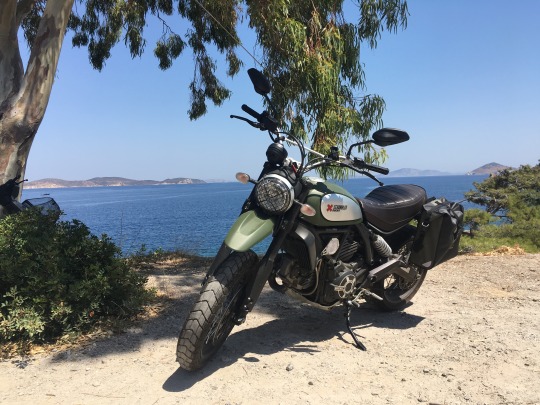
*
Except for the touristy areas, Athens in August is something of a ghost town. I only stayed a couple of days before continuing to Crete. I was afraid that it would not live up to my idealised recollections, but I need not have worried. I returned to the area I had visited in the spring, and it was as wild and beautiful as I remembered. I hiked, swam in the sea, painted watercolours, and observed the old men in the taverna at night. But despite the inspiring landscape, I soon realised that, at this point in my life, I would find life in this remote area of Crete too lonely. In addition, I am still a very long way from possessing the technical skill to paint the kind of pictures that I have in my head.
In September I returned to Athens. I started a course of intensive Greek lessons, and I spent my days crisscrossing the city on foot, getting to know different areas and looking for an apartment to rent, as well as a space to use as a painting studio. It was still very hot, and at times the language barrier could make life difficult. But things seemed to fall into place: I met good people and found spaces that far exceeded my hopes, both in terms of charm and affordability. I felt that I was experiencing first-hand my theory about positive energy: when you are happy and open to the universe and to others, then good things often fall into your lap. It seems more than just coincidence.
There are many things I love about Athens. Above all, I feel that people are less neurotic than in any other place I have ever lived. There is not the same restless quality. At times this can be challenging too; it often makes me realise how impatient I am, but that is a valuable lesson. At least once a day I have to say to myself, ‘You can’t hurry the Greeks.’
I love the absence of billboards and advertising in the city generally, and particularly on the underground. My mental space is more protected here, my consciousness not constantly invaded by disingenuous images telling me what products I need to buy in order to be happy, or what I should look like, or the kind of life that I should aspire towards. It’s very pleasant, but most Greeks are unaware of their good fortune in this respect, because it is all they know. I am tempted to draw a parallel with colour perception in the ancient world. There is no word for blue in ancient Greek, perhaps because, with all that immensity of sea and sky, the colour was so ubiquitous that the ancient eye was not trained to pick it out.
I love the fact that the bars and cafés are crowded with cheerful, attractive Athenians who will sip from one or two glasses of iced espresso all night. Their pleasure comes from conversation, from each other, and not from getting wasted.
I love the fact that this is not a nanny state. Occasionally you will see someone riding a motorbike, no helmet, cigarette between his lips, holding a phone to his ear, and with a dog perched on the fuel tank. Dangerous, yes, but free too.
There are many beautiful Greek girls. In some ways they are similar to Lebanese girls, but they are more natural looking. I love the sound of the language as they speak it. It has a delicate, tinkling quality, like a clear mountain stream.
I love the exaggerated respect that you are shown when you have to enter a PIN number anywhere. As soon as a shopkeeper or waiter has given you the portable terminal, he will retreat into a corner, closing his eyes and turning his back, as if you were handling a vial of anthrax rather than a credit card.
I love the fact that in a spinning class I went to, the strapping instructor came round before and after the class offering everyone chocolate truffles; during the class, he projected a sequence of Victoria’s Secret videos, which was an excellent distraction for me, and which the rest of the class – all girls - appeared to not to mind.
As a single person, I love the fact that in Greek the same word (‘ελευθερος’) means both ‘single’ and ‘free’.
I love the fact that internet dating has not caught on in Athens. Greeks prefer to speak to each other in person, and will still start conversations with strangers in a queue, rather than focus all their attention on their telephones. They think that there is something a little bit sad about conducting the affairs of the heart through an app, even when real world interactions mean running the risk of rejection. And, because they are less neurotic, the belief that the perfect partner is just one more swipe away has less traction.
*
Of course there have been challenging days too, particularly while I was struggling to find a place to live, owing to the boom in Airbnbs, and consequent dearth of furnished apartments on the domestic market. But often things felt not quite real. On one occasion, when I was frustrated after yet another rejection from a prospective landlord, I looked up to see a clown on an oversize unicycle cycling down hectic Piraeus street; as if the universe were telling me to take a deep breath and lighten up.
That is a just a very small moment, but it does tap into a much bigger question about the reality of the external world. For some time now I have wondered about the extent to which we are involved in the co-creation of what we perceive to be reality. I don’t think it is possible to take psychedelics and shamanic entheogens without at some point asking oneself these questions.
There is a famous thought experiment in philosophy: can we ever know that our experience is what we believe it to be, or could we just be disembodied brains in vats having our neuronal circuitry manipulated by mad scientists? In light of last year’s American election, when a clown in a toupée was elected President of the United States, the brain-in-a-vat theory suddenly seems quite plausible.
I am neither a solipsist nor an idealist in the Berkeleyan sense: I do believe that other people exist in meaningful ways, and not just because I have an idea of them. However, what interests me is the extent to which my ideas shape the experiences I have, and how they contribute to creating my ‘reality’. This is a big, and possibly unanswerable, question for metaphysics, but its implications are perhaps most evident in the field of psychology, where it has arisen in an pointed way for me in the context of making choices.
Choice is a sword with two very sharp edges. One the one hand, choice is a luxury and a privilege; the richer, more talented, more successful a person is, the more choice they often have. But on the other hand, it seems to me that nothing is quite as likely to cause neurosis, dissatisfaction, and avoidable suffering. To give a very simple example, I can find myself paralyzed before a supermarket shelf of different washing-up liquids: which is the best? Which is the cheapest? Which smell do I like best? Which colour do I prefer? What can this one do that the others can’t? On a bad day, the decision-making process is painful, probably because this one choice carries with it a little bit of all the other unmade choices in my life. However, if I go into the local corner store which stocks just one size and type of washing up liquid, I will buy it and be perfectly happy.
In small ways, I can find myself undone by choice. I am now consciously attempting to prevent those small ways from becoming bigger ways. For instance, I attend Tai Chi classes here in Athens. There are mornings when I don’t feel like going; I’m tired, or it’s raining, or I just don’t feel like it. I am currently experimenting with pretending that I don’t have a choice. I don’t allow myself to go down the decision-making path. Just do it. And I have to say that so far I feel much better for it.
Washing-up liquid and a Tai Chi class are of course very small things, but it is good to practise with the small things. The bigger things are, perhaps, choosing to move to Greece. I have moved to different countries and different cities in the past, but always in a provisional, transient way. I feel differently about this move, and that is having a beneficial effect on my own habitual inner restlessness. It is also, I think, the right kind of preparation for committing to this new career, and possibly even to a person.
Maybe I have just been rather slow to adopt this strategy. Years ago, I joined a Canadian-American friend in a cross-country skiing marathon from Norway to Sweden. My friend is affectionately known as Captain America, owing to his chiseled chin and robust all-round competence. I had flu on the day of the marathon and was running a temperature, not at all pleasant in -20 degrees. My progress was very slow, also because the phlegm in my lungs kept making me retch. My friend stuck loyally by my side for the first 30 kilometers or so, then – in a moment reminsicent of a Vietnam movie – I persuaded him to push ahead at his own speed. Captain America’s parting words to me were, ‘Remember: failure is not an option.’ I am not sure whether I found it all that motivating at the time, but now I recognise the effectiveness of that attitude.
But for me there is one problem with this approach, and it is a problem of intellectual consistency. Unfortunately, the pretence that I don’t have a choice does not sit well with my commitment to the existential perspective, as formulated philosophically by Sartre and psychotherapeutically by Irvin Yalom. Central to the existential perspective is the recognition that we have total choice, and total responsibility for our lives. There is no human ‘essence’; it is up to us to make of ourselves what we will. We are ‘condemned’ to be free, and any attempt to shirk that freedom is intellectually dishonest, personally inauthentic, and breaks faith with life (Sartre terms it ‘mauvaise foi’, bad faith).
Is my pretence that I don’t have a choice an example of bad faith? I’m not sure. It is a strategy that enables me to circumvent my own neurotic tendencies, a strategy that would have prevented Buridan’s ass from starving. Indeed, Buridan’s ass may have had a very happy life had he adopted it. And in my own case, it has not made me shrink from life. Quite the opposite: I have committed to Greece, to landscape painting, to learning Greek, and to practicing Tai Chi… all of these are slow processes, and this strategy helps me get over the little ups and downs. But I would not have been able to make these changes and commit to these things if I had not recognized my essential freedom in the first place.
This conflict is just a shadow of the more serious one that arises from my growing conviction that there are karmic principles at work in our lives. I am increasingly persuaded by the sages, mystics and monks who believe in reincarnation and who say that the point of our many lives is to lead us, finally, to liberation. There are many things I don’t understand: what aspect of ‘us’ gets reincarnated? How is it all organised? How can there be more people alive today than ever before? But what I like about reincarnation, and what seems intuitively correct, is that there is a point to our lives. Every new incarnation gives us the opportunity to burn through the accumulated negativity of past incarnations. Nothing happens by chance. The relationships that we have in this life are reconfigurations of similar constellations from the past; they repeat themselves until they have been fully resolved. When ‘bad’ things happen to us, they present us with the opportunity to resolve the blockages that are holding us back, and to grow in precisely the ways that we need. This is the amor fati of the Ancients; but is it true? Or is it just wishful thinking, the Panglossian optimism that Voltaire ridicules in ‘Candide’?
A part of me wants to follow Pascal and his wager: we can never know for sure, so why not believe what is most beneficial? There is no doubt that I am happier believing that there is a point to my life, that it is one of many lives, and that suffering has a reason and a purpose. Of course, one cannot choose to believe just anything. But I don’t have to try to force myself to believe this; it is in line with my intuitions.
As I have already indicated, I am increasingly persuaded by the idea that we are involved in creating the reality that we experience. Convince yourself that failure is not an option, and you are more likely to succeed. But does the same hold in the field of metaphysics? Do our thoughts, either individually or collectively, create the ‘reality’ we experience? I think that probably is the case: in significant ways, we think the world into being. The objective and subjective worlds are not completely distinct; if they are separated at all, it is only by a porous membrane. If you believe in reincarnation, then the belief alone may be enough to make it true. This is the perspective of many peoples and cultures down the ages: thought is primary and thinking (or dreaming, ‘dream-time’) creates the reality we experience.
Interestingly, there is no way to disprove this theory. If Western science looks at indigenous beliefs and shows them to be false – i.e. a mistaken representation of the way things really are – this is in fact exactly what the indigenous perspective would expect, since Western science is also just another reality that has been thought into being. There is no ‘way that things really are’; there are just different ways of thinking, and these create different realities.
Belief in reincarnation and the doctrine of karma also seems to presuppose a deterministic world. I once consulted a Vedic astrologer in South India; his reading of my natal chart was astonishingly accurate, and specific. I questioned him about the assumptions underlying the reading. He confirmed that, from the Vedic perspective, the world is fully determined. The outcome of this life, and of all future lives, is already known. We will never change the course of our lives – even the changes that we think we make have already been determined – but we can watch our lives unfold with curiosity.
Does this make life pointless and boring? Not at all. The Vedic astrologer drew the following parallel: Harry Potter’s life has been fully determined by the author, nevertheless, Harry himself does not know the outcome, and his life in each book is still vitally interesting to him - he believes that he is meaningfully shaping his future, although the author has already decided it.
What to make of this parallel with a fictional character? If thought creates reality, then in a sense we are fictional characters, either created by ourselves, or by some much greater ‘author’. Can this parallel shed light on the question of how to resolve the conflict between the radical freedom of existentialism, and the determined universe of reincarnation and Vedic thought? I don’t know, but I feel that resolving this conflict – at least to my personal satisfaction - may be the major intellectual task of the rest of my life.
In fact, it is a task that I have already embarked upon. Part of the reason why I am attracted to Zen Buddhism is because it appears to take one beyond rationality, to a world of pure awareness, a world that is not subject to the rules of thought, and that transcends conflicts of logic. The point of the Zen koan, as I understand it, is to shake us out of our ordinary way of thinking, and to give us an intimation that the world in its suchness is not as we assume it to be. These ideas are hard to frame in language, because language is itself a function of the rules that govern thought (non-contradiction, identity and so on); what Zen attempts to convey is a different perspective, beyond reason and hence also beyond ordinary language.
In the end – at the end of life, at the end of thought – perhaps the best model is provided by the ancient lama in Rudyard Kipling’s ‘Kim’. At the end of his pilgrimage, he returns to the mountains and says: ‘These are indeed my hills. Thus should a man abide, perched above the world, separated from delights, considering vast matters.’
*
I am finally content where I am, and not ready to perch above the world, separated from delights. But nor am I free from all anxiety. I do, for instance, wonder whether I will ever be able to paint landscapes that will match the images in my head. But here again Jiro Dreams of Sushi has provided me with inspiration. From that film, I learnt that a sushi chef in Japan spends the first two years of his career just learning how to make rice. One cannot rush things. Start small, and stay the course. In my own case, I will start with still lives, and little by little, improve my technique (should you wish, you can follow my progress via instagram: konrad_ratibor_bohemian). If I find flow, and practise diligently, then I am hopeful that one day I will create work that I am happy with. But perhaps, in order to retain the sense of purpose, one must always keep aiming a little bit higher, as Jiro does.
The life of an artist may seem very self-involved to you. It often does to me. But then I think that perhaps the greatest contribution that anyone can make is to find a way of life that makes them happy, and to share the path that got them there. Maybe in the end it can be the artist’s life that inspires others to follow their own passion, whatever it is, and realise happiness for themselves. I will conclude with Dr. Hollis’ formulation of the same sentiment in ‘What Matters Most’:
‘Maybe all of us will learn to grapple with the paradox that living our lives more fully is not narcissism, but service to the world when we bring a more fully achieved gift to the collective. We do not serve our children, our friends and partners, our society by living partial lives, and being secretly depressed and resentful. We serve the world by finding what feeds us, and, having been fed, then share our gift with others.’
1 note
·
View note
Text
My Zen Rakusu
After three months investigating plant medicines in the Amazon, I flew to Japan with my friend S. My first visit was back in 2009, also with S, who lived there in his teens and speaks fluent Japanese. On that occasion we visited the ancient monastery complex of Koya-san, in the mountains south of Osaka. It was winter, and snowing, and I remember watching a monk sweeping the entrance to one of the monastery buildings. He did it so beautifully, and seemed so at peace with himself and the world, that I resolved that one day I too would visit a monastery in Japan and participate in monastic life. This trip to Japan, which would coincide with sakura – the cherry blossom period – seemed like the right moment, and a good way to consolidate my recent experiences.
Since returning from that first visit in 2009, I have become increasingly fascinated by Zen. At that time I was living in San Francisco. I read Kerouac’s ‘Dharma Bums’, and I followed in his footsteps by climbing up Matterhorn Peak in the Hoover Wilderness. I read D. T. Suzuki, and I tried to get to grips with haikus and koans. I read John Welwood’s ‘Gradual Awakening’, and I was very struck by his description of a meeting with the Tibetan teacher Chögyam Trungpa Rinpoche. Welwood wrote:
‘I remember once walking into a room for an interview with him and being astounded by the vast space that seemed to radiate from him in all directions. It felt as though the roof and walls of the room had been blown out. Never having experienced anything like that before, I found it tremendously magnetic.’
In addition to Zen, Japan has also provided me with both the most and least romantic experiences of my life. The former happened on that first visit in 2009, on a freezing night in Tokyo, in an all night florist’s. I met a gentle lost American girl, and paid for her flowers, and we walked for a while together and parted company on a windy street corner. We said goodbye with tears in our eyes, maybe because of the wind, but also because of the transience of life, and the other outcomes almost possible but not, and the things unsaid and maybe unsayable.
The least romantic experience happened on a visit a couple of years ago, also in Tokyo, at the tail end of a long and humid summer. I must have been spiked with Rohypnol, or a similar dissociative ‘predator’ drug, since I have almost no memory of the night, something that has never happened to me before. The same thing happened to the friend I was with, and we later read online warnings from the US embassy about Nigerians in that area of Tokyo who were known for these nefarious activities. The drugs don’t knock you out, but they make you immensely suggestible; the snippets of memory I do have are of walking to numerous cash machines, accompanied by my new Nigerian ‘friends’; exceeding the withdrawal limit on all my bank cards (as I later pieced together from the receipts I found screwed up in my pockets); paying for large quantities of alcohol in a succession of seedy bars; and canoodling with two Columbian girls who, in retrospect, were almost certainly not the sweet, unbiased, and reciprocally enamoured civilians that I assumed at the time. And then coming home the next day, rather dazed, with a wallet mysteriously empty not just of Yen, but of all the foreign currencies too.
On that visit two years ago, I also went to Kanazawa, a city on the west coast about halfway between Kyoto and Tokyo. I fell in love with Kanazawa: it is less touristy than other places, boasts the Kenrokuen gardens – the most beautiful Japanese gardens I have ever seen - as well as the D. T. Suzuki museum, whose two or three exhibits are not nearly as significant as the building’s clean lines, contrasting textures and calming use of space.
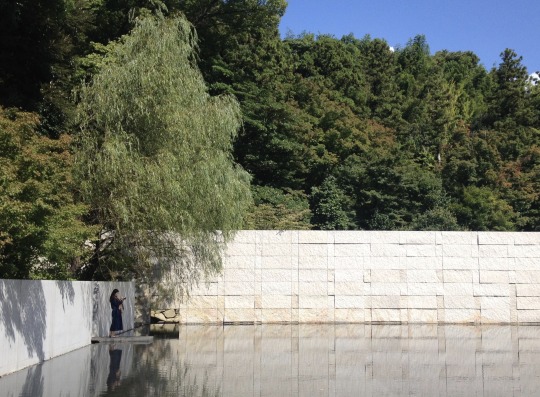
D.T. Suzuki museum in Kanazawa.
But above all, I fell in love with Kanazawa’s 1950′s American aesthetic, the kind of thing that Kerouac would have seen during his travels back and forth across America. And the light is reminiscent of Edward Hopper’s magnificent, lonely, brave paintings from the same period.

Kanazawa, oddly reminiscent of Kerouac’s America.
I always wanted to return to Kanazawa, and I was very happy to discover that there is a Zen temple in Kanazawa that hosts visitors. I found an email address for the Guestmaster and wrote to him. My email went unanswered, so I wrote again, and again. I was not dismayed, since I knew of the Zen tradition in which an aspirant for instruction is turned away by the Master the first three times, though he should be accepted on the fourth. This proves that the aspirant is serious. In addition, a Master should always be asked to teach, rather than offer to do so; presumably, this ensures that the teaching is given for the right reasons, and not to inflate the teacher’s ego, or win fame.
However, the Guestmaster never answered my emails, so I asked S to accompany me to the monastery in order to present my request in person, and in Japanese. We stopped in Kanazawa on our way from Kyoto to Tokyo.
Kyoto abounds with Zen temples and gardens, and we had visited a number of them. They are small, beautifully maintained, but also busy, and you have to pay to enter each one. Daijoji Temple in Kanazawa, by contrast, was a much bigger place, surrounded by tombstones on a wooded hill on the outskirts of town, with a view of the distant ocean. Enormous old trees cast dappled shade and created the sense of peace that I remembered from my visit to snowy Koya-san, where I had seen the sweeping monk. The huge and imposing red entrance gate was open, so we entered the temple enclosure and wandered down ancient wooden colonnades and past ornate Buddhist warrior carvings. There was no one around, and it was unnerving, but also magical, to be able to explore this space all by ourselves.
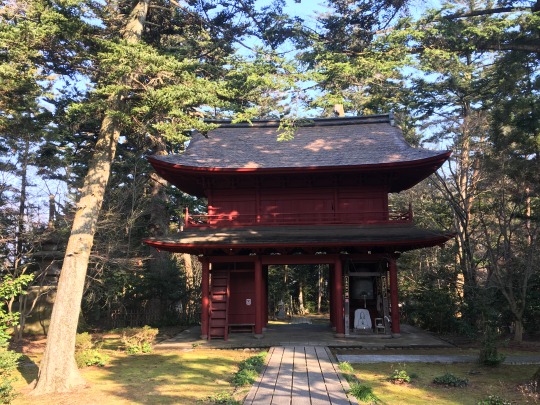
Daijoji Temple, Kanazawa
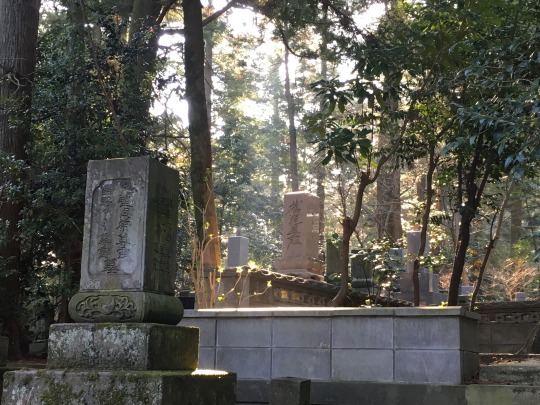
Eventually we found a monk who was in the middle of performing his chores with a dishcloth tied round his head. S explained my request. The monk looked very surprised. Another, chubbier monk then arrived. He was more senior, and S repeated the request, adding that I had already emailed three times to the Guestmaster. This caused both monks some embarrassment. The chubby one disappeared for a while. On his return he explained that if I were to stay for a week, as I was hoping, then my visit would coincide with ‘seishin’, the intense five day period of meditation that happens once a month. Would that be ok? I tried to appear confident and said that it would. In that case, they said, they would present my request to the abbot, and we should telephone the monastery that evening to hear the result.
Back in our hotel, I was feeling nervous, so I went to the sauna and watched a sumo match on the tv in there, alongside a lot of elderly Japanese men. On returning to our room, S informed me that my request had been accepted. I was jubilant, though at the time I didn’t fully realize what I had committed to.
When I returned to the temple a few days later, I was greeted by Godo Roshi, the monk in charge of novices, and the only one who spoke some English. I picked up my futon and followed Godo Roshi down a series of paper-paneled corridors - confusing since the doors and panels look the same – to my room, a small empty space enclosed by more paper panels. On the way, I had to change from outdoor shoes to sandals to slippers and finally to socks, an action that I would end up repeating countless times every day. On this first occasion, I was paid the only verbal compliment that I was to receive all week: when I placed my slippers on their shelf, Godo Roshi nodded his approval and said, ‘Very elegant.’
I had been given a timetable as well as a short book on Zen, in English. The timetable came as a bit of a shock. Every moment of the day was accounted for, down to five minute segments. I would have to be up at 4.30am every morning for an hour of seated meditation (zazen) in the the zendo, followed by half an hour of sutra chanting in the main hall, then an hour of floor cleaning, then breakfast at 7am, a brief rest, and 10 more sessions of zazen throughout the rest of the day, alternating with more chores and brief rest or study periods.
Despite going to bed early (around 10), the mornings were tough. My visit had coincided with a cold snap. The temperature dropped to 3 degrees at night, and it was no warmer inside the monastery than out. By day, when the sun shone, it was in fact colder inside. And I was not allowed to wear either a hat inside, or socks inside in certain parts of the building, so it was often a struggle to keep warm.
I found mealtimes to be more challenging than the sessions in the zendo. Zen is very highly codified, nowhere more so than during meals. There are precise actions to be repeated every time, and I am sure there were many more of which I was unaware. Meals are the same every day: gruel for breakfast, rice with sides for lunch and for dinner. The bowls have to be placed in the correct formation and chopsticks angled in the right directions to accompany each phase of the meal. Food has to be wolfed down at lightening speed. This is partly because it is rude to finish after the abbot (who, despite being ancient, is a champion speed eater), but the deeper reason is so as to avoid developing an attachment to the pleasure of taste.
I found it very hard to wolf down rice using chopsticks. I was invariably the last to finish, and although the other monks were never so impolite as to stare at me, it is nevertheless disconcerting to be stuffing your cheeks like a chipmunk while 8 impassive Zen monks sit around you, models of stony-faced silence.
At the end of the meal, you have to leave two slices of horseradish in the top left hand bowl of the four in front of you. Hot water is poured into that bowl and you use the horseradish slices to mop the inside, pushing them around with your chopsticks and thereby cleaning the bowl. The water and horseradish slices are then poured into the other three bowls, in the right order of course, and finally the resulting liquid is swallowed. It doesn’t taste bad, and obviates the need for all but the most superficial washing up, which is performed in a similarly ritualized way by the novices and junior monks. At the end, you stand in a circle and say, utz gari sama desda, which means, thank you for your work.
This may all sound fairly torturous, and in many ways, it was. And yet, after a few days, I found myself feeling more relaxed, and happier, than I have for a long time. In part, I am sure this had to do with the digital detox - the blissful escape from constant connectivity. The fact that every moment of the day was accounted for, and there were no choices or decisions to be made, also contributed to an increasingly deep sense of tranquility.
Zazen itself is very simple, there is only one instruction: just sit. Do not think. Do not worry. Do not plan. Do not feel regrets. Just sit, in the correct posture, and observe. Do not follow thoughts, or try to block them out. Watch them arise, and let go of them. It sounds so easy, but of course, it is not.
The other forms of meditation I have encountered have focused on an object, such as the breath, or a mantra, or a particular emotion. But zazen, with its emphasis on not doing anything, seemed particularly beneficial for me, given the restlessness of my mind.
Of course, without any mental discipline at all, a session of zazen is likely to descend into one long reverie. But in Zen, I think that the discipline comes not from the meditation itself, but rather from every other aspect of life. That is why everything is so highly ritualized. You constantly have to focus – on how to change your footwear, how to eat, how to wash up. Mental discipline is learned through the hundred thousand other aspects of daily life, so you are in a much better position to truly ‘just sit’ when it is time to meditate.
That is one very sensible aspect of Zen. Another is that you always meditate with your eyes open, though unfocussed; it is very hard to fall asleep when your eyes are open. And also, sessions only last 50 minutes, which is about the maximum concentration span for most people. Zazen is followed by kinshin, a few minutes of very slow walking meditation. It is a good way to finish.
After the first morning session (in the dark), and the sutra chanting (a rather obscure business, and the most highly ritualized of all), my duty was to mop the long corridor, using a wet rag. It was a very simple task, and of course a repetitive one, though doing it well, and elegantly, was actually rewarding. And this is another aspect of Zen: you do things for their own sake, and not as a means to an end. That is what makes them meaningful. And that is also the key to unlocking Japanese culture, which can often appear so obscure. Everything is done to the highest possible level, because that gives it meaning.
As I mopped the floor in my bare feet, and with my breath condensing in the cold air, I was surprised to be feeling content and at peace with the world. The German words ’Arbeit Macht Frei’ (work makes you free) came to mind. Yes, there was a form of liberation in what I was doing. It was so menial a chore, and yet I was happy. There was nothing to desire, and no choices to be made; where were the causes of suffering? But then, with a jolt, I remembered where those three words had been most famously displayed: above the entrance gate to Auschwitz. How utterly incongruous, a Buddhist truth taken up by a concentration camp. The monastery was nothing like a concentration camp, and it was certainly strange that a truth hidden in those words should crystallize for me here.
*
That first evening a girl called Aida, from Azerbaijan, passed by the monastery to explain a few things to me. Aida spent 6 years in the monastery but is now teaching Japanese culture at Kanazawa university. She is a true polymath. In order to be able to stay in Japan, she had needed a student visa, and so, with no prior knowledge of Japanese, she had done PhD in neuroscience, in Japanese. She was also fluent in Russian, Arabic, Turkish, English and Spanish, as well as Azerbaijani.
A few days later, with Aida as interpreter, I had my first formal interview with the abbot. He presented me with my own rakusu, the Zen Buddhist bib - sewn together from 16 or more strips of cloth - that is worn around the neck. The rakusu represents lay ordination. On the inside, the bearer’s name and status is painted in elegant calligraphic kanji, using jet black ink on a white silk backing. The abbot turned the bib around, and Aida translated the writing: Claus von Bohlen, London representative of the World Zen Centre based at Daijoji Temple, Kanazawa.

A Zen monk wearing his rakusu
Aida was laughing a lot. Did it strike her as so ridiculous, or was her bright humour the result of 6 years in a Zen monastery? I never found out. She showed me how to wear the rakusu, and how to fold it and replace it in its silk envelope – predictably complicated. Then she asked me how I felt.
‘Elevated,’ I said. Aida translated. The abbot nodded.
I was to see Aida on two more occasions, and it was a relief to be able to ask her some more detailed questions. My interactions with the other monks were very basic. The monk in charge of my training spoke no English at all. On a number of occasions, he needed to reprimand me (most severely, when I arrived one minute late for my solitary evening meditation session). He relied on the voice activated version of google (mis-)translate, with frequently bizarre results. He said something in Japanese into his phone, and then held it towards my ear: ‘Do not shit on the elephant. Everything is training.’
The chubby monk whom I had met on my first visit to the monastery was a very kind man. I think he felt sorry for me because I had to request half-portions in order to finish my meals on time. In the evenings, he occasionally passed by my cell to present me with biscuits or the peculiar chewy rice cakes called mochi.
When it came to the meditation itself, no instruction was given. The book was a help, as was one comment that the chubby monk made: ‘Do not do zazen. Be zazen.’
And this, to me, is the endless fascination of Zen. So simple, and yet so very difficult. Just sit. Be zazen. And the truisms: wherever you go, there you are… So obvious, and yet how easy it is to think that one can run away from troubles, when in reality we carry most of our suffering around with us. And then the haikus, so mundane, and yet they imply the whole world by its absence, in the same way that the negative spaces in a drawing create the solid image. So very elliptical, so very Japanese.
My favourite, I think, is by the 19th century poet Masaoka Shiki:
Butterfly asleep on a stone
You must surely be dreaming
Of the sad life of me.
Zen is profoundly artistic: it is about harmony, and beauty, about doing things for their own sake, and also about impermanence and transience and time’s inexorable decay. From the perspective of Zen, everything can be an object of meditation, nature above all, most famously in the form of cherry blossoms and the turning of the leaves in autumn. They all bring home the fundamental truth of impermanence, and so much of human suffering stems from the attempt to escape or repress that truth.
On one or two occasions during zazen, I experienced moments without thought - the spaces between thoughts. Of course, as soon as I became aware of it, then the unverbalised moment was lost and thought once again entered the picture. But those few moments consisted of pure awareness, pure consciousness without objects or boundaries. They made me realise that all my life I have seen the world from one perspective, or in one dimension; this felt like an entirely different vantage point, a whole new dimension, and one that dwarfs all that I have known up until now. They were just glimpses, but they were sufficient for me to understand why a person might devote their entire life to the practice of Zen.
These were my thoughts as I left the monastery. The cold snap had passed, the breeze was a caress, and the cherry blossoms were just on the point of exploding like pink powder puffs in the Kenrokuen gardens. And I was homeward bound.
*
Back in the UK, I stuffed all my clothes into the washing machine. As Jack Kornfeld said, ‘After the ecstasy, the laundry.’ But in doing so, I overlooked the black silk envelope that contained my Zen rakusu, and it also went into the machine.
When I subsequently took the rakusu out of the washing machine, I saw to my horror that the beautiful calligraphy bearing my name had almost been washed out of the white silk lining. My heart sunk. I had worn the rakusu for one of the most challenging weeks of my life. I was proud to have got through it, and proud of my official status as representative of the World Zen Centre. I cursed my stupidity, but the irritation sat like a stone in my chest.
And then I realised how long the road is. This was suffering: my attachment to an object, to the status it conferred, and to an idea of myself. This was pride, and vanity, and desire, and all those emotions that cause suffering again and again. Sometimes desire can be satisfied, or pride validated, but the relief is only temporary, and the cessation of pain should not be confused with happiness.
But is it so simple? Does attachment always cause suffering? And isn’t suffering a part of what it means to be human, and to lead a full human life? Should we really aim not to feel attachment to our families and loved ones? These are difficult questions and I do not have the answers. I suspect that there is a middle way, a balance somewhere: it must be possible to love without clinging, to give without needing anything in return. But it is very hard. And like so much in this field, the balance is a delicate two-step, an oblique sideways glance: we find happiness when we cease to chase it; we alight upon one-pointed concentration when we stop trying to force it; and love is purest when it is based on surfeit and not on lack.
That is what the laundry taught me.
1 note
·
View note
Text
San Pedro, The Gatekeeper
Otilia and I decided to travel from Pucallpa to Lima by bus. The journey would take a full 24 hours, but I had bought us tickets for the ‘luxury’ seats on the top deck, and I knew that we would be climbing up into the mountains and passing through some scenic and remote areas, and so I was looking forward to the trip. I should not have been.
Our luxury seats were right at the front of the top deck. The huge windscreen in front of my nose had a deep crack running across it. My seatbelt was broken; I immediately had visions of being vomited through the window in the event of a collision.
It was midday when we boarded, and the sun was concentrated through the front and side windows; I felt like an ant beneath a sadistic child’s magnifying glass. And of course, the much vaunted air conditioning was not working. But there were no empty seats, so I sat down in mine and sweated as if I were in a sauna. Otilia, beside me, was totally unfazed and luxuriated in her reclining seat.
The bus attendant came up to announce that the bus would not be stopping between Pucallpa and Lima. If anyone wanted to go to the toilet, they should inform her, and a stop would be organised once there was a big enough group. I was surprised by this, and disappointed, since the only pleasure of bus travel is stopping at different places along the way to eat roadside meals and take in the changing scenery. However, the reason became clear when a succession of soldiers boarded during the night, as ‘protection’. We were passing through contested areas and hold-ups sometimes occurred.
The bus attendant then put on the first dvd. The screen was in the middle of the bus, about two feet from my nose, and slightly to my right. I had to turn my neck to see it, but there was no way I could escape it. The sound was on full: the quality was terrible, but the volume was deafening. First up was a surfing movie in which an attractive blond surfer chick had her arm torn off by a shark. My worst kind of movie. I survived it, just.
As soon as it finished, the attendant reappeared and put on another movie. Another surfer movie, in fact, in which the attractive blond surfer chick discovers an untouched beach in Brazil, goes surfing, and gets mauled by a shark who then cuts her off from the beach. Fortunately that was the last of the shark attack movies, but the playlist continued for the full 24 hours: as soon as one finished, another was put on. For me, it was torture. The Peruvians loved it.
Darkness fell as we started to climb into the mountains. The temperature dropped sharply. My sweat-soaked t-shirt had now dried, but I had developed a sore throat. I took a valium and soon fell asleep, despite the full volume intensity of the tv.
When I woke up, in the middle of the night, my t-shirt was again soaked, but this time because the warm, recycled air in the bus was condensing on the cold metal frame of the skylight above my head, and dripping onto my chest drip drip drip like Chinese water torture. I put on my rain jacket and went back to sleep.
I woke again when we were just a couple of hours outside Lima. I immediately coughed up some very solid phlegm, as I would continue to do for the next couple of weeks. But we had run through the collection of dvds and the silence was a blessing.
Otilia and I parted company in Lima. She returned to her terreno in the jungle, and I flew to Cusco, the historic capital of the Inca empire high in the Andes. I was planning to take San Pedro, a cactus that has been used by the indigenous people of the Andes in a similar way to ayahuasca in the jungle. The indigenous name for San Pedro is ‘huachuma’, and a San Pedro shaman is a ‘huachumero’. The cactus is similar to Mexican Peyote – both contain mescaline. The earliest known depiction of the cactus is on a carving from the Chavín culture; the carving is of a mythical or shamanic figure holding the cactus, and it dates back 3000 years.
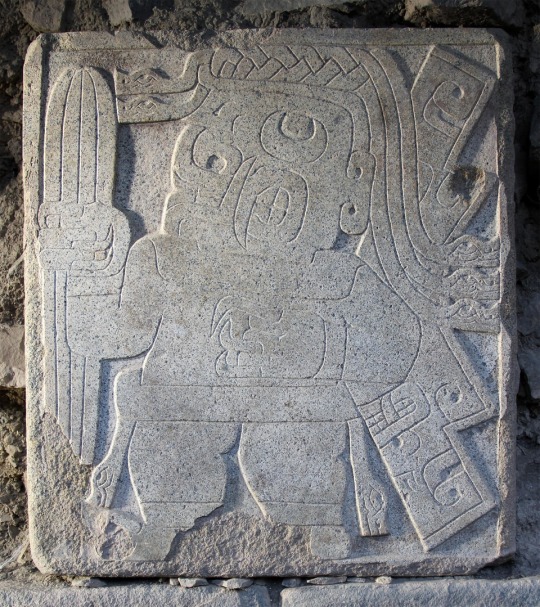
Stone relief of mythical or shamanic figure holding the huachuma cactus.
I had read an informative book about San Pedro by the British psychologist Ross Heaven. The book is entitled ‘Cactus of Mystery’; not, perhaps, the most imaginative title, but perhaps preferable to one of the other indigenous names for the cactus, ‘Penis of God’.
The Andeans believed that huachuma had the power to provide direct, unmediated access to the Divine. When the Spanish arrived, they of course tried to suppress or eradicate any native tradition that conflicted with Catholic doctrine. The knowledge of huachuma persisted, but it went underground, and the cactus was given the new name of San Pedro, since it is San Pedro – or Saint Peter – who holds the keys to the gates of heaven, according to Christian belief.
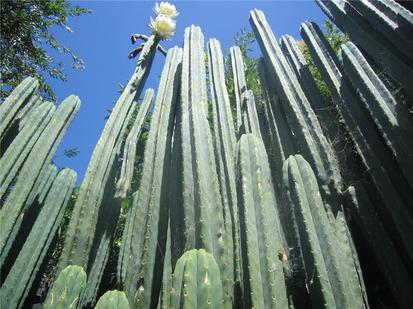
San Pedro/ Huachuma/ Cactus of Mystery/ Penis of God
I wanted to take part in a ceremony guided by ‘La Gringa’, a South African lady who had lived for years in the Andes, and who had studied extensively with indigenous ‘huachumeros’. Despite my reservations about decontextualized shamanism – and La Gringa was obviously not born in that tradition – I was keen not to repeat the experience with Rodrigo the sorcerer. In addition, I knew that La Gringa conducted her ceremonies by day, in her garden near the ancient Inca Temple of the Moon. Daytime ceremonies are unusual even with San Pedro, but after the many night ceremonies of the preceding weeks, the thought of an altered state experienced in sunlight was very appealing.
On the morning of the ceremony, the participants met at La Gringa’s bed and breakfast in the pretty San Blas quarter of Cusco, then we were driven by taxi to her house in the hills above the city. The air was even thinner up here – we were at around 4000m – but it was a clear day and the sunlight was intense. We filed into the maloca – a young Turk, two well-fed Americans, a potato-nosed Polish girl, a wiry Korean couple and a Canadian nurse.
La Gringa was back in South Africa so her son was conducting the ceremony, with the help of a shaman (or ‘Paco’) from the Q’ero tribe, who still live in one of the most remote valleys in the Andes. La Gringa’s son was in his forties, tall, well-built; with his blond pony tale, clip-on sunglasses and motorbike jacket, he looked like a rockstar. He gave a short introduction about the nature of San Pedro and the importance of not fighting the experience, but rather trusting that it would help each of us to address those aspects of ourselves that most needed addressing in order to live and love fully. Then the glasses of San Pedro were poured out and handed around – a tumbler full of cold, slimy green liquid; bitter in taste, though nothing like as unpleasant as ayahuasca. We were advised to down it in one.
The effects took about an hour to make themselves felt. During this period, we wandered silently around the garden, or found a shady spot to sit in and call our own. The potato-nosed Polish girl vomited. The Korean husband dropped to his hands and knees and emitted a series of bloodcurdling roars. The Paco – the Q’ero shaman – jumped into action and performed an ‘energy cleansing’ by blowing smoke at the Korean and beating the air around him with a long condor feather. After that, the Korean calmed down, removed his shirt, and sat cross-legged on a rock for the next few hours, immobile as Shakyamuni himself. I later discovered that he was a Tai Chi master.
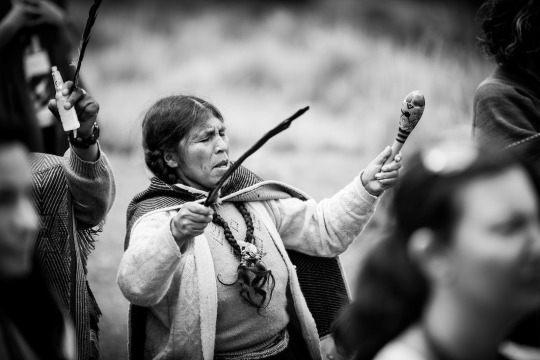
A Q’ero Paco performing an ‘energy cleansing’ (?)
For my part, I sat with my body in the sun, my head in the shade, and watched the hummingbirds dip their long beaks into the brightly-coloured flowers. And, little by little, I felt the return of a sense of wonder, and gratitude, and all those sweet qualities that explain why San Pedro is called ‘heart medicine’. I was reminded of something that Otilia had said to me in the jungle: we should be happy, because ‘el aire es perfumado’ - the air is fragrant. And from then on, I couldn’t stop smiling.
I sat there all afternoon, occasionally playing with La Gringa’s dogs that roamed the garden, at other times lying on my back and watching the clouds. I felt that this was the reward after all the bitter medicines and nights of nausea in the jungle. Ayahuasca and San Pedro are complementary, but these were definitely the sunny uplands.
*
As the San Pedro was beginning to wear off, we were taken for a guided walk around the Temple of the Moon, a large rock platform that juts out of the valley floor. The Polish girl had recovered from her nausea but was now in floods of tears. We helped her up the steep tussocky grass to a man-sized crack in the rock. This was apparently a birthing canal. We were to enter it one by one and formulate a resolution to carry us forward. It was dank and cold inside. The Polish girl re-emerged having smeared her face with mud through which her coursing tears cut meandering tracks.
After the walk, we were given tea while we waited for the taxis to arrive to drive us back down to Cusco. I was not ready for the city, and I didn’t feel like a taxi ride down a steep, winding road, so I decided to walk back. I had been up to the Temple of the Moon the day before, on a little hike, and I was confident I could find the way back to Cusco.
It was a good decision. My whole body was still vibrating at a heightened frequency as I walked past the 500 year old ruins of Sacsayhuaman, their diamond-sharp geometry as perfect as the day the stones were chiseled. It was an experience to savour. But darkness had fallen by the time I arrived home, and it had started to rain, and I was exhausted, dehydrated and somewhat frazzled. I enjoyed possibly the most beneficent hot shower of my life.
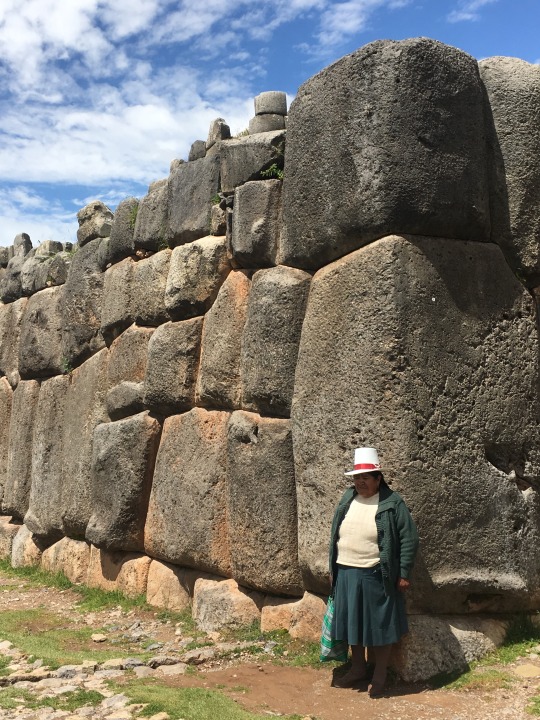
Sacsayhuaman
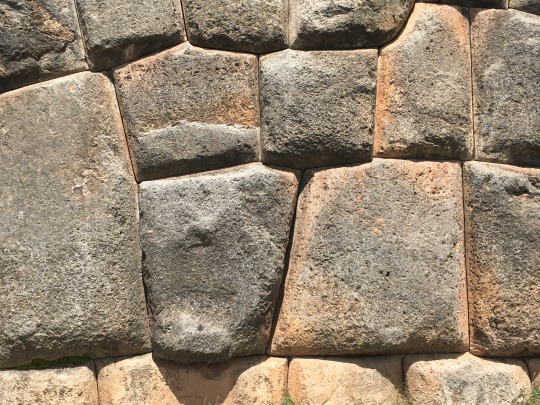
*
Two days later, I returned to La Gringa’s garden for my second San Pedro ceremony, and the final entheogenic adventure of my travels.
I was full of happy anticipation of another pleasant afternoon.
This time we were a bigger group, and the ceremony was led by La Gringa’s other son, an identical twin who shared the same rockstar appearance but was, if anything, a bigger physical presence, and a less gentle one. There was not enough fresh San Pedro to go round, so I was given a powdered version, apparently La Gringa’s favourite. I found it considerably more unpleasant - like trying to drink a glass of sand - and stronger.
After the usual formalities, I found my little spot in the garden, but I did not feel quite the same ease as the first time. La Gringa’s son came to sit next to me. For a while we sat in silence, then he told me that I needed to let go of my ego. I found that rather presumptious; he didn’t even know me! But in truth, I also knew that he was right, and perhaps that very reaction confirms it. I do have a certain idea of myself, and I can see that it frequently holds me back, and is not in my own, deeper, best interests. I don’t think I am alone in this.
As the day progressed, I began to notice a low level nausea, but interestingly, I was in control of it. That is to say, I could choose whether to engage with it, in which case it began to swell, or I could place my attention elsewhere, and block it out for long periods, though never eradicate it. But we were now six hours into the ceremony, and I was pretty sure that the nausea was not the kind of nausea that one gets from eating something unpleasant or poisonous. It went deeper than that and was mental before it was physical.
Everyone else was getting ready to go on the walk around the Temple of the Moon, but I decided to stay behind to address the nausea, or the blockage, or whatever it was. Alone in the garden, I propped myself against the wall and stuck my fingers down my throat. Again and again, tidal waves of granular green gunk exploded out of my throat. There seemed to be no end of it. But it felt great! I vomited again and again, each time letting go in deeper and deeper ways. The message was so clear: just let go! Let go of your ego! Let go of your restlessness and discontent and all the habits that do not serve you, familiar and comforting as they may be. Let go of fear - fear of change, fear of failure, and fear of fear itself. But above all, let go of the illusion of ultimate control, because it is just that: an illusion. And enjoy the ride!
In that moment, a weight lifted from me, and I had the sense of having taken a huge step forwards. I looked up at the sky, now preternaturally blue and alive with sparks and geometric patterns. In front of me, the wall was moving and reconfiguring itself in the characteristic blocky shapes of Incan, Mayan and Amerindian hieroglyphics. I was later to see these - or very similar ones - in Lima’s museum of archaeology and anthropology, carved into the granite Tello obelisk from the 3000 year old Chavín culture.
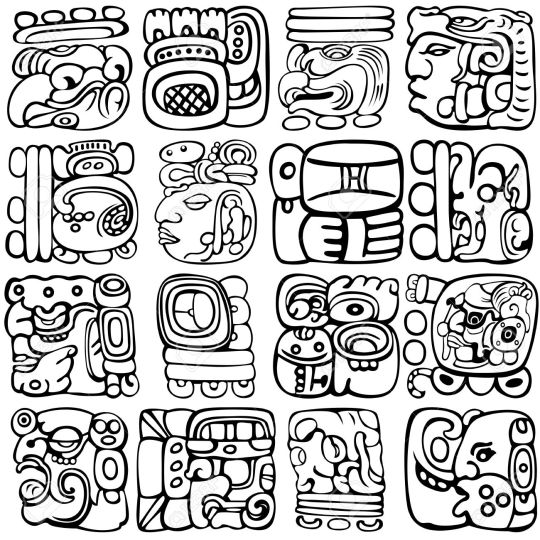
The blocky hieroglyphic figures that appeared on the wall.
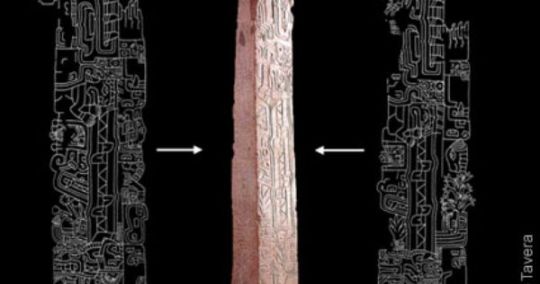
Chavín’s Tello obelisk
It dawned on me that the visions of ayahusca and huachuma are not the way they are because of the creative aesthetics of the cultures that use those plant medicines. It is most probably the other way around: these substances act on the human mind in certain universal ways, perhaps providing access to the collective unconscious, and the visions glimpsed under their influence have been immortalized in the temples and sculptures and carvings of the cultures that used them as sacraments and entheogens.
As I spat out the last of the sandy, gritty huachuma, I looked around the garden, now so clean and spacious and crystalline, and I took a deep breath of fragrant air. Yes Otilia, el aire es perfumado.
0 notes
Text
Travels with my Shaman.
I wrote my last post in a café in Iquitos, in the Peruvian Amazon, back in January. At that time, I was shuttling between Iquitos on the weekends, and the jungle clearing (‘terreno’) where Otilia the shaman lives, during the week. The terreno is an hour by car outside Iquitos, and then a forty minute walk down a muddy trail through the jungle. The trail is hot and humid and the mosquitoes are aggressive, but the annoyance is compensated for by the occasional butterfly with startlingly bright and metallic blue wings.
I had my own little hut (or ‘tambo’) at the terreno – a basic wooden structure without electricity or water, but sufficient. I was drinking ayahuasca twice a week, usually Tuesdays and Fridays, and fasting on those days. For the first few weeks, I would vomit aggressively – mostly a mixture of ayahuasca and stomach acid. On a couple of occasions, this searing gunk went up my nose, and I was unable to shake off the smell, and lingering nausea, for the rest of the night.
I was obeying Otilia’s dietary restrictions: no sugar or salt, and very light, easily digestible food – mostly rice and fruit. Certainly no alcohol or caffeine. By the end of the week I was usually pretty hungry, so I would go to Iquitos to eat in the restaurants there, and also charge my electronic devices and write emails.
When I first arrived at the terreno, I was the only visitor, and the first ayahuasca ceremonies were just for me. The ceremonies always took place in the dark, in the space beneath the wooden stilts that supported one of the larger huts. Otilia and I would both drink a cup of incredibly noxious and viscous ayahuasca, then we would wait for the effects to manifest themselves. After an hour or so, Otilia started to sing ‘ícaros’, beautiful and comforting spiritual songs that are halfway between hymns and lullabies. Towards the end of the ceremony, around midnight, she would sit next to me and conduct a sort of examination, placing her hands on my abdomen and chest. I had the impression that she had X-ray vision, partly mediated by touch. She would then pronounce a diagnosis and a remedy or prescription.
In my case, Otilia diagnosed poor liver function and intestinal parasites. The former corroborated what a Chinese acupuncturist had told me six months previously – a blockage in the energy meridian associated with the liver. Otilia did not phrase it quite like that, but she did point to the same organ. To treat this, she prescribed a daily infusion of ‘matapasto’, a type of Amazonian grass.
I was more surprised by the diagnosis of intestinal parasites. I know that these loom large in the Amazon, where people drink the river water, but I am a child of the hygienic West, why would I have parasites? However, it is certainly true that my digestion is unpredictable at best, and I frequently have a feeling of discomfort in the lower gut. Otilia said that I should go to a pharmacy in Iquitos and request a three day course of anti-parasitic medication.
I was sceptical of Otilia’s diagnoses, but I followed her prescriptions with an open mind. I have to say that, after a few weeks, I felt better than I have done for years, both physically and mentally. Of course, this could be due to any number of reasons – the restfulness of being in the jungle and disconnected from the stressful aspects of the modern world, or the effects of the ayahuasca itself (which contains both DMT and MAOIs), or Otilia’s prescriptions, or a combination of all of these, or even a placebo effect. But the fact is that I did feel better, a lot better, and my inclination is to believe that there is something behind her physical diagnoses.
I asked Otilia to explain to me how she arrived at her diagnoses, and how she knew which medicinal plants to prescribe. She knew that my interest was genuine, and that in fact my trip to the Amazon was partly driven by the urge to learn about these things. She was happy to answer my questions and to teach me, but she was often at her most talkative towards the end of a ceremony, when I was usually feeling exhausted and sick (although the nausea abated after the first couple of weeks). Nevertheless, I always struggled to remember what she had said, and in that state, in the dark, I was not up to writing anything down.
In summary, Otilia told me that she empties her mind of all thoughts, then she concentrates on the body of her patient, and her sense of touch will corroborate what her inner eye can see. She tried to teach me how to do this, but I was never able to empty my mind of thought. Otilia said that the ayahuasca was not in fact necessary for the healing work, and that in the years before she took ayahuasca for the first time (not until her late 20s), she trained her mind by focusing her inner vision on what was happening in closed rooms, or in places she could not physically see. She recommended that I start to train my mind in the same way. You may imagine how much success I have had.
As to her knowledge of medicinal plants and their preparation and use, I was expecting her to say that the spirits of the plants revealed their secrets to her through the medium of song, and through their unique vibrations; that is how Stephen Beyer describes it in his excellent and scholarly book, Singing to the Plants – A Guide to Mestizo Shamanism in the Upper Amazon. However, Otilia surprised me by saying that she has gained her knowledge by travelling widely throughout the Amazon in her 20s and 30s (she is now nearly 60) and speaking to other plant healers (‘vegetalistas’). There is no doubt that her knowledge is profound. I have heard her prescribe many different plants to patients, and whenever I spent time with her by day, she would try to teach me the names, uses, and means of preparation of the medicinal plants we happened to pass. I found the amount of information overwhelming, and impossible to remember.
After the first couple of weeks at the terreno, other visitors started to arrive, amongst them an American girl and a Mexican man, both of whom live in Singapore. They were not bad people, but they soon got on my nerves; unhappy people are rarely good company, and as a rule people do not seek healing in the jungle unless they are unhappy. Of course, there can be solace in sharing unhappiness – there is truth in the adage that misery loves company – but it is a bit of a balancing act: the unhappiness must be more or less equally apportioned, and both parties should be similarly honest. I rarely found that to be the case, and though it was never a major problem, it was another reason why I liked to get away to Iquitos on the weekends. There were plenty more unhappy foreigners in Iquitos – mostly American, heavily tattooed, and constantly smoking - but at least in Iquitos I was not obliged to spend time with them.
After a month with Otilia, I felt that I had drunk enough of her ayahuasca. It no longer made me sick, and I felt physically better than I had for a long time, but aside from the old Andean man who turned out to be a tree trunk (as I described in my last post), I never had any significant visions, and the plants were certainly not communicating directly with me in the way that I had hoped. I did feel that I had put certain things in order in my head: I had shaken off the lingering pain of a relationship that had ended a long time ago, and I had a sense that, rather than explore the world of plant hallucinogens, I needed to ground myself more securely in the world of consensual reality. Maybe that was the message that the plants had for me. Or maybe I needed to try a different kind of ayahuasca (since every shaman brews it somewhat differently).
*
In the summer of 2016, I had drunk ayahuasca with an Argentine shaman in the Scottish Highlands. This was a very positive experience that undermined many of my preconceptions. I have always suspected that decontextualized shamanism would be meaningless, or at best, just a way to escape from the present. It seems to me that the healing power of shamanism stems from its integrative function, the way that it can draw together disparate elements – physical health, spirituality, mythology, cosmology, etiology, nature, remembrance of ancestors, social norms and rituals – and thereby create an integrated matrix of meaning that gives participants a sense of groundedness and connectedness. But taken out of context, would that matrix still be meaningful?
That is a big question and one I do not intend to delve more deeply into right now. However, the week in Scotland was extremely positive owing to a very harmonious group dynamic, and this had a lot to do with the exceptional qualities of the officiating Argentine shaman, whom I shall call Che.
Che is in his early 40s. He drunk ayahuasca for the first time in his late teens. He had a vision in which an indigenous elder summoned him to come and study with him. The call was undeniable and Che set off to find the elder, who was a member of the Shipibo tribe in the Peruvian Amazon. Che spent the next 7 years with the Shipibo. Some of the shamans with whom he studied still had the tall, flat foreheads created by compressing their skulls between rectangles of balsa wood in infancy, as tribal custom used to dictate. Eventually Che was apprenticed to a master shaman in whose company, and beneath whose protection, he visited tribes that had avoided all contact with the modern world.
After seven years, the elders told Che that they had taught him all they could, and that the time had come for him to leave the jungle and to study the learning of the West. Che was resistant at first – he was happy where he was – but the elders insisted.
Eventually Che left the Amazon and made his way to Europe. He studied Ancient Greek in Bologna, then completed his PhD in Barcelona, comparing the pre-Socratic philosophy of Empedocles with the shamanic worldview. Che is reserved, graceful, humorous and inspiring; it is very rare to meet someone with such a deep insight into the phenomenon of shamanism from both a subjective, experiential perspective, and also from an analytical, academic one.
Last summer, Che was living with his sister and a couple of friends on a houseboat near Tower Bridge. Once a week, he would give a talk on an aspect of shamanism or ethnobotany. There were never more than five or six attendees. A warm breeze blew through the boat as the shadows lengthened across the Thames, the hull rocked gently in its moorings, and Tower Bridge opened and closed to allow ships to pass underneath. They were whimsical, enchanted evenings.
At the end of November, I returned to the houseboat in order to pick Che’s brains for my upcoming trip to the Amazon. It was a cold, grey, windy afternoon; the houseboat was empty, damp and forlorn. The rocking made me feel seasick. Che was pale, tired and sick at heart. He had hoped that the houseboat would become a nexus for numerous projects: lectures on shamanism, courses on raw food cooking, projects in ecology and sustainability, and fund raising for reforestation activites. There were tie-ins with research being conducted by psychologists in Cataluña on the therapeutic value of ayahuasca, and also links with the globetrotting research vessel Heraclitus. But a number of backers had pulled out, and others had not honoured their commitments, and now the whole project was no longer viable.
I told Che that I wanted to learn more about Amazonian shamanism, and that I was prepared to go to whatever lengths were necessary in order to do so. He replied that he had not been to the Amazon for over ten years, that he was afraid to go because so much that was once authentic has been lost, or diluted, or corrupted. The elders with whom he studied have all passed away in the last decade, and the last remaining pockets of authentic indigenous culture are far up the Río Negro. There are still tribes that have had minimal contact with the outside world, but that’s usually for a reason: they don’t want it.
However, he did know a Shipibo shaman who lived in San Francisco de Yarinacocha, a small Shipibo-Conibo community on the shores of lake Yarinacocha, near Pucallpa on the Ucayali river, about a week by boat from Iquitos. He told me the shaman’s name, Rodrigo. I should go there, ask for him, tell him that Che had sent me, and insist that I wanted to experience authentic Shipibo shamanism, nothing watered down or Westernized.
I wrote the directions in my notebook: Pucallpa, upriver from Iquitos, across lake Yarinacocha. No emails, no phone numbers… the way travel used to be. My notebook got soaked when a freak rainstorm inundated my tent in Mozambique, while I was out searching for rubies with my friend Winston; but although my handwriting bled into the surrounding paper, I was still able to decipher the directions.
*
Two months later, at the end of January, I told Otilia that I was planning to leave her terreno in order to take a boat to Pucallpa and seek out a Shipibo shaman called Rodrigo in San Francisco de Yarinacocha. I was afraid she might be offended that I wanted to drink ayahuasca with someone else, but she wasn’t. In fact, the following day she told me that she had had an important dream, and that she wished to accompany me on my journey. In 10 days her other visitors would have left, and she was keen to experience a Shipibo ceremony. It was years since she had tried any ayahuasca other than her own. And although she had lived in Pucallpa in her youth, she had never experienced the Shipibo curanderismo.
I was happy that Otilia wanted to accompany me. It would give me the opportunity to get to know her better and to find out more about her relationship with the spirit world, and I would feel more confident if she was with me. In exchange, I was more than happy to cover her expenses.
We booked our passage on one of the launches that chug their way up and down the Amazon, reminiscent of old Mississippi steam boats. The journey would take between 5 and 7 days, depending on how frequently we stopped to pick up other passengers, and also on the speed of the river. The ticket included 3 meals a day for every day of the trip, and cost 30 US dollars per person.
I knew that I was in for a slow trip, but even so, I was amazed by quite how slow. We went on board at the appointed time and hung up our hammocks in the central hall. Within an hour or two, there was barely room to move: hammocks covered every available inch, and the whole space looked like a hatching ground for human chrysalises. There were children running around everywhere; they travel for free, so the boat is popular with families. In addition, there were peculiar Amazonian pets on board, tied to their owners’ luggage with bits of twine. But though there were many passengers, there was little cargo. We had to wait 24 hours for a number of huge containers to arrive and be loaded onto the deck. Only then were the moorings finally cast off.
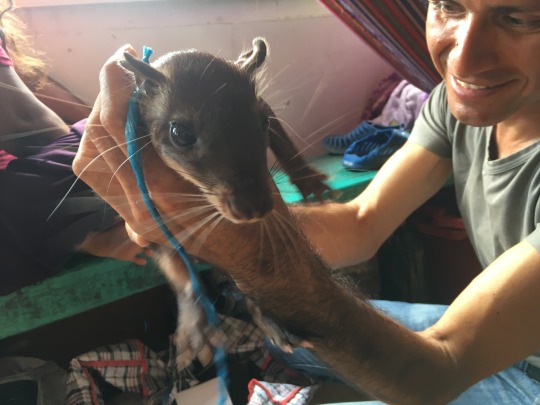
peculiar Amazonian pets

Otilia the shaman, and the author
One of the pleasures of this form of travel is that, over 7 days, you get to meet people. I was the only foreigner on board, and most of the Peruvian men looked like the tattooed Mexican convicts in Hollywood prison dramas. Thankfully they were more friendly, although Otilia warned me about the ‘human rats’ on board, and we never left our luggage unguarded.
In the mornings, the children on the boat gathered around the central dining table to sing songs and hymns, taught to them by the wife of a Peruvian missionary. I met her and her husband later; they were both very outgoing, but I was wary of the conversation turning to religion. I am not a Christian (or, rather, not only and not primarily), and it strikes me as farcical that Christian missionaries are still setting out to ‘civilize’ the indigenous inhabitants of the Amazon. It is true that there used to be frequent raids and counter-raids among Amazon tribes, but at the same time these communities – at least, those untainted by Western influence - perceive the sacred nature of all of creation. The spirit world is alive for them, and it is part of the fabric of daily life. They possess a sensitivity that Westerners have, for the most part, lost; or, if not entirely lost, then relegated to a dusty church service once a week. In my eyes, the indigenous inhabitants of the Amazon are much closer to God than the vast majority of missionaries who have set out to convert them.
Eventually the missionary and his wife did broach this subject with me, and I gave them my honest opinion. To my surprise, they were not at all dismissive, and even tentatively agreed. Then they asked me whether I would be willing to teach English to the children on the boat. For the remaining six days, after the hymn singing, I gave an English lesson to a ragtag group of children aged between 7 and 10. I have not taught this age before, but their immense enthusiasm, and the astonishing quality of their memory, made it pretty easy. Later in the day, when I went walking around the boat, I often found myself being hugged around the legs by affectionate pupils. Their open-heartedness – described by Otilia in more erudite terms as the absence of ‘complejos’ - was deeply touching.
When I wasn’t sleeping, or teaching, or reading in my hammock, I sat on the roof of the helm and watched as the front of the launch divided the sluggish brown water ahead of us. The thickly forested banks of the river slid languidly by. We passed occasional villages, usually with children splashing around in the shallows. When the boat stopped, there was an invasion of women and children selling jungle fruits and vegetables, though thankfully none of the roasted insects, larvae and crocodile meat I had seen in the market in Iquitos. Nevertheless, after a week on the boat, I was happy finally to reach Pucallpa.
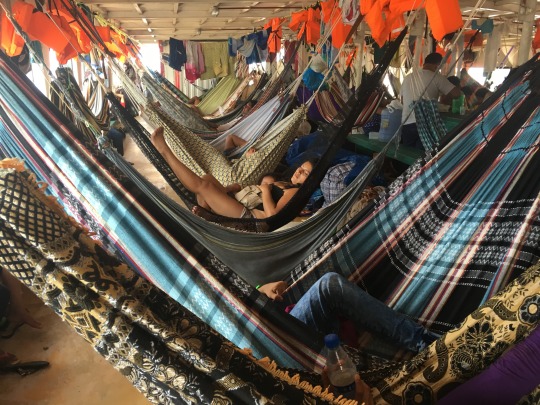
The crowded interior.
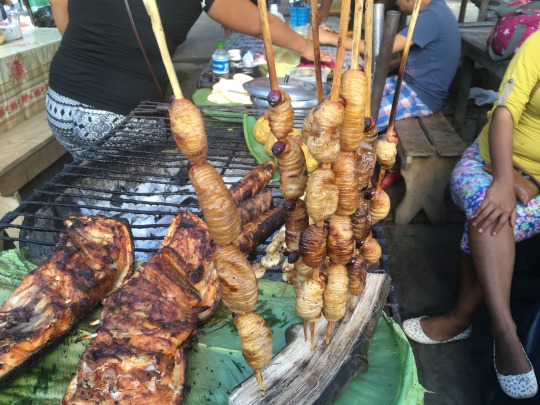
Bbq’ed larvae.
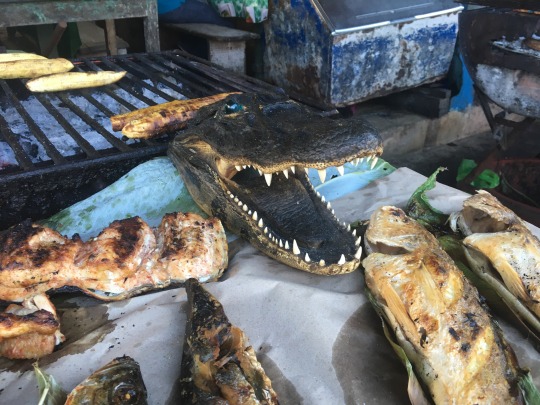
Other treats.
Otilia had spent her twenties and early thirties in Pucallpa. She left when the political situation in Peru became too hairy - when there was a nightly curfew in the city and running battles in the streets between the military and Abimael Guzmán’s Shining Path guerrillas. But she had been something of a community leader in Pucallpa, and a champion of women’s rights. It had been a small town back then, a hotchpotch of dirt roads and tin-roofed shacks. She hadn’t been back since she fled the violence, almost 30 years ago.
Otilia was excited about this trip down memory lane, but it was a lane she barely recognised. She wanted to show me the house where she first lived, and also the statue of a powerful female revolutionary that she had found deeply inspiring at a time when she lacked confidence. It took us a long time to find either, and although they were both still standing, the surroundings had changed beyond her recognition: there were smart asphalt roads, streetlights, malls, and blocks of swanky apartments. Unlike Iquitos, it is possible to reach Pucallpa by road from Lima, and consequently there has been much more development.
In order to reach the Shipibo community in San Francisco, we had to take a wooden canoe with a small outboard motor over lake Yarinacocha. On the way we saw pink dolphins breaking the water’s surface – they are creatures that loom large in indigenous Amazonian mythology: after dusk, they are thought to have the ability to transform themselves into handsome fishermen and seduce unwary girls by the water’s edge.
Otilia pointed out a large water tower, some distance back from the lake. She told me that when she was living in Pucallpa, some fishermen had found a mermaid trapped in their nets. They carried her up to the water tower and imprisoned her there, thinking that they could keep her alive while they made a deal to sell her to some Western research institute. However, and perhaps unsurprisingly, she did not survive for long in the water tower, though according to local belief, her corpse was eventually sent to Harvard (I have not been able to find any evidence of this).
*
After an hour or so, the canoe nosed its way onto the mud bank of the village of San Francisco de Yarinacocha. Che had suggested that I go to the village and just ask for Rodrigo the shaman. We stopped at the stall of a talkative fat lady who was selling fruit juice beneath the shade of a large tree. We drank juice, then I asked if she knew Rodrigo. She did, and she pointed us in the direction of his house.
San Francisco is a small village of dirt roads, but not entirely untouched by tourism. There is a tiny museum, and children are constantly coming up to ask if they can sing a Shipibo song in exchange for a peso. As we approached Rodrigo’s house, I felt my shoe slide on the dirt road. Looking down, I saw the sole’s profile neatly smeared across a large and pestilent dog turd.
We were met by a girl who worked for Rodrigo. She told us that he was away in Pucallpa for the day. He had already performed ceremonies the previous two nights, but if we wanted, he would certainly do one with us that night. Otilia and I were both surprised. I said that we had really just come to make a plan with him, we hadn’t intended to spend the night, and we didn’t want to tire him out by making him do ceremonies on consecutive nights. The girl replied that Rodrigo would not be tired, he was ‘un gran maestro’, but we should wait a couple of hours until he returned, and make our arrangements with him.
I cleaned my shoe and we made ourselves comfortable in the hammocks of an open-sided hut. There were other huts on his plot, and a large and new-ish ‘maloca’ (a circular ceremonial building) at the back. His was certainly the most impressive dwelling of those that we had seen on our walk through the village.
A tattooed, chain-smoking foreigner soon appeared, topless, and started dancing around the garden with weights attached to chains – the kind of thing that is impressive when the weights are balls of flame, but rather tiresome otherwise, though possibly quite fun to do. This man came to speak to us later – he was a French Canadian hairdresser, very gothic, with a tattoo of the bones of his neck and throat superimposed on the skin of his neck and throat. But for all that, he was open and likeable, and told me that he was living on Rodrigo’s plot and drinking ayahuasca in order to try to cure the AIDS that was killing him.
It was now getting late and I was beginning to worry that there would not be any more boats going back across the lake. We were just getting ready to leave when Rodrigo arrived. He was powerfully built, probably in his late forties or early fifties. I told him why we had come - that the Argentine shaman Che had spoken very highly of him, and that Otilia and I were both keen to experience the authentic curanderismo of the Shipibo-Conibo. No problem, said Rodrigo, smiling. We could stay and do a ceremony that night. I said that he must be tired, having done two ceremonies on previous nights. Rubbish, he replied. He was un gran maestro and could do a ceremony every night if he needed to. But I said that we had to make arrangements with our hotel in Pucallpa, and we would come back the following afternoon.
*
It rained heavily during the night and we had to squelch through the mud on our way back to Rodrigo’s plot. We were shown our places in the maloca – the mattresses on which we would sit during the ceremony, and also where we would sleep.
There were a couple of hours to kill until the ceremony was due to begin. I went outside to familiarise myself with the geography, and to make sure that I wouldn’t get lost trying to find a toilet in the dark. I met an Irishman whose bug-eyed stare disconcerted me. He kept telling me what a great shaman Rodrigo was. As soon as I could, I escaped back to the maloca.
One by one, the long-term paying guests began to filter in – mostly white, mostly female. They were chatty and cheerful. Rodrigo came in and started to prepare his altar and ceremonial objects, consisting mostly of hundreds of potent (and revolting) mapacho cigarettes. After a while he came over to speak to me and Otilia. Up until this point, he had not asked us any questions, and neither she nor I had mentioned that she was a curandera. Rodrigo ignored me, not even asking me whether I was taking anti-depressants (in which case, drinking ayahuasca can be dangerous). However, he was very interested in Otilia, and he interviewed her extensively about her own healing and shamanic practice. He went on to tell us, at considerable length, how many plants he had dieted, and how much time he had spent alone in the jungle, learning his craft.
When the exchange was over, Rodrigo returned to his spot and chatted to the other participants. The conversation took place across the maloca; it was mostly about money and exchange rates, and about how much he had earned by speculating on currencies some years back. While he was holding forth about his financial acumen, everyone started preparing their tobacco pipes. When Rodrigo started to smoke his pipe, so did they. Clouds of acrid smoke rose up to the roof and there was almost constant spitting. When the pipes started to go out, people lay back. The chatter died down as, one by one, they appeared to fall asleep.
Eventually Rodrigo poured out the measures of ayahuasca. In some cases, people needed to be woken up to drink their cup. I found it less disgusting than Otilia’s brew, which usually also contains tobacco as an emetic. One girl drank her cup and followed it up with a swig from a wine bottle, though I don’t know for sure that it actually contained wine. Then we lay back in the dark and waited.
After half an hour, Rodrigo started to sing some Shipibo ícaros. They were not nearly as impressive and haunting as those that Che had sung during the ceremonies in the Scottish Highlands; Che’s had been a musical distillation of jungle sounds – croaking frogs, trilling birds, hissing snakes and roaring jaguars. Rodrigo’s ícaros, on the other hand, were meandering and repetitive. He soon appeared to tire, or get bored, and then his son took over.
I felt tired during the ceremony. From time to time, Rodrigo would sing another ícaro; at one point, Otilia sung some of her ícaros, with which I had become very familiar over the past month. I was happy to hear them again. They were different to the Shipibo songs – more melodic and gentler.
I did not feel sick, and the dose was not particularly strong, although there was plenty of vomiting going on around me. Once again, my visions were minimal. The only clear one I had was seeing myself being enfolded in the strong, protective blue tentacles of a huge octopus. That is really all I can remember.
*
Otilia and I woke early the following morning. The sun was filtering through the wooden slats of the maloca. A few others were still asleep on their mattresses on the floor, but most had returned to their own huts.
Rodrigo came in and asked us how we had liked the ceremony. We made polite, appreciative noises. I paid him for the night, 200 soles per person ($60). He suggested to Otilia that she should work for him, and that he would send some of his clients to her in Iquitos. She thanked him noncommittally.
As Otilia and I walked back through the village, she asked me what I had thought of the ceremony. Not much, I said. The conversation about money was odd. The ícaros were disappointing. Rodrigo appeared tired, or just disinterested.
That was brujería, said Otilia. Witchcraft. Rodrigo is a rich and powerful man in the village. He is using his relationship with the spirit world to manipulate people for his own ends. He has managed to cast his spell over his clients. He uses humour, and some degree of personal charm, to hold them in thrall. But he is exploiting them, not curing them. He is a sorcerer.
Personally, I am not so sure. But it might explain my vision of the octopus’ tentacles. I had perhaps sensed that Otilia was protecting me, and that was how my subconscious had visualized it.
And that, continued Otilia, was why she had started to sing her own ícaros during the ceremony. She had tried to counteract Rodrigo’s malevolent magic. But she didn’t like this kind of work. It has very little to do with the serious work of healing.
*
We returned to Pucallpa and booked our onward journey to Lima, by bus, for the following day. I suggested a visit to the cinema in the afternoon, a multiscreen complex in the big new mall. Otilia has rarely been to the cinema, although she has referred to ayahuasca as ‘the cinema of the jungle’, because of the lifelike and narrative visions she has.
The cinema was on the first floor of the mall. Otilia hesitated when she saw the escalator. She looked around and spotted a staircase by the emergency exit.
‘I’m going to walk up,’ she said.
‘Ok, I’ll see you at the top.’
I couldn’t help smiling to myself as I stood on the escalator. Less than 24 hours ago, Otilia had been doing battle in another dimension with a black magician, like Gandalf and Saruman fighting each other in the ‘Lord of the Rings’. But confronted with a mechanistic modern invention, she had lost her nerve.
I met her at the top of the fire escape.
‘Are you afraid of escalators?’ I goaded her.
‘Yes,’ she replied, wide-eyed and childlike for a moment.
Again I had to smile.
‘You see,’ she continued, ‘when I was a small girl, my father took us to Lima to see the planes take off and land at the airport. The airport was new then. I saw an escalator for the first time. A very beautiful lady with very long hair stepped onto it. The lace of her shoe got stuck, so she bent down to free it. As she did so, her hair fell forwards, and that got stuck too. Her face was pulled closer and closer to the metal step, and when she got to the top, a large clump of hair was torn out of her head. I will always remember the way she screamed.’
*
I bought us tickets for ‘A Dog’s Purpose’, a saccharine but charming feel-good film about the successive lives of a pet dog. The shaman enjoyed it a lot, as did I.
0 notes
Text
Plant Medicine and the Mystery of Purging.
Plant medicines are queer fish. The previous two times I drank Ayahuacsa, I was sick as a pike; I vomited repeatedly and the nausea lasted well into the next day. During the ceremonies, Otilia the curandera came over to examine me. She diagnosed malfunctions in my kidneys and gall-bladder, and an energy blockage around the liver. She said I should buy an anti-parasitic purgative from a pharmacy, which I duly did, and I drank a pint of kidney cleansing matapasto tea every morning – a type of grass. And, but for this weekly visit to Iquitos, I ate nothing but the salt free, sugar free, caffeine free vegetarian meals served up in the jungle.
When I drank Ayahuasca again two days ago (admittedly, a somewhat smaller quantity), I didn’t feel sick at all. I felt bright and alert and was able to sit up straight for most of the ceremony, instead of having to lie on my back with the feeling that an elephant was crushing me. A couple of gringos (Americans) had turned up that evening to take part in the ceremony; they had a torrid time. There were two other participants who have also been with Otilia for the previous ceremonies. They had suffered a lot during those ceremonies, but were also fine during the last one.
I have been reading a book about the San Pedro cactus, a plant medicine from the Andes with chemical components similar to Mexican Peyote, and which is used by Andean shamans in a way similar to Ayahuasca in the jungle. It’s a good book, by the English psychologist Ross Heaven. I’m not enamoured of the title, ‘Cactus of Mystery’, but it’s better than ‘Penis of God’, which is another of the cactus’ names.
The author describes one indigenous tribe who arise before dawn every day and drink a couple of litres of an emetic. They then vomit for half an hour or so; once that’s done, and the nausea has abated, they will settle down to breakfast and the rest of the day’s activities. Writing about ayahuasca, he says:
‘The purgative element of ayahuasca is deemed a gift. An important part of the healing experience, the emetic properties are highly appreciated. To put this into context, know that in many rainforest cultures vomiting is part of one’s daily cleansing practice. In contrast to our Western mind where, as nausea builds, we begin to think we are getting sick, these peoples think of this as getting well.’
That’s a hell of a reframe.
With that in mind, I thought I ought at least to try to vomit during the last ceremony. I went outside, crossed the clearing, and leant against the side of my hut – my own little vomitorium. But it wouldn’t come; there was no need. Very surprising, since on previous occasions it was a projectile explosion that I had absolutely no control over.
I returned to the ceremony, lighting the way with my headtorch. I saw an old man sitting outside the ceremony hut; he was wearing a poncho with an intricate design woven into it, and the top of his head was covered with a pointed cowl in the Andean style. He gave me quite a shock. I stared at him for a while, pretty much convinced that I had to be imagining things. Then he moved and I saw that it was one of the gringos; they had been outside vomiting for most of the night. I said to him, ‘Wow, for a moment there I was sure you were an old Andean man.’ The gringo didn’t reply. I continued to stare at him. Then I realised that it wasn’t a person at all, but the waist-high stump of a chopped tree.
Was this just mental chemistry gone haywire, or did I see the spirit of the old tree (which Otilia told me is an Andean species). Or both? In any case, I am happy to record my first vision.
But more than that, I am happy to be feeling better than I have done for a long time. It shouldn’t be hard; I’m writing this in the Fitzcarraldo café in Iquitos. The sun is shining outside, butterflies are bouncing between the flowerpots on the windowsill, and beyond them the mighty Amazon stretches into the distance. From here, the rainforest extends unbroken for about 6000 kilometres, across a continent, eventually coming to an end on the Atlantic coast. In remote pockets there are still uncontacted tribes, ninety that we know of, their way of life unchanged since the dawn of time. People that still live in myth. It is the most biodiverse place on earth; who knows what other plant medicines, or plant spirits, it may contain. None of this was any different the last time I sat in this café, but my capacity to appreciate it is increasing, and that makes all the difference.

Uncontacted tribe firing arrows at an airplane.
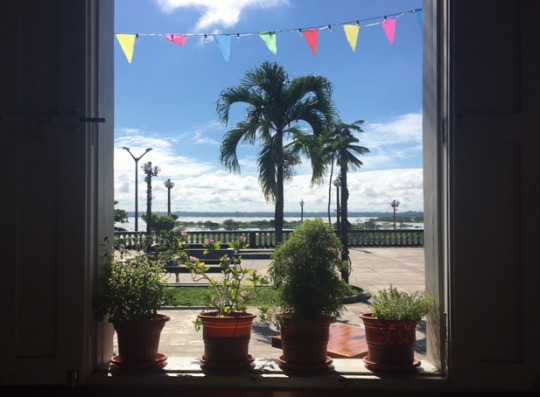
Amazon river from Fitzcarraldo café, Iquitos.
1 note
·
View note
Text
Life and Literature.
I don’t wish to be bleak, but it does sometimes seem to me that, with a few exceptions, life consists of a series of disappointments; the art of living is finding one’s peace with that fact, without losing one’s sense of humour or enthusiasm.
This realization stems from the combination of honesty, and a capacity to dream by day. Like Fitzgerald’s Nick Carraway, I think of myself as one of the few honest people I have ever known – honest with myself, at least. And I most certainly dream, but I am always aware of the gulf between my dreams and reality. That’s the primary source of the disappointment. And how could it be otherwise? In the long run, I mean. The nature of matter is to disintegrate. Our bodies fail us. The things we care about will one day cease to exist.
There are consolations. There is love, for those lucky enough to find it, and skilled enough to hold on to it. There is the thought that it is better that there is something, not nothing, even when that something falls short. There is the satisfaction that comes from the honesty, from looking the truth in the face without flinching. And for the rest there is literature, which is really the sharing of the honesty. In a few rare cases, literature is also the creation of a dream that does not compromise the honesty. It is very hard to do, and therein lies the alchemy.
What has precipitated these trains of thought?
I have just spent ten days in a small hut in a clearing in the Amazon jungle. The terreno belongs to Otilia, a Peruvian shaman in her late fifties. I know her from a previous visit, seven years ago.
Twice we have drunk Ayahuasca, the powerful hallucinogenic brew. I assisted in the preparation: a large quantity of woody Ayahuasca vines are beaten with a stick then boiled all day in a large pot together with chacruna leaves. The resulting reduction is an extremely viscous, bitter, lumpy and acrid sludge. I drank a cupful on an empty stomach on both occasions, and both times I was violently and repeatedly sick about an hour later. Each time it comes up, the taste is reintroduced and the sense of revulsion returns. The nausea continued well into the next day. Even thinking about it now sends a shiver down my spine.
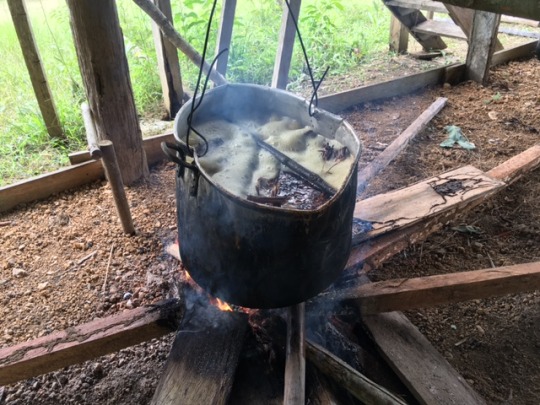

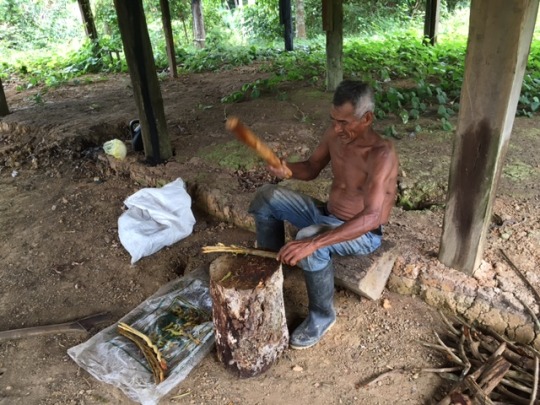
There were some half-glimpsed visions for a few minutes the first time, and a few hours of physical wellbeing the second time, but that is a limited return. I felt very far from communicating with the spirits of the plants, and the only memorable lesson I received was that my mind is uncontrolled and runs wild on exhausting loops of thought, but I knew that already (though am now more committed to addressing it).
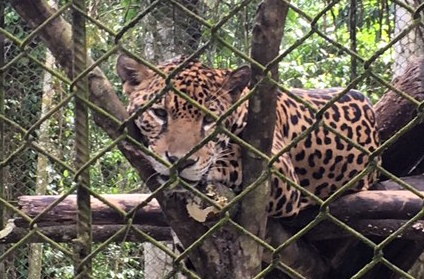
Jaguar in Iquitos zoo - his spirit did not attend the ceremony.
The ceremony is conducted entirely in the dark (but for repeated trips to the vomitorium of the moonlit jungle). After about four or five hours, Otilia comes over to conduct an examination and give a diagnosis. She feels and massages my stomach; her hands produce remarkable heat. She says that my liver is swollen and my gallbladder needs flushing out, for which she prescribes a plant diuretic. Apparently I also have intestinal parasites, for which she says I have to go to a pharmacy and buy a course of anti-parasitic purgatives. I am a little baffled by this. I live in the hygienic West, not in the Amazon; how have I come by these parasites? Does she have a form of X-ray vision which enables her to see into my body, or is that absurdly credulous on my part?
The proof will, as ever, be in the pudding. I will follow her instructions and prescriptions for a few weeks, assuming I can swallow some more of the filthy sludge. Then I will see whether I have recovered some of the energy and positivity which the years seem slowly to be eroding. That, according to Otilia, is simply the way things are, and she sees Ayahuasca as a bitter (so bitter!) medicine that counteracts that tendency. The benefits take time to manifest, there is no improvement without pain, and it is a holistic process that works best in combination with other plant remedies. If it works, then I will think of Otilia more as a curandera – a healer – rather than primarily as a shaman, or mediator with the spirit world.
Otilia says she would like to travel with me by boat to visit a Shipibo (indigenous tribe) community further south and take Ayahuasca with them, something she has never done. Assuming I can overcome my revulsion, I think we may do that.
My thoughts on literature, on the other hand, have been precipitated by listening to Hemingway’s For Whom the Bell Tolls on my ipod, when I have been unable to sleep the night after a ceremony. He achieves the alchemy. But how to translate that to today’s world?
The girl slept on, wrapped in his night coat on the forest floor. Robert Jordan kissed her short cropped hair one more time, then he leant across to the canvas pack. He undid the buckle on the leather strap, the strap that bore the fine sharp smell of horse sweat and the pure fresh smell of pine from where it had lain pressed against the needles during the night. Carefully he pushed aside the sticks of dynamite and reached for the inner pocket to take out his telephone.
Gently, and knowing – if the old gypsy woman was to be believed – that this was the last of their happiness, he woke the girl.
‘And thou, María, little rabbit, willst thou whatsapp me in the evening, after the bridge has been blown?’
The girl opened her eyes and rubbed them like the child that she was. Nay, that she had been, until the things of that night.
‘No, Inglés, I am thy woman now. I shall not whatsapp thee. Once I have returned to the city, and checked my facebook, and been to the beautician to have extensions fitted – for I want thee to love me always – then I shall snapchat with thee, and thou canst send me a dick pic.’
‘Qué va, little rabbit! I have no time for dic picks! El Sordo waits, Pablo is bad in the head, and the thing of the bridge must be done tonight.’
Robert Jordan looked away from the girl. She brought a softness to his mind, a softness for which he had no use now. He needed the space to be there, the big cold space that allowed for the cool calculations, so that the thing of the bridge could be done well and coldly.
‘Ay Inglés, my Inglés, that I had only swiped left with thee. Well, there are many others such as thee on Tinder, it is but little loss.’
The sun rose above the mountains in the east and the first rays filtered between the pines and danced around the entrance to the cave where the old woman now appeared.
‘I obscenity in the milk of thy Tinder!’ she shouted, and Robert Jordan and the girl knew at once that she spoke the truth.
1 note
·
View note
Text
Teacher Plants
South American shamans believe in ‘teacher plants’. These are plants whose spirits will guide you and teach you, when you ingest the plant itself. That is of course a belief that is challenging from a Western scientific perspective. However, many people will say that they have gained new insights and perspectives from alterations in consciousness, whether these are precipitated by meditation, by marijuana, or by more powerful hallucinogens. If you can learn something from ingesting certain plants, perhaps it is not too big a step to consider those plants to be teachers?
I had an encounter with the teacher plant San Pedro – an Andean cactus - earlier this year. I gained a renewed awareness of the fragility of the natural world, and the importance of doing everything we can to protect it. That was in part a motivation for visiting my friend Winston in Mozambique. There are still huge areas of untouched wilderness there, but the pressure of population growth, illegal logging, and a huge increase in poaching mean these areas – once teeming with elephant, buffalo, and zebra – are now almost empty. It is not too late to do something – if safe havens are created, the animals could still return. But soon it will be too late. And of course, the issue is not a straightforward one: what does one do to curb population growth? How does one prevent subsistence poachers from pursuing their ancestral right to hunt? Can everyone be provided with jobs? How do you keep out the ivory hunters who are armed with AK47s? How to convince the Chinese to stop buying ivory?
One man who is trying to fight that battle, and currently fighting it alone, is a former South African mercenary – J - now in his sixties. He has a conservation concession in the Quirimbas national park – that sounds good, except that it is only a national park in name, and the top brass are in cahoots with the Chinese loggers. But J is a fascinating man: a loner who is passionate about nature in all its forms, he holds some new age views about reincarnation and the healing powers of electromagnetic currents that act on the human energy field, and also some quite extreme views about the desirability of a Boer separatist movement in South Africa. He is a good reminder that, once you dig a little, most humans contain contradictions.
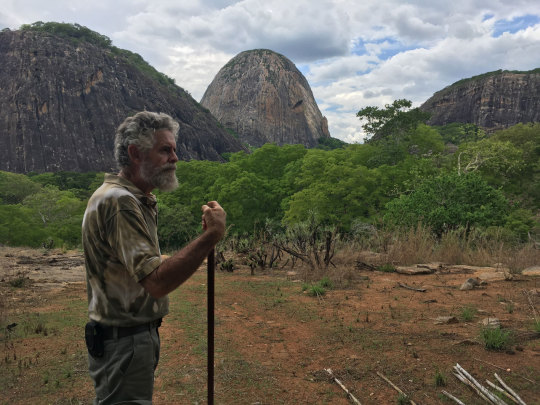
J on his concession.
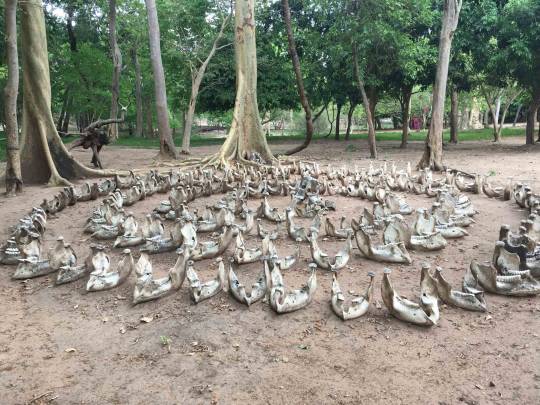
Elephant graveyard on the concession.
J’s concession is spectacular – enormous granite Inselbergs tower above the forest floor. The area is reminiscent of the shots of the dome-shaped Cerros de Mavicure from the film ‘Embrace of the Serpent’, about the quest of a German ethnobotanist in 1909 to find a sacred plant deep in the Amazon.

‘Embrace of the Serpent’
I am now heading back into the Amazon myself. After teaching for three years, I feel I now need to continue along my own path of learning; the two should always go hand in hand. But rather than use books, I now wish to consult the teacher plants.
I last came to the Amazon 7 years ago. I met a shaman called Otilia, whom I will shortly be seeing again. I remember asking her how the indigenous peoples of the Amazon came by their knowledge of healing and medicinal plants, and particularly Ayahuasca, which requires two separate plants to be boiled together for a number of hours in order to have any effect. She looked at me as if I had asked a very foolish question, then she replied, ‘That’s what the spirits teach us.’
And that is the claim that I now wish to investigate. Is it really possible to have meaningful communication with plants spirits? And what can they teach me? I feel that this is a quest of my own – a quest for learning – and a pilgrimage in a much deeper sense than the long walk I undertook across Europe last year.
1 note
·
View note
Text
The mines of Lurio
‘There are many many rubies still in the mine, but no one can take them out.’
‘Why not?’
‘Because the curandeiro (the witch doctor) has placed a curse on the mine. Only he can lift it again.’
This is music to my friend Winston’s ears. He has recently acquired the rights to mine this area, just south of the Lurio river in the northern province of Cabo Delgado, in Mozambique. The area seems promising – locals have panned flakes of gold from the river, and the rubies were plentiful enough for deep holes to be dug by hand, before the curandeiro’s curse came down.
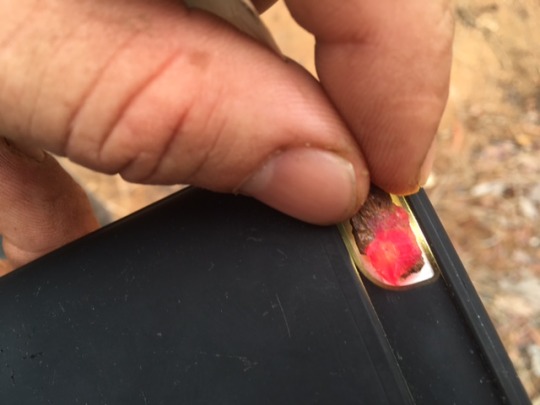
We are sitting beneath a palm roof, in the machamba (mud hut homestead) of a man who has been our guide for the last two days. His name is Noventa. He has just fed us a large ball of sticky cassava, from which one grabs a small amount between thumb and forefinger to roll into a mouthsized ball, before dipping it in a bowl containing an evil looking moustachioed catfish in a brown fishy sauce. Noventa’s wife – a powerful woman – is pounding more cassava in the kitchen. His 11 year old niece is breastfeeding her first baby.
Noventa is an older man (he doesn’t know the year of his birth), and a rich one in this area. He has a dvd player, connected to a car battery, in his second room. There is no other source of power. We have spent the last two days driving around the bush on cheap Chinese motorbikes. They break down constantly but we have Ibrahimo with us – he is a handy mechanic and works for Winston as a scout, alongside Kamanjira. They case out areas where mineral rights are still up for grabs. They will do a little panning for gold and make enquiries from the local panners, called garimpeiros. Winston secured the mining concession based partly on what Ibrahimo and Kamanjira managed to find. This is only Winston’s second visit; it is better to let Mozambicans make the enquiries. Everything gets more complicated when whites get involved.

‘He is a powerful curandeiro,’ the guide adds. ‘At night, he travels as a lion. When he wishes to go to Pemba, he travels as a bird.’
That would have been useful. It took us a whole day to drive from Pemba to the concession. The last couple of hours were offroad, though no problem for the tank-like Toyota Landcruiser. Noventa told us that the last car, and the last white people, passed through this area five years ago. Children up to the age of seven or eight have never seen white people before, or have no memory of having done so. They watch us very cautiously: whites have a reputation for eating black babies. At our approach, young mothers pick up their babies and sprint off into the bush.
The area is comparatively densely populated. The locals are proud of their machambas; the red dust surrounding each one is carefully swept. There is no road and when we accidentally drive over the swept red dust, they just smile. Despite the fear of the younger children, the parents are content for their homes to be singled out in this way.
We arrived two nights previously, juddering down to the wide Lurio floodplain in the twilight. On the opposite bank, a small mudhut village was just visible between the palms. It was like a scene from ‘Babar the Elephant’. We parked on an attractive sandbank.
Winston and I started unpacking the Landcruiser. Kamanjira and Ibrahimo were on the motorbikes, still some distance behind us. A group of locals had soon formed around us. They pointed and laughed. We could not understand them; most only speak Macua. We looked around. It was a scenic spot, but on closer inspection, it appeared to be dotted with large, solid, sun-bleached human turds. We were pitching camp on the village toilet. Quickly, we repacked and drove up the floodplain to a quiet spot further away from the village.
After dark, and having pitched camp, I went for a wash in the river. The next day, we found out that there were crocodiles there. The water was very shallow, but nevertheless, I would have foregone the washing had I known. Then we cooked a barbecue. Kamanjira polished off an entire chicken by himself; Winston looks after his employees well. Afterwards, we sat staring into the fire, as one does in the bush. Kamanjira, his face shiny with grease, said:
‘There is a lot of oil here too.’
‘So why does no one mine it?’
‘Because it is protected by a huge luminous snake.’
Interesting how the dragon protecting his hoard of gold – in this case, black gold – is a cross-cultural motif.
Later, a couple of local garimpeiros came by; they knew from the scouts that Winston was interested in gold. They showed us a small wrap of flakes from the river. They wanted to sell it for $30 – a large sum for them, but, according to Winston, a fair price. I bought it as a souvenir, and in the hope that it might bring luck to the Lurio Mining Company.
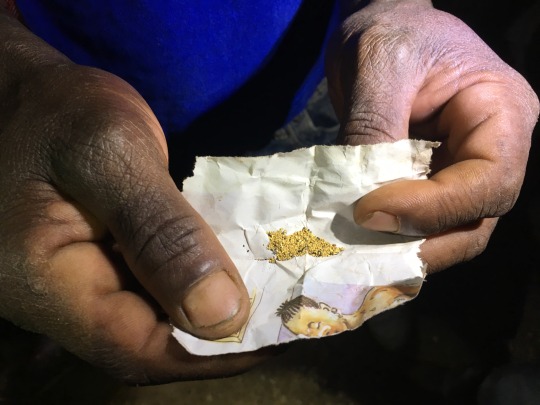
Later still, an ancient couple came by with a gift of food: the same cassava ball with dried fish stew, though this time quite inedible. Nevertheless, the generosity was touching. Winston sent them away with a South African steak, though I am not sure how their toothless gums will have fared with that.
*
I was woken at sunrise by the sound of children laughing. A group of the braver ones had come to look at our campsite. They were mesmerised by the car, and they broke into grins and laughter every time Winston or I looked their way. When the excitement got too much, some children started to do backflips and somersaults. By now a few adults had turned up too, and they joined in with the laughter, if not the acrobatics. I realise how romanticising this sounds, but despite the poverty and lack of education (or because of it?), I am in awe of this capacity to tap into a sense of natural and immediate joy. It is so far removed from the tired grey faces commuting to work in the cities of the developed world.
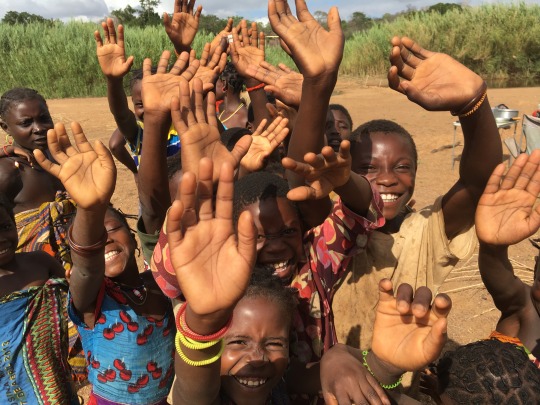
But then, the climate is temperate all year round, so no one is concerned about getting cold or paying for heating, delicious ripe mangoes fall from mango trees which grow everywhere, and no one worries about what time it is, or even what year. Stress is the disease – literally the dis-ease – that kills the most people in the West, albeit indirectly. There is not a lot of stress in rural Mozambique.
But I must not paint too rosy a picture. AIDS is through the roof. Human population growth has pushed African wildlife further and further into the interior, and poaching is a constant and growing menace. In the last 10 years, African elephant populations declined by 30%, because of the ivory trade. In East Africa, where poaching is worst, there has been in a 50% decline.
Before leaving the camp, I took a few photos and some video footage of the children. When I played it back to them, their eyes were on stalks. The village headman may have a mobile phone (though the nearest reception is a few hours away), but most of these children had not seem images of themselves before, and certainly not moving images.
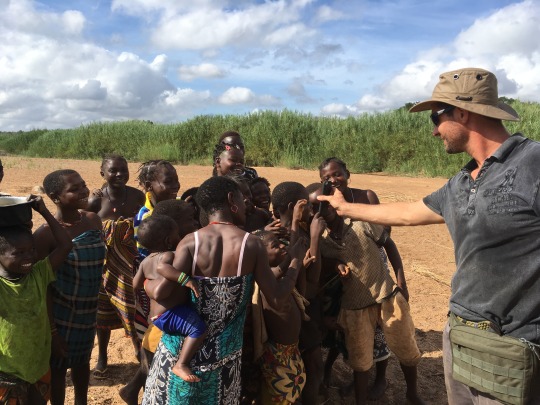
I didn’t think it was still possible to have experiences like this, certainly not within a day’s drive of an international airport. But the most memorable part was not the encounter between the modern world and a timeless way of life, but rather, the immense goodwill that was directed towards us. I don’t think there are all that many places in the world that are still like this.
0 notes
Text
Larch
I am aware of how hippie and tree-hugging this sounds, but I can’t help wondering why people get so excited about contemporary art when there is nature.
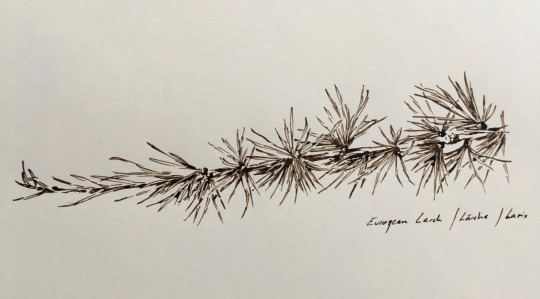
Larch branch.
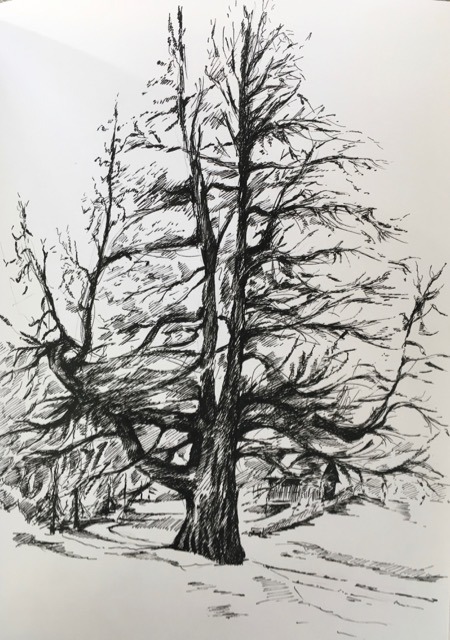
Larch tree.
3 notes
·
View notes
Text
Back to the drawing board.
I used to draw a lot. Then I got disenchanted, because the results often fell short of what I had hoped for. I also compared my work to other people’s, which is a foolish thing to do, though hard to avoid. But in essence, I got distracted by concentrating on a perceived goal - the finished drawing - rather than on the process and the activity itself. When viewed in this light, then drawing, like so many other things, can be a form of meditation. I owe that insight (or reminder) to my friend, the excellent painter Tom Young.

South Terrace, London.
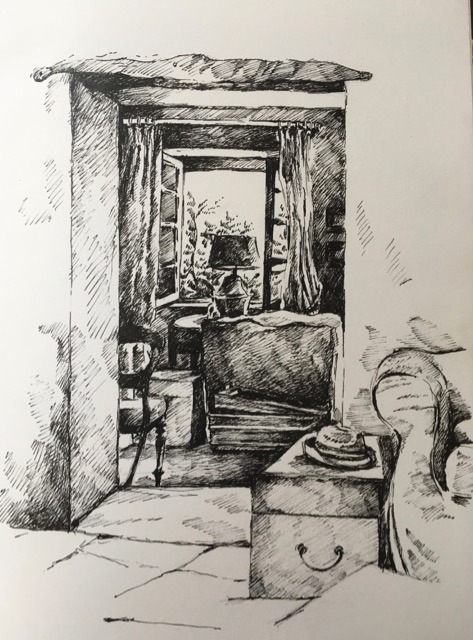
Le Roux, France.

Swimming polar bear, drawing of a sculpture by Tanya Brett.
0 notes
Text
In The Ashram.
From my blog www.onehundredwordsaweek.blogspot.com:
When I returned to the UK after the walk, at the end of January, I was on a high. I felt incredibly light, like nothing really mattered, but in a joyous and playful way, rather than a nihilistic one. Everything felt like a bonus, and my everyday interactions (with everyone - friends, taxi drivers, supermarket cashiers) reflected that. Then I started to work on the upkeep and maintenance of my parents' house, and my childhood home, in Sussex. It has started to look a bit sad and neglected in recent years, despite my mother's best efforts. My to-do list soon began to feel overwhelming, the cost of landscaping (both raw materials and labour) came as a shock after years abroad, and the days were cold, wet, and short. After 3 months, I was feeling more tired, flat and unenthused (about everything) than I ever have before. I had no desire to read and got into the habit of an escapist martini (or two) before dinner every night, passing out directly afterwards. Was it the weather? The physical labour? The to-do list? The challenges of coming home after years away? Or some vulgar virus? I went to see my GP, who did a blood test; nothing abnormal. With the growing suspicion that the malaise was primarily psychological, I consulted a friend and then booked a flight to India to spend a month at the Amritapuri ashram in Kerala, for £5 a day. I get a simple room, 3 vegetarian meals a day, access to various supposedly beneficent activities/ practices, as well as proximity to Amma herself, the 'hugging Saint' and, according to some, a divine incarnation... I arrived last week.
If you would like to read about the experience – and it has been life-changing - then please go to my normal webpage www.clausvonbohlen.com
*
I arrived at Cochin in Kerala at the end of April. The syrupy morning heat engulfed me as soon as I stepped outside the airport, but after a Northern European winter, it was not at all unpleasant. The ashram driver was there to meet me. We drove for four hours along a road where drivers applied the logic of a five lane American Freeway, despite there only being a single lane in either direction. I admired my driver’s nerves of steel: even when face to face with an oncoming juggernaut, he did not so much as flinch. I told him that I was in no particular rush, a piece of information to which he responded with a unusually daring overtake.
After that, I kept quiet and looked out the window. There was not a lot to admire. One stall after another, all selling the same snacks and basic necessities. And coconut palms, lots of them. The occasional baffling advertising slogan for something called ‘Glowworm Elixir Smile’. A dental procedure? An aphrodisiac? An imperative? I never found out, but I’d like to try it, whatever it is.
We turned onto a smaller road and crossed a bridge connecting the mainland to a long, thin island that ran parallel for as far as the eye could see. Brightly painted boats were moored along the bank. The island was flat and covered with palm trees. An unprepossessing track brought us to the entrance of the ashram. Turning into the courtyard, the large and garish temple of Kali greeted us. It was an orange pink colour, flanked by two lion statues, and the overall effect was like a child’s drawing.

I presented myself at the accommodation office, next to the temple. I had been expecting board and lodging (in a small dormitory) for £2.50 day, but I was given the option of a single room, for £5 a day. I took it, and I am grateful that I did. I was to spend a lot of time reading in my room over the coming month.
There were a number of small initial irritations. My first room was on the top floor and so hot that I would be dripping with sweat just sitting on my bed. I had been looking forward to doing some yoga and meditation classes, but there were no yoga classes for men, and no organised meditation sessions for the next three weeks. There was an hour of chanting in the main hall every evening, but I have never been a fan of chanting, least of all in a language I don’t understand. But, on the positive side, there was a pleasant informality to the place: there was no requirement to do anything, other than dress respectfully, and refrain from drinking alcohol, smoking, or taking drugs.
The ashram is a large place that includes permanent residents, renunciates, schoolboys and schoolgirls who are educated on the premises, students from the nearby university, a small hospital, an Ayurvedic clinic, various workshops that make the ashram more or less self-sufficient, Indian workers from these workshops, the Kali temple, a large open sided main hall that can hold several thousand people, the Indian dining facilities, a separate Indian café, a Western café, a milkshake and juice vendor, a health food shop, a convenience store and a small clothes shop.
Several thousand Indians live at the ashram fulltime – in the early hours you see elderly Swamis and monastics in their saffron robes returning from the pre-dawn pujas, while in the evening the students are out and about, drinking milkshakes while glued to their smartphones. I probably saw about fifty to a hundred Westerners of all ages, though this number can go up to several thousand when holidays , cooler weather, and Amma’s presence at the ashram coincide.
Residents at the ashram are also encouraged to sign up for a couple of hours of ‘seva’ (volunteer work) per day. This soon became another irritation for me, not because I am opposed to volunteer work, but because I resented the way that the seva official – a humourless Frenchman – would thrust the seva board, detailing the day’s labour requirements, under everyone’s nose twice a day, during mealtimes. I felt that this was hardly the volunteering spirit. What’s more, on my second day, I had signed up for a month long seva in the carpentry workshop, where I helped the Indian workers sanding pieces of furniture for sale outside the ashram. It was tiring and sweaty work, but I was grateful for the opportunity to interact with the Indian non-ashramites, and I was the only Westerner there. But for that reason, I never felt any obligation to sign up for the humourless Frenchman’s sevas, though that never stopped him from trying.
Before signing up for the carpentry workshop, I did an hour’s pot washing at the back of the Western café. It was dark, hot and humid back there, but happily my co-volunteer was a pretty and cheerful Austrian girl. Her eyes shone particularly brightly in the dim light and she was already energetically wielding the hose when I arrived. I introduced myself to Malise and told her it was my first day.
‘This is my favourite seva,’ she said, spraying water all over the place. ‘I always get soaked. It’s so fun!’
She showed me what to do.
‘So how did you meet Amma?’ she asked.
‘I haven’t actually met Amma. In fact, I had never heard of her until I looked at the website.’
‘No way! So how did you end up here?’
‘Well, I just finished a long walk in January, and I’ve spent the last few months working outdoors in the UK, and I‘ve been feeling really really tired. I’ve always wanted to visit an ashram, and I thought that this might be the right time. I spoke to a friend of mine and she recommended this one, so I booked a flight and came. What about you?’
‘This is my third time here. A few years ago, I had a good job as a graphic designer in Vienna. I was making good money, but it all seemed so pointless. Working, then going home, smoking a joint, sleeping, same every day, then getting drunk on weekends. I started to get depressed. I thought there had to be more to life. Then I met a Greek couch-surfer who really inspired me. He’d just quit his job and was traveling around the world, and he was so much happier than anyone else I knew. I decided that’s what I had to do. I left my job, sold my car, moved out of my apartment and came to India. I came to the ashram hoping to meet other people to travel around India with, but I met Amma and it changed my life even more.’
‘How?’
‘Well, you have to meet her yourself, then you’ll see. But just being here, it’s like there’s some kind of magic, things just work out, if you are open to it and allow it to happen. Since I first came here, my life has been getting better and better.’
Malise flashed me a big smile; a Glowworm Elixir Smile? She was certainly a good advertisement for the choices she had made.
‘So now you live here?’
‘No no. I spend six months here, then I go back to Austria for a couple of years. But I’ve also been on a few of Amma’s tours.’
‘What tours?’
‘When Amma travels. Every year she does a European tour, a U.S. tour, a North Indian tour, and an East Asia tour. She gives darshan every night.’
‘Darshan?’
‘Darshan is when people come to her for help. She listens to everyone, and she’ll give them advice or make things happen in their lives. And then she’ll give them a hug.’
‘Right…’
‘Going on the tour is amazing. It’s exhausting, but it’s like being on tour with your favourite rockstar, except that she’s a rockstar of pure love. You know she’s going on tour in Kerala next week? You should go.’
Chanting has never been my thing, and unmotivated hugging comes a close second. I was skeptical of the ‘rockstar of pure love’. But Malise had hit upon something that resonated: you do have to be open to new experiences, not matter how unusual, in order to be able to experience them. I am certain that the way we think plays a role in what we are capable of experiencing, and that the mind is actively involved in constructing our ‘reality’.
I signed up for the tour.
*
Writing is a solitary and silent occupation. Perhaps for that reason, many writers are fascinated by the monastic life. I certainly am.
Recently, I walked from Salzburg in Austria to Santiago de Compostela in Spain, along the old medieval Jakobsweg (Chemin de St. Jacques/ Camino de Santiago), a network of pilgrims’ paths that used to connect all of Europe. In France I spent a night in the beautiful abbey of St. Foy at Conques. I accompanied the abbey’s five remaining monks to Vespers in the enormous abbey church. They were dwarfed by the immensity of the interior. It was sobering and also a little sad to think that they represented the end of an ancient lineage.
After crossing the high Aubrac plateau, in the Massif Central, I passed by the abandoned monastery of La Domerie. In earlier times, monks from this monastery would venture out onto the plateau to search for pilgrims lost in snow storms. Robert Louis Stevenson visited the monastery of ‘Our Lady of the Snows’ in 1897, while walking with a donkey through the region. He describes the monks he met there:
‘I am astonished, as I look back, at the freshness of face and cheerfulness of manner of all whom I beheld. A happier nor a healthier company I should scarce suppose that I have ever seen. As a matter of fact, on this bleak upland, and with the incessant occupation of the monks, life is of an uncertain tenure, and death no infrequent visitor… This, at least, was what was told me. But if they die easily, they must live healthily in the meantime, for they seemed all firm of flesh and high in colour; and the only morbid sign that I could observe, an unusual brilliancy of eye, was one that served rather to increase the general impression of vivacity and strength.’
Another passionate walker with an interest in the monastic life was Patrick Leigh Fermor. In 1933, aged 18, he set out on foot to walk from London to Constantinople. Later, he decided to escape his hedonistic Bohemian existence in Paris for a few weeks; he went to stay at the monastery of La Grande Trappe. He describes Dom Etienne, the abbot:
‘Here again was a disconcertingly normal man…; direct, thick-set, fair-haired, rubicund, with humorous and startlingly blue eyes behind steel-rimmed spectacles. Everything in his face and the slight Breton accent of his voice revealed a thoughtful and sober alacrity, leavened occasionally by a sober, deep laugh. He possessed a singular charm and, like the other monks, an indefinable air of benevolence and happiness.’
There are parallels between Patrick Leigh-Fermor and Robert Louis Stevenson’s descriptions: the humour, the brightness in the eye, the impression of lightness… And these are precisely the qualities that fascinate and attract me. Do they follow automatically from the decision to turn one’s back on the material world? If you step out of the rat race, devote your life to God, choose not to possess anything, eschew romantic relationships and consequent responsibilities, then do these qualities inevitably manifest?
*
Amma’s first darshan on the Kerala tour was to take place back in Cochin. Upon arrival, I had already started to feel that the light, cheerful quality of so many monks, as described by RLS and PLF, did not apply to Amma’s followers and entourage. For the most part, the Westerners walked around scowling and getting on each other’s nerves. The humourless Frenchman, whose ‘spiritual name’ was Vikram, continued to stick his seva board in people’s faces. Many of Amma’s followers appeared to be fragile, damaged, or else just plain irritating. Malise, the bright-eyed Austrian girl, was a rare exception. But maybe this should not have come as a surprise; after all, one does not go to a hospital to find healthy people.
Amma’s entourage – there were probably about a hundred of us – were housed in the classrooms of the school. Some people had brought along small mosquito net tents, and inflatable camping mattresses. I had not. I was still jetlagged, tired, rundown, and I spent a first uncomfortable night trying to sleep on a hard floor.
I could not help noticing another irritating habit of Amma’s Western devotees: they were very ostentatious about their spiritual practices. Some of the men in my dorm-classroom would choose the most public places to perform their yogic stretches, or they would sit in meditative postures beside the main thoroughfares. Ironic, since such behaviour is antithesis of spirituality as I understand it. Often I felt that a certain tension in the projected jaw indicated that they were posing, and were aspiring to look both spiritual and tough.
Amma herself had not yet arrived, and the darshan celebration would not take place until the following days. That first evening was spent getting the school ready. Kitchens were set up, the entranceway and huge main hall were decorated, and the stage was prepared. There was plenty of pot-washing to do too, but this time it got on my nerves: there were so many people tasked with helping – chiefly Indian labourers – that it was quite pointless for more people to be ‘volunteered’, as I was. I have never minded helping out, but I do mind the feeling of being superfluous. However, it seems that the old adage about too many cooks has never percolated into spiritual circles.
The crowds started to arrive around midday the following day. There was a festival atmosphere: the women were wearing their best saris, there was constant music coming from the stage, and delicious smells from the many Indian food stalls. I wandered around in a bit of a daze, eating and pot-washing intermittently. Since I had never met Amma before, I was also able to get a token in order to have darshan – to be embraced by her – later that evening.
There was a lot of excited chatter amongst the Westerners as to when Amma would arrive. It all seemed a bit childish – like a lot of infants waiting for mummy to come home. The almost obsessive desire to sit on the stage, in physical proximity to Amma, struck me similarly. There were certain protocols here, relating to seniority and so on, that I did not much care for. I wondered whether I had ended up in a group of regressive individuals who were united by the fact that they were still working through the trauma of having being neglected or abandoned by their mothers in infancy. Amma was their substitute mother.
Amma arrived around six. She gave a two hour talk, broadcast on the live tv screens, but it was all in Malayalam, without subtitles. At eight, the religious chanting cranked up and Amma started to give darshan. There was a constant flow of Indians who joined a long and orderly line when their token number was called; Amma, seated on the stage, embraced them one by one.
Around the main hall, the festival atmosphere continued. Darkness fell. There were now many small groups of school girls and students. It seemed to me that they were using this opportunity to test their effectiveness of their kohl-lined looks on solitary foreign men. A bold, lingering gaze was frequently followed by a group giggle. I have worked in a mixed school, and have experienced this before, and know it to be the equivalent of a puppy testing its bark. But it is not wholly conducive to an elevated and spiritual mindset.
I was now getting quite tired, but the music was loud, the floor of the classroom remained hard, and I knew there was little chance of sleeping. My darshan would not happen until about 4am – there were at least eight hours to go. What was I doing here? I had come to India to find peace and quiet, to relax and to meditate. This was all wrong. I wanted to be back in the ashram.
I went to the Western Office. There would be a bus returning to the ashram at around 6am. The tour would continue for another week, but the bus was taking back the people who had just come for the night. I asked Vikram, the glum Frenchman, whether I could go back on it. He signed me up, but encouraged me to spend some time on the stage before I left.
*
I made my way to the stage. I flashed my wristband at the guard. He ushered me up the stairs. I have never had a backstage pass for a rock concert, but I imagine it is similar.
The stage was crowded with white–clad Western devotees, extending in angled lines behind Amma, like the rays in a drawing of the sun. I found a spot to sit down. The night was hot and humid, but on the stage, with the breeze from numerous fans, it was pleasantly cool. The music was less intense too. I stayed for half an hour, until my knees started to protest. But it was surprisingly relaxing up there.
Shortly after coming off the stage, I bumped into Vikram again.
‘Do you go on the stage?’
‘Yes.’
‘How is it?’
‘I found it very relaxing. Very calm.’
‘That’s it? For some people, it changes their lives. Even sometimes if they don’t want it to. But you have to be sensitive enough to experience Amma’s power.’
‘Right. Well, there is also such a thing as collective psychosis.’
‘I’m sorry, I do not understand.’
I was thinking of Freud’s ‘war fever’, or the hysteria of the Nuremberg masses, whipped to a frenzy by Hitler’s maniacal speeches – examples of people egging each other on, in closed groups, to believe what they want to believe… But the comparisons were unkind, and no one here was hurting anyone.
‘It doesn’t matter.’
*
At 4am, my darshan slot was finally called. I had snoozed a bit in my chair, and drunk plenty of small cups of spicy Masala chai. Amma, however, had been sitting on stage for 10 hours, embracing people and listening to their problems, without a break. She is a large lady, around 60 years old. She did not look in any way tired. How does one explain that?
As I got closer and closer to Amma, I began to feel increasingly nervous. If she is truly a divine incarnation, that meant I was about to encounter God. I decided to make sure that I looked her in the eye; much more than receiving a hug, I wanted to look into the eyes of God.
One of her disciples wiped the perspiration from my face – presumably, she would otherwise be soaked by now, after about 8000 hugs. Someone asked me my language. Then I was in front of her. I tried to make eye contact, but before I knew it, my head was pushed down by one of the Swamis attending her, rather like a police officer manhandling a criminal into the back of a vehicle. My head was pressed against her chest and I heard her say something to me, in Malayalam. A small gift (‘prasad’) - a sweet wrapped in an envelope containing holy ash - was placed in my hand. Then it was over and I was ushered away.
It is of course nice to be hugged, but the experience had been no more significant than that. Why all the fuss?
I made my way to the ashram bus, which was about to leave. A very fat Australian lady lay sprawled across three seats at the back. When two Indian women arrived, she was asked whether she would sit up so they could sit beside her. She was very unwilling and grumbled endlessly.
‘The seats on these Indian buses are far too small, it’s ridiculous.’
Well, that was one way of looking at it.
*
Back at the ashram, everything was very quiet. I fell into a pleasant routine, diving into the ocean first thing in the morning, then reading for much of the day, then sanding furniture in the workshop for a couple of hours in the afternoon. Meals in the Indian canteen were simple and vegetarian, but tasty and always spicy. They were also free, while the bland fare in the Western canteen had to be purchased.
There was no sense that you ought to talk to other people , at mealtimes or otherwise; you could if you wanted to, but in general people seemed quite content with their own company. The people left in the ashram – those who had not gone on tour with Amma – were either slightly older, or Indian; they generally seemed less troubled than the younger devotees.
I went to see one of the Ayurvedic doctors in the ashram. He was 90 years old and almost deaf. When I entered his room, he was fiddling with his hearing aid - an earplug connected to a machine the size of an early walkman. The device did not appear to be working, so the old man removed the batteries and reversed their polarity. After that, it made a whistling noise that appeared to satisfy him, though it was so loud that I could barely hear my own voice when I spoke.
The doctor gave me a list and told me to write down my name and age. I copied the style of the entries before me. As I was writing my date of birth – as everyone else had done – he rapped me sharply on the knuckles with a ruler.
‘No, age!’
So I wrote my age instead.
He took my pulse with his fingers, then asked me to stick out my tongue. He wrote out a least of pills and remedies. When I asked what they were for, he just shook his head in that Churchill-insurance-dog way that is so typically Indian. Then he said:
‘Avoid spicy. No Masala.’
‘Not even Masala chai?’
‘No.’
Great, the end of my first week of four in India, and I should not eat any Indian food, or drink the tea that I like.
*
The following week, I signed up to have a Vedic astrological reading. I have seen an astrologer before, in London. I had great respect for her as a person, and as a psychotherapist (her former profession), but I had never been bowled over by her astrological readings. She knew me a little anyway, which obviously makes the reading much less scientific. As far as astrology went, my jury was still very much out.
I had signed up for a reading with Brahmachari Sanjit. There were a number of astrologers working at the ashram, and some of them offered either 30 minute or one hour sessions. I liked the fact that Sanjit’s were all 45 minutes; no decisions, no watering down.
I was hoping that Sanjit would be something of a wizened old man, and I was quite taken aback by my first glimpse of him – he looked like he was in his early 30s, though he was in fact 51. Like Malise, he was another fine advertisement for the health benefits of the spiritual life. Sanjit’s parents were Indian, but he had grown up in Michigan and moved to the ashram in his mid thirties, having worked as a computer scientist in the US.
Sanjit explained to me that Vedic astrology, or Jyotish, differs from Western astrology by basing itself on constellations rather than on the relative position of the earth to the sun. In addition, your sun sign is less important than the constellation that is in the ascendant at the time of your birth.
I told Sanjit the time, place and date of my birth. There followed a character analysis of a level of accuracy and specificity that I would never have imagined possible, right down to such material aspects as the areas of my body that tend to cause me the most problems. Sanjit made some predictions about my life, though couched in terms of probabilities. And he also advised me to return to teaching, though I had told him nothing about my teaching career. He said that it is important for me to have relationships in which I can play the role of an older brother; teaching, mentoring and sports coaching all provide that opportunity. He added a further moral, or ‘dharma’, consideration: if you are committed to growth in knowledge and understanding, you also have a duty to pass that on.
I was amazed by this astrological reading. It gave me much to think about over the following days. Some of it I found comforting. When you are feeling low, it is tempting to regret certain decisions or aspects of your life: should I really be following a Bohemian path? Maybe I should have got a normal job, married and had children years ago, like most other people I know? Usually I do not have regrets, but when things don’t go my way, they can arise. But if astrology tells me that there is a deep strain in my character that likes to shake everything up every two or three years, then did I ever really have any choice about it? Would it not be worse to be in denial, to try to force a square peg into a round hole?
Vedic astrology is also not shy of making predictions. But what are the implications? Does it mean that we don’t have free will? That everything has already been decided?
I bumped into Sanjit a few days later and I asked him how Vedic astrology can be compatible with human free will.
‘Oh it’s not,’ he replied breezily. ‘There is no freewill.’
‘But then aren’t we just robots? The programme has been written, the end has been determined, we are just playing out a script…’
‘Well,’ countered Sanjit, ‘think of a book. Any book with a story. Harry Potter, for example. The book has already been written. The end cannot be changed. But the characters don’t know that. Their decisions feel real to them. Their lives seem meaningful. That’s what it’s like for us too.’
I found that an interesting analogy. I am still not sure what to make of it.
There is one clearly deterministic element of the Vedic universe: karma, or the idea that we are all subject to the laws of cause and effect. Good actions lead to good effects – to the purification of the self, and advancement on the spiritual path. It seems to me that karma makes sense irrespective of whether you believe in reincarnation and many lives, or not; good actions are their own reward in this life. We are happier when we are kinder and more generous.
However, it is the relationship between karma and free will that is more perplexing. It is not hard to accept the karmic laws of cause and effect, but do they also apply to our actions? To our decisions? If I do something cruel or unkind, how can I know that was a free choice, and not the result of some previous bad action in the past? And the same applies to that previous bad action. Freewill must surely enter the picture somewhere, in order for our decisions to be our own, and in order for it to make sense that we should suffer the consequences of them. But how does it enter the picture?
I don’t know the answer, but the accuracy of my astrological reading makes me think that the question is not just valid, but profoundly important.
*
One of the first books I bought and read at the ashram was ‘Amma and Me’, by a middle-aged American devotee (and former ship’s captain) whose spiritual name is Manoharan. The book has an endearing honesty, but it is also immensely childish. Manoharan admits to plaguing Amma, in the early years, with constant requests to be enlightened. He admits to an overwhelming need to sit as close to her as possible, at times even hiding under the stage she is sitting on. Like a young child, he appears to have abnegated all responsibility for his life and his spiritual growth. The thought of surrendering to God does strike a chord with me, but surely it is not meant like this – an infantile regression?
I then read another book, ‘On the Road to Freedom’ by Neal Rosner, or Swami Paramatmananda. The author is again American, but a more serious spiritual aspirant. He follows a number of different gurus before encountering Amma. He is blown away by her. When he first meets her, she is the barely literate younger daughter of a poor fishing family. He describes a number of experiences that convince him that, despite her youth and lack of formal training, she is ‘permanently established in God consciousness’; in fact, he thinks that she is constantly channelling the energy of Devi, the Divine Mother of the Universe. And not only that she is channelling it, but that she has access to the contents of all minds at any one moment, and all knowledge of past and future.
Swami Paramatmananda’s book is quite a challenge for a philosophically trained Western sceptic such as myself. He writes about miracles and divine manifestations as if they are daily occurrences. But then, I feel it is important to remind myself of the mysteries that I have witnessed. How is it possible for Amma to sit on stage, listening to people, advising them, and embracing them for up to twenty hours without stopping, day after day? She has already hugged 33 million people around the world.
From her birth in an obscure fishing village, with no formal education and no English, she has founded a network of charity organisations that operates in forty countries. Besides the ashram, she has founded schools, hospitals, orphanages and a university.
Finally, as a 17 year old, I sat on the same table as Yuri Geller at a lunch party. I asked him why he was wearing sunglasses. He said it was to prevent him from accidentally bending people’s cutlery. I went to fetch a spoon from another table, then gave it to him to bend. We stepped outside the marquee, he stared at the spoon and gently stroked the neck. The head of the spoon bent up at a right angle. The neck was hot.
Can I really dismiss out of hand the events that Swami Paramatmananda describes?
*
Once a week, I attended a 3 hour ‘myofascial stretching’ workshop. This is a form of deep tissue stretching, done mostly on the floor, that aims to relieve pain and tension stored in the body. It provided an emotional release for some people, though not for me. But I did find it beneficial in ameliorating some long term physical discomforts.
During my last week, there was a two day meditation class, teaching Amma’s own meditation technique. One is not supposed to divulge it; I was initially very suspicious of that injunction – it seemed rather cultish – but then the instructor explained that it was to prevent a dilution or contamination of the technique. I can accept that. In any case, there is nothing particularly groundbreaking about it; the technique consists of a precise sequence of meditative activities, none of them lasting for very long. It is well suited to the restless Western mind.
In the evenings, before dinner, there was an hour of chanting in the main hall. It was all in Malayalam, and led either by a grey-haired Swami, or by Amma herself. The Westerners mostly sat in front of the stage, in the middle of the hall. The Indian residents, as well as employees and older people who did not wish to sit crosslegged on the floor, pulled up chairs around the outside. Though generally averse to chanting, I pulled up a chair one evening. I did not join in, but I was surprised by how relaxed the music made me feel. For some time now, I have had the sense of not feeling at home in my body in the way that I used to. After listening to the chanting for an hour, I felt I had recovered that sense of physical ease.
Amma was due to give darshan during my final weekend. After that, she would be heading off to the U.S. on her annual American tour. The ashram started to fill up with guests and visitors, mostly Indian. As a resident, I was given a time slot to sit on the stage (after lunch), as well as a token for darshan. I wasn’t sure whether I wanted to stay up all night the way I had the first time, and I hoped my slot would be called earlier.
This time, Amma started hugging people around midday. The music was not as loud as it had been on tour, and I could see that she was spending more time speaking to people individually. After lunch, feeling a little sleepy, I made my way up to the stage. As soon as I stepped through the doorway and caught sight of Amma, I felt a wave of emotion flood over me. I had been worried about falling asleep; I was quite unprepared for this. I watched Amma hugging one person after another; so this is what unconditional love looks like, I thought to myself. It brought tears to my eyes, the way that moments of intense beauty sometimes do. I sat on the stage for a while; it was a deeply peaceful experience. I returned again later, and the wave of emotion surged over me again.
During the afternoon, I was called upon to give prasad. Ashram residents take it in turns to sit on Amma’s left and place in her hand the small envelopes of holy ash wrapped around a sweet. The line of prasad givers advances quite rapidly; within a few minutes, I was sitting next to Amma. I leant forward to place the gift in her hand, and as I did so, everything seemed to slow down. It was as if we were caught in a strobe light, or as if I were seeing with 1000 times more frames per second. I have experienced similar effects under the influence of hallucinogens, but this time it only lasted for a few seconds.
My darshan itself once again didn’t happen until half past four in the morning. I was pretty tired by then. I had written a question for Amma on a piece of paper and I gave it to one of the Swamis to translate for her – that is the standard practice. He either lost the piece of paper, or did not think it was worthy of being asked. Once again, my head was roughly forced against Amma’s chest and she repeated something rapidly in Malayalam into my ear. But just before that, as soon as my head touched her chest and I closed my eyes, I had a very odd sensation – it felt like a glitch in the space-time continuum, as if I were hanging over a vast abyss, but without fear. But as soon as Amma started to whisper into my ear, my attention shifted and the sensation was lost.
What to make of all this? Possibly, a sceptic would say that I was craving some kind of spiritual experience all along – why else would I go to an ashram? – and what I experienced was merely the production of my own mind. I am not sure that I would disagree, other than to quibble with the word ‘merely’. I no longer believe in a cut-and-dried distinction between subjective and objective, between mind and matter, between reality and imagination. The mind plays a role in creating the world, just as the world is involved in creating the contents of our minds. Binary dichotomies are too simplistic; distinctions are porous membranes, rather than impassable barriers. To say that my mind (co-)created these effects does not invalidate them, or make them meaningless.
For my own part, I left the ashram with a strong sense that Amma is the real deal – she is connected to the divine in a way that is on a par with Christ or the Buddha. I think that God is the energy that animates the universe, and Amma has direct untrammeled access to that divine energy. Different cultures will impose different forms upon that energy, but underneath the different forms there is a unity.
Most importantly, one can experience this energy more and more fully in one’s own life. Good actions, physical and mental practices, diet, discipline, training… they all contribute to one’s spiritual sensitivity, and to the clarity of one’s vision. I can’t think of anything more important to do with one’s life than to develop that relationship with the divine (though I also believe that there are many ways of doing so). And I hope that, as one progresses along the path, one will start to wear a permanent glowworm elixir smile.
*
If you found this interesting, please consider signing up for future posts via RSS feed (click on the tab above).
0 notes
Text
Tales from the chalk face

For the last two years I have been working as an English literature teacher in a big secondary school in the mountains just outside Beirut, Lebanon. The school is divided between the international program and the Lebanese program. I have been teaching students in the international program. My students are bilingual (English and Arabic), and in some cases trilingual (with French too). The vast majority are Lebanese, though many of them have one foreign parent or have lived abroad for a while. I teach in English and have been preparing them for GCSE, AS level and A level exams in English literature.
Last year I also taught an Introduction to Philosophy course, and this year I have been teaching Creative Writing, but both of those are only a couple of hours a week. They are both courses that I designed myself. I don’t think I would have had the freedom to do that in most Western countries – it is one of the great advantages of teaching here.
So far, I have not written anything on this blog about teaching. However, I am now coming towards the end of my time here, and there are a few experiences I would like to share. Many of the most significant moments have made it into this fictional short story – Nothing Good Gets Away (click on the title to download). The story was inspired by Steinbeck’s lovely letter to his teenage son Thom; I have attached the letter to the front of my own story.
I am now going to post a few true tales from the chalk face. I have, of course, changed all the names.
Disabled
My Grade 11 class (age 16) have been reading – and, I think, enjoying - a slim volume of Wilfred Owen’s war poetry. I often point out to them how much closer they are in age to him when he died (5 years, roughly) than I am (16 years); they like that. One of the more accessible poems is entitled ‘Disabled’ – it’s about a young soldier who used to be a handsome man-about-town. He joined up in order to impress the local girls, then he was sent to fight and had his legs blown off in the trenches. The poem describes him sitting in a wheelchair in the hospital and thinking back to the time before he signed up:
About this time Town used to swing so gay
When glow lamps budded in the light blue trees,
And girls glanced lovelier as the air grew dim –
In the old times, before he threw away his knees.
Now he will never feel again how slim
Girls’ waists are, or how warm their subtle hands;
All of them touch him like some queer disease.
In order to get my students to engage with the poem, I first asked them what capability they would be most afraid of losing – hearing, sight, speech, mobility etc. In the past, I have found this can lead to interesting discussions, especially in the context of games of ‘Would you rather…’ It tends to separate predominantly aural from predominantly visual people. In my own case, I am much more afraid of losing my eyesight than losing my hearing. I would hate not to be able to see the sunlight around me, or the sky, or the faces of the people I love. Losing my hearing would be sad but, for me, not nearly so traumatic; I could still read and write.
Having introduced this idea, I asked the class what they were most afraid of. Tarek – handsome, hoodie, long limbs - put up his hand.
‘Yes, Tarek’
‘Sir, what I’m most afraid of isn’t one of the things you said.’
‘Ok, but it’s not allowed to be death, for the purpose of this discussion.’
‘No Sir, it’s not.’
‘What is it?’
‘I’m most afraid of having a son who’s gay.’
Well, I hadn’t seen that coming, especially since I have a couple of students in other classes who I know are gay. To my surprise, a few of the other boys chimed in.
‘Yeah Sir, that’s my biggest fear too. I know a few homos, there’s one in boarding, and I’ll talk to him, but if my son was a homo I don’t know what I’d do.’
Five minutes previously my head of department had slipped into the room to observe a lesson, for the first time in two years. I felt under pressure.
‘Well,’ I said, ‘if you are a good parent, what would you care most about? Wouldn’t it be that your children are happy? If your son were gay but in a loving and fulfilling relationship with another man, wouldn’t that be better than if he were a depressed alcoholic who had destructive, violent relationships with a string of different women?’
‘I know what you want me to say, but he’d still be a homo. I just don’t want that.’
‘Is this about your son and his happiness, or is it about your ego, and what other people think of you?’
‘Maybe it is about my ego, but it’s still the way I feel.’
It’s hard to argue against feelings. I tried another tack.
‘What are the important things about a person? Aren’t they things like being brave? Standing up for what you believe in? Being sensitive and empathetic? Having talent? Being able to inspire people?’
‘Yea, I guess.’
‘Well, you yourself know a gay person who embodies all of those qualities and who, I think, may be more impressive than any straight person you will ever meet.’
‘No I don’t.’
‘Yes you do.’
‘Who?’
‘Wilfred Owen.’
Well, I won’t pretend that the scales fell from Tarek’s eyes in that instant, but it was the best I could do.
0 notes